- Business Plans Handbook
- Business Plans - Volume 05
- Bread Bakery Business Plan Business Plan

Bread Bakery BUSINESS PLAN

BREADCRAFTER
8900 Green Lake Road Port Hanover, Michigan, 49333
This business plan is a tightly constructed, succinct consideration of all factors relevant to launching this bakery. From rent charges to competition and seasonal changes to costs per loaf, this plan hasn't left anything out...all without being overly verbose. This exemplary plan is very focused and complete, which will help the business stay on course.
EXECUTIVE SUMMARY
The company.
Awareness of high quality baked goods is on the rise. Good bread is a rare combination of nutrition, convenience, and luxury. Today's consumer has less time to create wholesome, handmade bread, but increasingly appreciates the nutritional and sensory benefits it provides. Good bread provides fiber and carbohydrates in a convenient, low fat form that is portable and delicious. Good bread never goes out of style.
Breadcrafter will produce and sell high quality, handmade breads to the residents and tourists of Port Hanover and Freeman County. The Company will focus on European Style; naturally leavened breads and baguettes made with high quality ingredients. Breads will be baked and sold at a storefront facility using a 4 deck, steam injected bread oven. Labor saving devices will allow the proprietor to run the entire operation with the help of two part time, seasonal employees.
Breadcrafter's main competition includes a health food store, three pastry shops and three supermarkets in the Port Hanover area. Its advantage lies in the high quality of its products due to specialization and artisan manufacturing. The main marketing focus will be an eye catching sign, the scent of fresh bread wafting out of the storefront, and periodic printed advertisements. The company will sample its products liberally.
After establishing the operation, the company will explore the possibility of making takeout sandwiches. Delivering wholesale bread and baked goods to area restaurants and specialtyretailers will also be considered.
The company is being founded by Kevin Richards, an artisan baker currently baking breads and pastries for Toothsome Foods Company in Port Hanover, Michigan. Kevin has spent the last two years building the TFC program from the ground up. His wife Renee Richars is also a bread baker, having baked for one year at the Grainery Food Co-op, Breadcrafter's chief competitor. Together they bring a wealth of practical experience and a realistic market sense to the company.
Breadcrafter is currently seeking $70,000 in loans to get the business underway. Major costs include equipment purchases, shop rent, ingredient purchases, site modifications, and marketing, which total $61,000. Projected sales for the first three months, based on market and competition studies, will total $41,087. Total operating expenses and cost of sales will leave an average profit of $4,740 per month.
Opening day is scheduled for July 1st, 1996. While Breadcrafter has the potential for high growth, the first three years will be spent establishing company financial stability and increasing market share.
Breadcrafter will be created to serve the Port Hanover community by exploiting the need for a good bread bakery. It will offer a variety of high quality, European and American style artisan breads, baked fresh in its storefront bakery.
The company's immediate goals are to achieve start up by July 1st, 1996, in time to capitalize on the lucrative summer tourist season. It will start with the proprietor, Kevin Richards, as baker and manager with the help of two part time employees. The company should gross over $100,000 in its first year. Long term goals include the addition of a takeout sandwich store to the storefront and wholesale bread sales within one year.
Kevin Richards, the proprietor and baker, is the creator of Breadcrafter. For four years, he has been employed at Toothsome Foods Company, a specialty foods manufacturer in Port Hanover, Michigan. His experience as a Production Supervisor and as a Research & Development Cook bring a sense of production realities and technical savvy to the company. As the driving force behind TFC's current Handmade Bread program, Kevin has two years practical experience with sourdough breads. He holds a BA in English Literature from the University of Michigan.
Renee Richards, Kevin's wife, also has bread baking experience. She baked bread at the Grainery Food Co-op in Port Hanover, Michigan for one year, and she contributes a keen sense of the bread market. She also contributes retail sales experience accrued through several retail jobs around Port Hanover.
The company is in the process of securing $70,000 in start up financing.
Breadcrafter's breads will stand out from the competition due to their uniqueness and outstanding quality. Most of the breads are European in style, including Sourdough, Miche (a traditional French whole wheat bread), and Sourdough Rye. These breads are made by the sourdough method which uses no added yeast. This method imparts a rich flavor, which can be tangy or mild, as well as a toothsome inner crumb and a crackly crust. By using this method, a skilled baker can create truly delicious breads without added fats or sugars, making many of Breadcrafter's products 100% fat free. Sourdough breads also have an extended shelf life, remaining fresh for days without the use of preservatives. Breadcrafter will also offer specialty breads, which will be made in the sourdough way with the addition of such luxurious ingredients as Parmagian cheese with fresh ground pepper and dried Michigan cherries with roasted pecans. Spent Grain Bread, made with barley leftover from beer brewing, is another unique product that Breadcrafter will offer. Two varieties of French style baguettes will be offered fresh daily, a high demand product that is available nowhere else in the area. Breadcrafter will also produce White and Wheat Sandwich Breads with soft crust and a tender crumb for traditional American Style sandwiches. As the needs of the customer change, so will the lineup of Breadcrafter's products. The bakery equipment is chosen with versatility in mind.
After establishing the business, Breadcrafter will research the possibility of producing sandwiches to increase revenues. This investment would require approximately $1500.00 for the purchase of equipment and ingredients. The company will also pursue wholesale contracts. Toothsome Foods Company has indicated interest in a contract to produce two Christmas products on a per loaf basis, Cherry Chocolate Fruitcake and Midwest Christmas Stollen. These products can help generate revenues in the slower Autumn months. The proprietor will also consider producing some of Toothsome Foods' current lineup of Handmade Breads on a wholesale basis.
A self serve beverage cooler filled with soft drinks will also help increase revenues, as will the sale of fresh brewed coffee.
Production of sellable breads is projected to begin on July 1st 1996. Raw ingredients will be ordered for twice a month delivery from North Farm Co-op and Sysco Inc., at which time a two week production schedule will be drawn up by Kevin Richards, the proprietor/baker. Ingredients will be stored in a dry storage area and in a walk in cooler (already on the proposed premises). Rent of the facility will be $1,050 per month with utility costs running approximately $725/month.
Scheduling will begin with three large bakes per week (MWF) and two small bakes (T,TH). Due to the extended shelf life of sourdough breads, product can be sold for two days before staling. Each bake day the baker will bake breads in a deck oven. The oven provides intense, even heat and a controllable amount of steam injection, allowing tremendous control of crust crispness. Everything from soft white sandwich breads to thick crusted, dense savory breads to sweet baked goods can be perfectly baked in this oven. While breads are baking, the baker will begin mixing the long fermenting doughs to be baked off the next day. Labor saving equipment including a dough divider and a bread moulder makes this possible. Hot breads will begin coming out of theoven by 7:00 AM, and all baking will be finished by 10:00 AM.
The storefront will open at 9:00 AM and close at 6:00 PM Monday through Friday. Saturday hours will be 9:00 AM to 4:00 PM for sales only. Part time employees will work the counter and assist with store maintenance during peak hours while the baker is baking. A beverage cooler and coffee machine will encourage convenience sales at the register.
Breadcrafter will economize on bookkeeping costs by handling its payroll duties in house. Year end bookkeeping will be handled by a professional accountant.
The specialty bread market is about to experience enormous growth. Throughout the country small bakeries are appearing at an increasing rate. Chain stores, such as Great Harvest Bread Company, are experiencing tremendous growth by capitalizing on the wholesome appeal of fresh baked loaves. According to the Bread Baker's Guild of America, a trade organization, membership increased 40% between 1994 and 1995. As people become more aware of its healthy nutritional profile, good bread becomes even more attractive.
There is currently only one source for artisan breads in Port Hanover, Toothsome Foods Company, where the proprietor learned to bake. Market tests performed in the summer of 1995 by Toothsome Foods Company showed strong demand for the product, no price resistance and the need for a more frequent and visible presence. As a pilot program with no promotion in the summer of 1995, Toothsome Foods Company was able to sell all available loaves (20 30 per bake, two bakes per week) all summer long. Even without the benefit of window signage or a consistent delivery schedule, Kevin Richards and TFC have developed a loyal following of regular buyers that continues to grow.
The Millwright Bakery in Maple, MI., a similar operation to Breadcrafter, currently bakes 200- 700 loaves a day for wholesale in the Connor City Area. This bakery has been open since November 1995 and has not yet experienced a summer tourist influx. It has stopped taking on new accounts for fear of exceeding its production capacity during that season. Millwright finds the Port Hanover area very attractive, but delivery from Maple is impractical. This summer season will bring Millwright a large influx of cash, and they will almost certainly consider establishing a bakery in Port Hanover if none yet exists.
Breadcrafter will set up its storefront bakery in the Green Lake Shopping Center. The center is conveniently located on one of the busiest arteries to and from Port Hanover. It has plenty of parking and is easily accessible from the road. The shopping center currently contains a successful, higher end grocery store, a successful liquor convenience store, and a donut bakery that also sells country clutter handicrafts. The shopping center is currently a destination for people seeking gourmet foods. These people will appreciate Breadcrafter's products. There is very little market overlap between Breadcrafter and the donut shop, and the two could exist in synergy. Pricing of artisan type breads around Port Hanover currently ranges from $2.50 per loaf (GraineryWhole Wheat) to $5.95 per loaf (Toothsome Foods Pesto Bread). Breadcrafter's products will range in price from $2.25 (Sourdough Baguette) to $4.95 (Pepper Parmesan Loaf).
COMPETITION
Grainery food co-op.
Breadcrafter's primary competitor. The Grainery currently has a customer base that regularly buys whole grain breads. These customers are interested in healthy foods, and they will appreciate the attractive nutritional profile of our products. Due to undercapitalization, the Grainery will have trouble responding to the quality advantage our equipment and methods provides. Many potential customers are reluctant to patronize the Grainery, perceiving its patrons and employees as "too liberal". True or not, these customers may feel more comfortable at Breadcrafter. Renee Richards, the proprietor's wife, was formerly a Grainery bread baker. She knows their business well.
Helmut's Pastry Shop
An established bakery specializing in pastries and doughnuts. They have a capable facility. Due to heavy investment in pastry equipment and relatively small bread sales, they are unlikely to react strongly to our presence.
Twin's Bakery
Very similar to Helmut's.
The Coffee Mug
Specializing in donuts, pastries, and country clutter handicrafts. They sell some lower quality breads. Major risk is their location, right next door to Breadcrafter's prospective site. This risk could also be an asset, bringing bakery customers in search of better bread to Breadcrafter.
Fred's Markets
Large supermarket with in store bakery. Fred's offers nonscratch, relatively low quality breads and pastries at very low prices. Their largest advantage, other than price, is the convenience of one stop shopping. There is some possibility of future wholesale distribution of our products.
Daley's Supermarkets
Very similar to Fred's
Taylor's
Similar to Fred's and Daley's, but smaller. Higher possibility of future wholesale distribution.
Toothsome Foods Company
Downtown specialty foods retailer. Current employer of Breadcrafter's proprietor. TFC has a small, undercapitalized bread program Due to the absence of the baker, they are unlikely to compete. Proprietor will offer to buy some of the bakery equipment. Future wholesale distribution of contract products is a strong possibility.
Breadcrafter's production capacity will be an advantage over the specialty stores. Product specialization will be an advantage over the pastry shops and supermarkets. Breadcrafter's product quality will be an advantage over all local competitors.
Breadcrafter will sell its products to new and repeat customers from its storefront in the Green Lake Shopping Center, located on the busy stretch of M-17 between Port Hanover and Crescent Heights, Michigan. A large, tasteful, storefront sign will catch the attention of passing motorists. The smell of bread as it comes from the oven will bring customers in from the parking lot. Breadcrafter will offer a sample of fresh baked bread to anyone who comes into the store.
Breadcrafter's products will be truly unique in the marketplace. The look, feel and taste of its breads, when compared with the competition, will underscore their quality and value. Many of the products, such as Pepper Parmesan Bread and Sourdough Baguettes, will not be available anywhere else. Breadcrafter will also actively encourage customer satisfaction. Our product line will react to the needs and desires of the customer, thereby encouraging repeat and word of mouth sales. As a small hands on facility Breadcrafter will have the freedom to react quickly and accurately to changes in the market. Due to its uniqueness and convenient location, Breadcrafter will become a destination for food lovers.
Printed advertisements, which will run opening week, will highlight bread as an everyday product, to be purchased fresh on a weekly or daily basis. More printed advertisements will run Labor Day weekend and during the Christmas season. Costs for these advertisements will be approximately $200 each.
The major risk to any Port Hanover area retail operation is the seasonality of the customer base. Breadcrafter will address this problem by opening at the height of the lucrative summer season. This will give the company a good supply of working capital to help with the startup period. The company will market itself primarily to the year round population. Contract products prepared for Toothsome Foods Company will bring in cash during the slow fall season. Unless strong demand shows a need, labor will be eliminated in the slower seasons and advertising will be minimal. Depending on available cash after Christmas, Breadcrafter will contemplate adding a sandwich bar to serve local shoppers and employees.
Breadcrafter will budget $9,800 in cash reserves as a cushion to help weather the startup period.
(Personal Income Statement removed for privacy.)
Start Up Costs
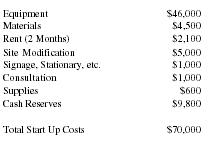
| Equipment | $46,000 |
| Materials | $4,500 |
| Rent (2 Months) | $2,100 |
| Site Modification | $5,000 |
| Signage, Stationary, etc. | $1,000 |
| Consultation | $1,000 |
| Supplies | $600 |
| Cash Reserves | $9,800 |
| Total Start Up Costs | $70,000 |
The compnay is in the process of securing financing for startup. The proprietor currently has $20,000 from private sources and is seeking $50,000 in additional bank loans.
OPERATING COSTS
Two part time employees will be hired to start working on opening day. They will be retained until Labor Day weekend unless strong sales show a further need for them. In the fall, winter and spring, the proprietor and his wife will be the only staff required. Employees will be paid $5.50 per hour, and will work a combined total of 30 hours per week. Wage expenditures will be $707.00 a month with additional payroll taxes running $71.00, for a total expenditure of$778.00.
The Green Lake storefront currently under consideration rents for $1050 a month.
Heat and Electric bills for Jordan Galleria, a downtown storefront of approximately the same dimensions required by Breadcrafter, pays $225.00 at the height of the winter heat season. Taking into account walk in and reach in cooler use, a figure of $350.00 is a reasonable estimated monthly average.
The bread oven will be run four hours per day on busy bake days. Conversations with other bakery owners have indicated that a 4 deck oven consumes $4 of gas per hour, for a total of $343.00 per month at maximum capacity.
A total figure of $725.00 per month is a reasonable estimated monthly average.
Advertising
Breadcrafter will run an advertisement in the Port Hanover News Review during opening week. Another advertisement will run Labor Day weekend. Total advertisement expenditures will run $200 per month. The News Review is known to do spotlight stories on new Port Hanover businesses and Breadcrafter will take advantage of this publicity.
Advertising expenditures will be kept to a minimum in the fall, winter and spring. The company will rely on community service functions, liberal sampling, and word of mouth to reach new customers.
Repair and Maintenance
The estimated maintenance cost for the first month is $500.00. From there it gradually diminishes to $200 a month for the remainder of the year. After the first of the year maintenance estimates are reduced to $100 a month.
A Business Owner's Policy, covering contents, liability, and some loss of income, will cost $400 $500 a year for Breadcrafter, as quoted by Sam Williams of Port Hanover Insurance. Worker's Comp will run $2.25 for every $100 paid. Breadcrafter has budgeted $50 a month in general insurance and $20 a month in Worker's Comp. Health Insurance premiums for the proprietor and his family will run $250 per month.
Taxes and Licenses
The company has budgeted $150 a month on miscellaneous taxes and licenses.
General Supplies
General supplies will consist mainly of bread bags which cost $.05 each for paper and $.03 each for plastic. Bag material, which affects the quality of the crust in storage, will be chosen by the customer. These prices have been included in the cost of sale of each loaf. Cleaning and maintenance supplies will total no more than $50 per month. Breadcrafter has budgeted $125 per month as a conservative figure.
Professional Fees
Professional fees after startup will be kept to a minimum. The proprietor will perform all the necessary filing and bookkeeping chores required except year end tax filing and calculation of depreciation. The company has budgeted $325 in January and
$325 in March to cover these needs.
Miscellaneous
Breadcrafter has budgeted $120 per month to cover miscellaneous expenses.
Proposed Baking Materials Requirements
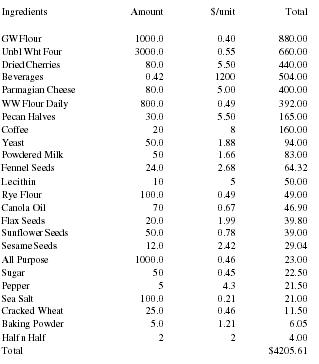
| Ingredients | Amount | $/unit | Total |
| GW Flour | 1000.0 | 0.40 | 880.00 |
| Unbl Wht Four | 3000.0 | 0.55 | 660.00 |
| Dried Cherries | 80.0 | 5.50 | 440.00 |
| Beverages | 0.42 | 1200 | 504.00 |
| Parmagian Cheese | 80.0 | 5.00 | 400.00 |
| WW Flour Daily | 800.0 | 0.49 | 392.00 |
| Pecan Halves | 30.0 | 5.50 | 165.00 |
| Coffee | 20 | 8 | 160.00 |
| Yeast | 50.0 | 1.88 | 94.00 |
| Powdered Milk | 50 | 1.66 | 83.00 |
| Fennel Seeds | 24.0 | 2.68 | 64.32 |
| Lecithin | 10 | 5 | 50.00 |
| Rye Flour | 100.0 | 0.49 | 49.00 |
| Canola Oil | 70 | 0.67 | 46.90 |
| Flax Seeds | 20.0 | 1.99 | 39.80 |
| Sunflower Seeds | 50.0 | 0.78 | 39.00 |
| Sesame Seeds | 12.0 | 2.42 | 29.04 |
| All Purpose | 1000.0 | 0.46 | 23.00 |
| Sugar | 50 | 0.45 | 22.50 |
| Pepper | 5 | 4.3 | 21.50 |
| Sea Salt | 100.0 | 0.21 | 21.00 |
| Cracked Wheat | 25.0 | 0.46 | 11.50 |
| Baking Powder | 5.0 | 1.21 | 6.05 |
| Half n Half | 2 | 2 | 4.00 |
| Total | $4205.61 |
Proposed Equipment Requirements
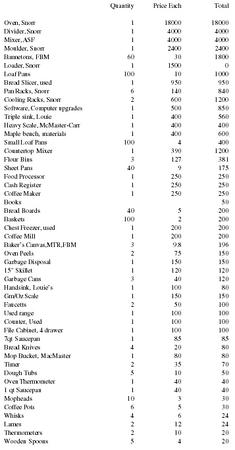
| Quantity | Price Each | Total | |
| Oven, Snorr | 1 | 18000 | 18000 |
| Divider, Snorr | 1 | 4000 | 4000 |
| Mixer, ASF | 1 | 4000 | 4000 |
| Moulder, Snorr | 1 | 2400 | 2400 |
| Bannetons, FBM | 60 | 30 | 1800 |
| Loader, Snorr | 1 | 1500 | 0 |
| Loaf Pans | 100 | 10 | 1000 |
| Bread Slicer, used | 1 | 950 | 950 |
| Pan Racks, Snorr | 6 | 140 | 840 |
| Cooling Racks, Snorr | 2 | 600 | 1200 |
| Software, Computer upgrades | 1 | 500 | 850 |
| Triple sink, Louie | 1 | 400 | 560 |
| Heavy Scale, McMaster-Carr | 1 | 400 | 400 |
| Maple bench, materials | 1 | 400 | 600 |
| Small Loaf Pans | 100 | 4 | 400 |
| Countertop Mixer | 1 | 390 | 1200 |
| Flour Bins | 3 | 127 | 381 |
| Sheet Pans | 40 | 9 | 175 |
| Food Processor | 1 | 250 | 250 |
| Cash Register | 1 | 250 | 250 |
| Coffee Maker | 1 | 250 | 250 |
| Books | 50 | ||
| Bread Boards | 40 | 5 | 200 |
| Baskets | 100 | 2 | 200 |
| Chest Freezer, used | 1 | 200 | 200 |
| Coffee Mill | 1 | 200 | 200 |
| Baker's Canvas,MTR,FBM | 3 | 9.8 | 196 |
| Oven Peels | 2 | 75 | 150 |
| Garbage Disposal | 1 | 150 | 150 |
| 15" Skillet | 1 | 120 | 120 |
| Garbage Cans | 3 | 40 | 120 |
| Handsink, Louie's | 1 | 100 | 80 |
| Gm/Oz Scale | 1 | 150 | 150 |
| Faucetts | 2 | 50 | 100 |
| Used range | 1 | 100 | 100 |
| Counter, Used | 1 | 100 | 100 |
| File Cabinet, 4 drawer | 1 | 100 | 100 |
| 7qt Saucepan | 1 | 85 | 85 |
| Bread Knives | 4 | 20 | 80 |
| Mop Bucket, MacMaster | 1 | 80 | 80 |
| Timer | 2 | 35 | 70 |
| Dough Tubs | 5 | 10 | 50 |
| Oven Thermometer | 1 | 40 | 40 |
| 1 qt Saucepan | 1 | 40 | 40 |
| Mopheads | 10 | 3 | 30 |
| Coffee Pots | 6 | 5 | 30 |
| Whisks | 4 | 6 | 24 |
| Lames | 2 | 12 | 24 |
| Thermometers | 2 | 10 | 20 |
| Wooden Spoons | 5 | 4 | 20 |
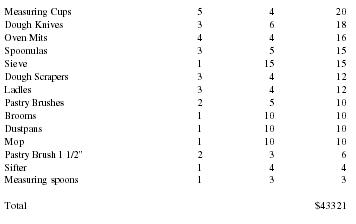
| Measuring Cups | 5 | 4 | 20 |
| Dough Knives | 3 | 6 | 18 |
| Oven Mits | 4 | 4 | 16 |
| Spoonulas | 3 | 5 | 15 |
| Sieve | 1 | 15 | 15 |
| Dough Scrapers | 3 | 4 | 12 |
| Ladles | 3 | 4 | 12 |
| Pastry Brushes | 2 | 5 | 10 |
| Brooms | 1 | 10 | 10 |
| Dustpans | 1 | 10 | 10 |
| Mop | 1 | 10 | 10 |
| Pastry Brush 1 1/2" | 2 | 3 | 6 |
| Sifter | 1 | 4 | 4 |
| Measuring spoons | 1 | 3 | 3 |
| Total | $43321 | ||
Miscellaneous Requirements
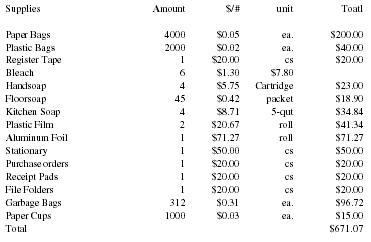
| Supplies | Amount | $/# | unit | Toatl |
| Paper Bags | 4000 | $0.05 | ea. | $200.00 |
| Plastic Bags | 2000 | $0.02 | ea. | $40.00 |
| Register Tape | 1 | $20.00 | cs | $20.00 |
| Bleach | 6 | $1.30 | $7.80 | |
| Handsoap | 4 | $5.75 | Cartridge | $23.00 |
| Floorsoap | 45 | $0.42 | packet | $18.90 |
| Kitchen Soap | 4 | $8.71 | 5-qut | $34.84 |
| Plastic Film | 2 | $20.67 | roll | $41.34 |
| Aluminum Foil | 1 | $71.27 | roll | $71.27 |
| Stationary | 1 | $50.00 | cs | $50.00 |
| Purchase orders | 1 | $20.00 | cs | $20.00 |
| Receipt Pads | 1 | $20.00 | cs | $20.00 |
| File Folders | 1 | $20.00 | cs | $20.00 |
| Garbage Bags | 312 | $0.31 | ea. | $96.72 |
| Paper Cups | 1000 | $0.03 | ea. | $15.00 |
| Total | $671.07 | |||
Bread Cost/Profit Analysis
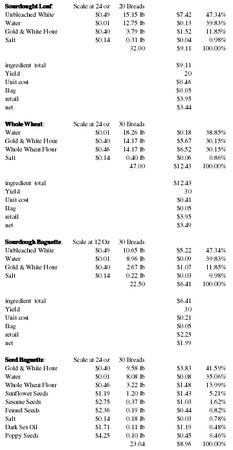
| : | Scale at 24 oz | 20 Breads | ||
| Unbleached White | $0.49 | 15.15 lb | $7.42 | 47.34% |
| Water | $0.01 | 12.75 lb | $0.13 | 39.83% |
| Gold & White Flour | $0.40 | 3.79 lb | $1.52 | 11.85% |
| Salt | $0.14 | 0.31 lb | $0.04 | 0.98% |
| 32.00 | $9.11 | 100.00% | ||
| ingredient total | $9.11 | |||
| Yield | 20 | |||
| Unit cost | $0.46 | |||
| Bag | $0.05 | |||
| retail | $3.95 | |||
| net | $3.44 | |||
| : | Scale at 24 oz | 30 Breads | ||
| Water | $0.01 | 18.26 lb | $0.18 | 38.85% |
| Gold & White Flour | $0.40 | 14.17 lb | $5.67 | 30.15% |
| Whole Wheat Flour | $0.46 | 14.17 lb | $6.52 | 30.15% |
| Salt | $0.14 | 0.40 lb | $0.06 | 0.86% |
| 47.00 | $12.43 | 100.00% | ||
| ingredient total | $12.43 | |||
| Yield | 30 | |||
| Unit cost | $0.41 | |||
| Bag | $0.05 | |||
| retail | $3.95 | |||
| net | $3.49 | |||
| : | Scale at 12 Oz | 30 Breads | ||
| Unbleached White | $0.49 | 10.65 lb | $5.22 | 47.34% |
| Water | $0.01 | 8.96 lb | $0.09 | 39.83% |
| Gold & White Flour | $0.40 | 2.67 lb | $1.07 | 11.85% |
| Salt | $0.14 | 0.22 lb | $0.03 | 0.98% |
| 22.50 | $6.41 | 100.00% | ||
| ingredient total | $6.41 | |||
| Yield | 30 | |||
| Unit cost | $0.21 | |||
| Bag | $0.05 | |||
| retail | $2.25 | |||
| net | $1.99 | |||
| : | Scale at 24 oz | 30 Breads | ||
| Gold & White Flour | $0.40 | 9.58 lb | $3.83 | 41.59% |
| Water | $0.01 | 8.08 lb | $0.08 | 35.06% |
| Whole Wheat Flour | $0.46 | 3.22 lb | $1.48 | 13.99% |
| Sunflower Seeds | $1.19 | 1.20 lb | $1.43 | 5.21% |
| Sesame Seeds | $2.75 | 0.37 lb | $1.03 | 1.62% |
| Fennel Seeds | $2.36 | 0.19 lb | $0.44 | 0.82% |
| Salt | $0.14 | 0.18 lb | $0.03 | 0.78% |
| Dark Ses Oil | $1.71 | 0.11 lb | $1.19 | 0.48% |
| Poppy Seeds | $4.25 | 0.10 lb | $0.45 | 0.46% |
| 23.04 | $8.96 | 100.00% | ||
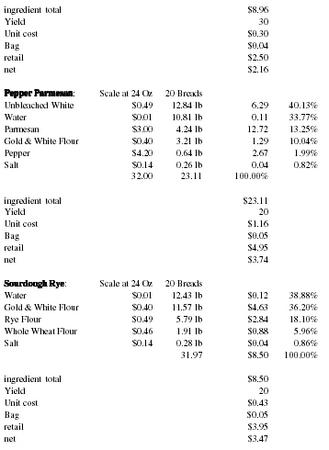
| ingredient total | $8.96 | |||
| Yield | 30 | |||
| Unit cost | $0.30 | |||
| Bag | $0.04 | |||
| retail | $2.50 | |||
| net | $2.16 | |||
| : | Scale at 24 Oz | 20 Breads | ||
| Unbleached White | $0.49 | 12.84 lb | 6.29 | 40.13% |
| Water | $0.01 | 10.81 lb | 0.11 | 33.77% |
| Parmesan | $3.00 | 4.24 lb | 12.72 | 13.25% |
| Gold & White Flour | $0.40 | 3.21 lb | 1.29 | 10.04% |
| Pepper | $4.20 | 0.64 lb | 2.67 | 1.99% |
| Salt | $0.14 | 0.26 lb | 0.04 | 0.82% |
| 32.00 | 23.11 | 100.00% | ||
| ingredient total | $23.11 | |||
| Yield | 20 | |||
| Unit cost | $1.16 | |||
| Bag | $0.05 | |||
| retail | $4.95 | |||
| net | $3.74 | |||
| : | Scale at 24 Oz | 20 Breads | ||
| Water | $0.01 | 12.43 lb | $0.12 | 38.88% |
| Gold & White Flour | $0.40 | 11.57 lb | $4.63 | 36.20% |
| Rye Flour | $0.49 | 5.79 lb | $2.84 | 18.10% |
| Whole Wheat Flour | $0.46 | 1.91 lb | $0.88 | 5.96% |
| Salt | $0.14 | 0.28 lb | $0.04 | 0.86% |
| 31.97 | $8.50 | 100.00% | ||
| ingredient total | $8.50 | |||
| Yield | 20 | |||
| Unit cost | $0.43 | |||
| Bag | $0.05 | |||
| retail | $3.95 | |||
| net | $3.47 | |||
Beverage Cost/Profit Analysis
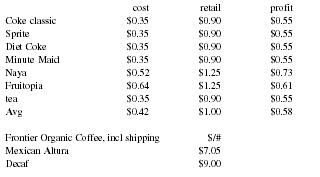
| cost | retail | profit | |
| Coke classic | $0.35 | $0.90 | $0.55 |
| Sprite | $0.35 | $0.90 | $0.55 |
| Diet Coke | $0.35 | $0.90 | $0.55 |
| Minute Maid | $0.35 | $0.90 | $0.55 |
| Naya | $0.52 | $1.25 | $0.73 |
| Fruitopia | $0.64 | $1.25 | $0.61 |
| tea | $0.35 | $0.90 | $0.55 |
| Avg | $0.42 | $1.00 | $0.58 |
| Frontier Organic Coffee, incl shipping | $/# | ||
| Mexican Altura | $7.05 | ||
| Decaf | $9.00 | ||
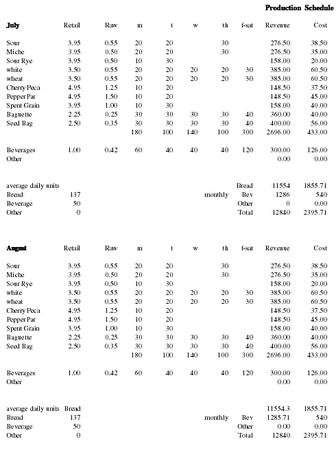
| Retail | Raw | m | t | w | th | f-sat | Revenue | Cost | |
| Sour | 3.95 | 0.55 | 20 | 20 | 30 | 276.50 | 38.50 | ||
| Miche | 3.95 | 0.50 | 20 | 20 | 30 | 276.50 | 35.00 | ||
| Sour Rye | 3.95 | 0.50 | 10 | 30 | 158.00 | 20.00 | |||
| white | 3.50 | 0.55 | 20 | 20 | 20 | 20 | 30 | 385.00 | 60.50 |
| wheat | 3.50 | 0.55 | 20 | 20 | 20 | 20 | 30 | 385.00 | 60.50 |
| Cherry Peca | 4.95 | 1.25 | 10 | 20 | 148.50 | 37.50 | |||
| Pepper Par | 4.95 | 1.50 | 10 | 20 | 148.50 | 45.00 | |||
| Spent Grain | 3.95 | 1.00 | 10 | 30 | 158.00 | 40.00 | |||
| Baguette | 2.25 | 0.25 | 30 | 30 | 30 | 30 | 40 | 360.00 | 40.00 |
| Seed Bag | 2.50 | 0.35 | 30 | 30 | 30 | 30 | 40 | 400.00 | 56.00 |
| 180 | 100 | 140 | 100 | 300 | 2696.00 | 433.00 | |||
| Beverages | 1.00 | 0.42 | 60 | 40 | 40 | 40 | 120 | 300.00 | 126.00 |
| Other | 0.00 | 0.00 | |||||||
| average daily units | Bread | 11554 | 1855.71 | ||||||
| Bread | 137 | monthly | Bev | 1286 | 540 | ||||
| Beverage | 50 | Other | 0 | 0.00 | |||||
| Other | 0 | Total | 12840 | 2395.71 | |||||
| Retail | Raw | m | t | w | th | f-sat | Revenue | Cost | |
| Sour | 3.95 | 0.55 | 20 | 20 | 30 | 276.50 | 38.50 | ||
| Miche | 3.95 | 0.50 | 20 | 20 | 30 | 276.50 | 35.00 | ||
| Sour Rye | 3.95 | 0.50 | 10 | 30 | 158.00 | 20.00 | |||
| white | 3.50 | 0.55 | 20 | 20 | 20 | 20 | 30 | 385.00 | 60.50 |
| wheat | 3.50 | 0.55 | 20 | 20 | 20 | 20 | 30 | 385.00 | 60.50 |
| Cherry Peca | 4.95 | 1.25 | 10 | 20 | 148.50 | 37.50 | |||
| Pepper Par | 4.95 | 1.50 | 10 | 20 | 148.50 | 45.00 | |||
| Spent Grain | 3.95 | 1.00 | 10 | 30 | 158.00 | 40.00 | |||
| Baguette | 2.25 | 0.25 | 30 | 30 | 30 | 30 | 40 | 360.00 | 40.00 |
| Seed Bag | 2.50 | 0.35 | 30 | 30 | 30 | 30 | 40 | 400.00 | 56.00 |
| 180 | 100 | 140 | 100 | 300 | 2696.00 | 433.00 | |||
| Beverages | 1.00 | 0.42 | 60 | 40 | 40 | 40 | 120 | 300.00 | 126.00 |
| Other | 0.00 | 0.00 | |||||||
| average daily units | Bread | 11554.3 | 1855.71 | ||||||
| Bread | 137 | monthly | Bev | 1285.71 | 540 | ||||
| Beverage | 50 | Other | 0.00 | 0.00 | |||||
| Other | 0 | Total | 12840 | 2395.71 | |||||
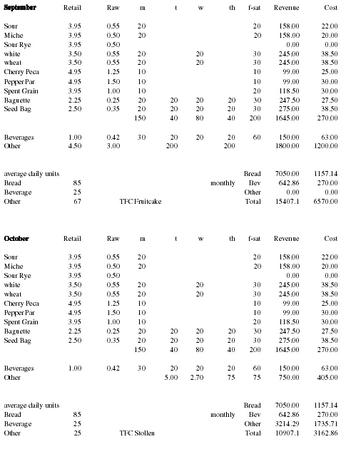
| Retail | Raw | m | t | w | th | f-sat | Revenue | Cost | |
| Sour | 3.95 | 0.55 | 20 | 20 | 158.00 | 22.00 | |||
| Miche | 3.95 | 0.50 | 20 | 20 | 158.00 | 20.00 | |||
| Sour Rye | 3.95 | 0.50 | 0.00 | 0.00 | |||||
| white | 3.50 | 0.55 | 20 | 20 | 30 | 245.00 | 38.50 | ||
| wheat | 3.50 | 0.55 | 20 | 20 | 30 | 245.00 | 38.50 | ||
| Cherry Peca | 4.95 | 1.25 | 10 | 10 | 99.00 | 25.00 | |||
| Pepper Par | 4.95 | 1.50 | 10 | 10 | 99.00 | 30.00 | |||
| Spent Grain | 3.95 | 1.00 | 10 | 20 | 118.50 | 30.00 | |||
| Baguette | 2.25 | 0.25 | 20 | 20 | 20 | 20 | 30 | 247.50 | 27.50 |
| Seed Bag | 2.50 | 0.35 | 20 | 20 | 20 | 20 | 30 | 275.00 | 38.50 |
| 150 | 40 | 80 | 40 | 200 | 1645.00 | 270.00 | |||
| Beverages | 1.00 | 0.42 | 30 | 20 | 20 | 20 | 60 | 150.00 | 63.00 |
| Other | 4.50 | 3.00 | 200 | 200 | 1800.00 | 1200.00 | |||
| average daily units | Bread | 7050.00 | 1157.14 | ||||||
| Bread | 85 | monthly | Bev | 642.86 | 270.00 | ||||
| Beverage | 25 | Other | 0.00 | 0.00 | |||||
| Other | 67 | TFC Fruitcake | Total | 15407.1 | 6570.00 | ||||
| Retail | Raw | m | t | w | th | f-sat | Revenue | Cost | |
| Sour | 3.95 | 0.55 | 20 | 20 | 158.00 | 22.00 | |||
| Miche | 3.95 | 0.50 | 20 | 20 | 158.00 | 20.00 | |||
| Sour Rye | 3.95 | 0.50 | 0.00 | 0.00 | |||||
| white | 3.50 | 0.55 | 20 | 20 | 30 | 245.00 | 38.50 | ||
| wheat | 3.50 | 0.55 | 20 | 20 | 30 | 245.00 | 38.50 | ||
| Cherry Peca | 4.95 | 1.25 | 10 | 10 | 99.00 | 25.00 | |||
| Pepper Par | 4.95 | 1.50 | 10 | 10 | 99.00 | 30.00 | |||
| Spent Grain | 3.95 | 1.00 | 10 | 20 | 118.50 | 30.00 | |||
| Baguette | 2.25 | 0.25 | 20 | 20 | 20 | 20 | 30 | 247.50 | 27.50 |
| Seed Bag | 2.50 | 0.35 | 20 | 20 | 20 | 20 | 30 | 275.00 | 38.50 |
| 150 | 40 | 80 | 40 | 200 | 1645.00 | 270.00 | |||
| Beverages | 1.00 | 0.42 | 30 | 20 | 20 | 20 | 60 | 150.00 | 63.00 |
| Other | 5.00 | 2.70 | 75 | 75 | 750.00 | 405.00 | |||
| average daily units | Bread | 7050.00 | 1157.14 | ||||||
| Bread | 85 | monthly | Bev | 642.86 | 270.00 | ||||
| Beverage | 25 | Other | 3214.29 | 1735.71 | |||||
| Other | 25 | TFC Stollen | Total | 10907.1 | 3162.86 | ||||
User Contributions:
Comment about this article, ask questions, or add new information about this topic:.
Bakery Business Plan Template
Written by Dave Lavinsky
Business Plan Outline
- Bakery Business Plan Home
- 1. Executive Summary
- 2. Company Overview
- 3. Industry Analysis
- 4. Customer Analysis
- 5. Competitive Analysis
- 6. Marketing Plan
- 7. Operations Plan
- 8. Management Team
- 9. Financial Plan
Bakery Business Plan
You’ve come to the right place to create a successful bakery business plan.
We have helped over 100,000 entrepreneurs and business owners create business plans and many have used them to start or grow their bakeries.
A bakery business plan is a plan to start and/or grow your bakery. Among other things, it outlines your business concept, identifies your target customers, presents your marketing strategy, and details your financial projections.
Sample Bakery Business Plan
The following information will provide a description of what to include in your own bakery business plan along with links to an example for that section:
- Executive Summary – The Executive Summary section provides a high-level overview of your plan. It should include your bakery’s mission statement, as well as information on your business offerings, your target audience, and your business goals and objectives.
- Company Overview – The Company Overview section provides an in-depth look at your bakery, including information on your company’s history, business structure, bakery location, and management team.
- Industry Analysis – Also called the Market Analysis, in this section, you will provide an overview of the industry in which your bakery will operate. Through market research, you will be able to discuss market trends affecting the industry, as well as your target market’s needs and buying habits.
- Customer Analysis – In this section, you will describe your target market and explain how you intend to reach them. You will also provide information on your customers’ needs and buying habits.
- Competitive Analysis – The Competitor Analysis will provide an overview of your competition (other bakeries or businesses that offer high-quality baked goods), including their strengths and weaknesses. It will also discuss your competitive advantage or your business’s core strength that will help you stand out amongst your competition.
- Marketing Plan – In the Marketing Plan section, you will detail your marketing strategies, including your community events, and digital marketing campaigns. You will also discuss your pricing strategy and how you intend to position your bakery in the market.
- Operations Plan – In the Operations Plan, you will provide an overview of your store’s operations, including your store layout, staff, and inventory management. It also includes information on your warehousing and distribution arrangements and a list of long-term milestones or business goals.
- Management Team – In this section, you will provide information on yourself as the talented baker, any business partners, your experience, and your roles in the company.
- Financial Plan – In this section of your bakery financial plan, you will include your financial statements: profit and loss statement, balance sheet, and cash flow statement. It also includes information on how much funding you require and the use of these funds.
Next Section: Executive Summary >
Bakery Business Plan FAQs
How can i complete my bakery business plan quickly & easily.
Learn more about how to write a bakery business plan using this bakery business plan template .
What Are the Main Types of Bakeries?
A bakery can be retail or wholesale. A retail bakery sells baked goods (i.e., fresh bread, specialty items, gluten-free and vegan baked goods, and other bakery offerings) directly to customers, while a wholesale bakery typically sells products to other local businesses, like restaurants, grocery stores, specialty shops, and cafes.
How Do You Get Funding for Your Bakery?
Bakeries are most commonly funded with personal savings and bank loans. Credit card financing and angel investors are also popular forms of funding for bakeries. Potential investors or lenders will often want to see a well-crafted business plan before considering providing funding.
Learn More: Seeking Funding from Angel Investors vs Venture Capitalists
Where Can I Get a Bakery Business Plan PDF?
You can download our free bakery business plan template PDF here . This is a sample bakery business plan template you can use in PDF format.

Bakery Business Plan PDF Example
- February 28, 2024
- Business Plan
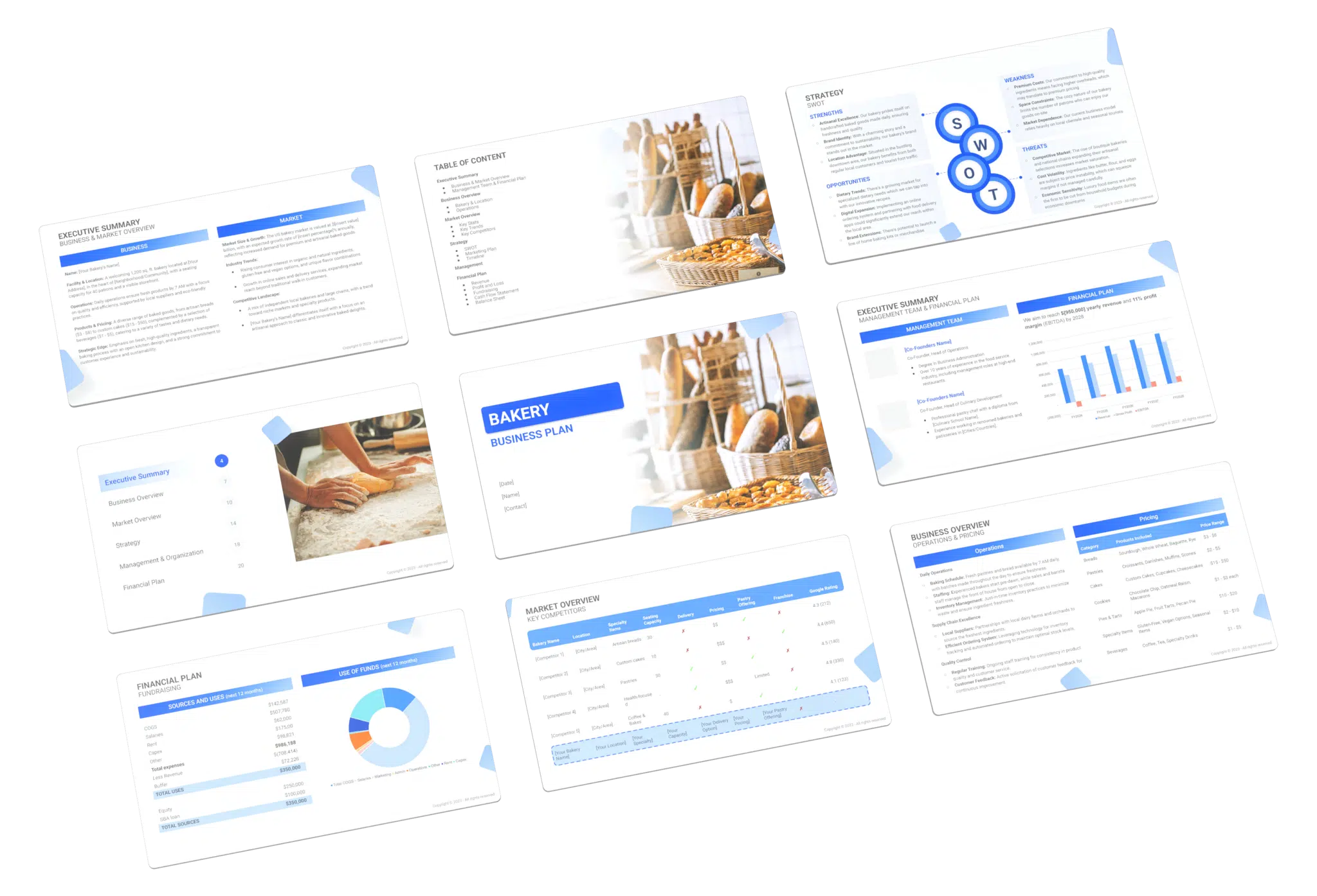
Creating a comprehensive business plan is crucial for launching and running a successful bakery. This plan serves as your roadmap, detailing your vision, operational strategies, and financial plan. It helps establish your therapy bakery’s identity, navigate the competitive market, and secure funding for growth.
This article not only breaks down the critical components of a bakery business plan, but also provides an example of a business plan to help you craft your own.
Whether you’re an experienced entrepreneur or new to the food&beverage industry, this guide, complete with a business plan example, lays the groundwork for turning your bakery concept into reality. Let’s dive in!
Our bakery business plan is designed to encompass all crucial elements required for a thorough strategic approach. It details the bakery’s operations, marketing strategy , market environment, competitors, management team, and financial projections, ensuring a holistic view of the business’s path to success.
- Executive Summary : Offers an overview of your bakery’s business idea, market research , management team, and financial plans.
- Bakery & Location: Describes your bakery’s layout, features, and why its location is perfect for customers.
- Operations: Outlines daily bakery operations, including baking schedules, staffing, and ingredient sourcing.
- Key Stats: Provides figures on the size and growth of the bakery market.
- Key Trends: Points out new trends in the bakery industry, such as the rise in health-conscious and specialty products.
- Key Competitors : Discusses major nearby bakeries and how your bakery offers something different.
- SWOT: Analyzes strengths, weaknesses, opportunities, and threats related to your bakery.
- Marketing Plan : Outlines methods for promoting your bakery and keeping customers coming back.
- Timeline : Lists important goals and milestones from the beginning through the first year.
- Management: Shares info on who runs the bakery and their responsibilities.
- Financial Plan: Forecasts the bakery’s financial outlook over 5 years, including income, profit margins, and main expenses.

Bakery Business Plan

Fully editable 30+ slides Powerpoint presentation business plan template.
Download an expert-built 30+ slides Powerpoint business plan template
Executive Summary
The Executive Summary introduces your bakery’s business plan, offering a concise overview of your bakery and its offerings. It should detail your market positioning, the range of baked goods and confectionery items you offer, its location, size, and an outline of day-to-day operations.
This section should also explore how your bakery will integrate into the local market, including the number of direct competitors within the area, identifying who they are, along with your bakery’s unique selling points that differentiate it from these competitors. These could include special dietary options like gluten-free or vegan products, artisanal or locally sourced ingredients, or a particular specialty in certain types of baked goods.
Furthermore, you should include information about the management and co-founding team, detailing their roles and contributions to the bakery’s success. This could involve their culinary expertise, business management experience, or community relations. Additionally, a summary of your financial projections, including revenue and profits over the next five years, should be presented here to provide a clear picture of your bakery’s financial plan.
Make sure to cover here _ Business Overview _ Market Overview _ Management Team _ Financial Plan
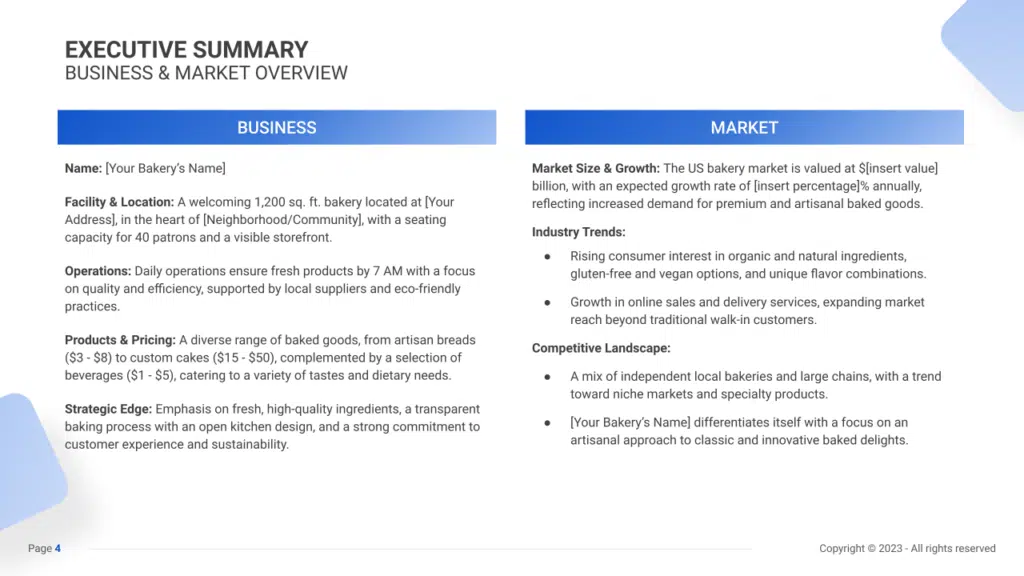
Dive deeper into Executive Summary
Business Overview
For a Bakery, the Business Overview section can be concisely divided into 2 main slides:
Bakery & Location
Briefly describe the bakery’s physical environment, emphasizing its design, warmth, and the inviting atmosphere that welcomes customers. Mention the bakery’s location, highlighting its accessibility and the convenience it offers to customers, such as proximity to community centers, schools, or ease of parking.
Explain why this location is advantageous in attracting your target clientele, which might include local residents, businesses looking for catering options, or foot traffic from nearby shopping areas.
Detail the range of baked goods and products offered, from bread and pastries to custom cakes and specialty items. Outline your operational strategy, including sourcing of ingredients, baking schedules to ensure freshness, and any unique services such as custom orders or catering.
Discuss your pricing strategy , ensuring it reflects the quality of ingredients and craftsmanship involved and matches the market you’re targeting. Highlight any special offerings, loyalty programs, or community events that provide added value to your customers, encouraging repeat visits and customer loyalty.
Make sure to cover here _ Bakery & Location _ Operations
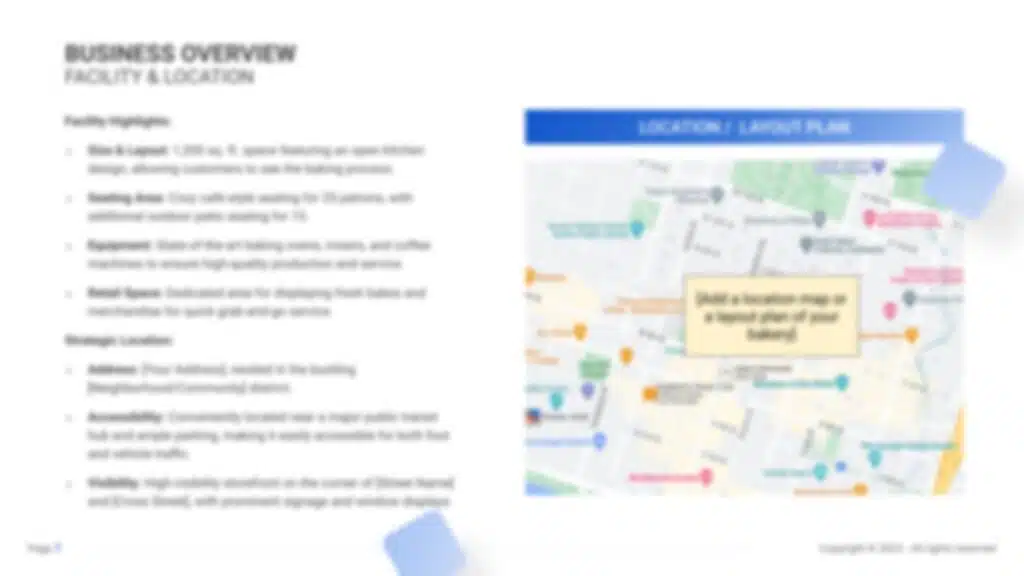
Market Overview
Industry size & growth.
In the Market Overview of your bakery business plan, begin by assessing the size of the bakery industry and its potential for growth. This evaluation is essential for grasping the market’s extent and pinpointing opportunities for expansion.
Analyze factors such as the increasing demand for baked goods, both traditional and innovative, and how consumer preferences are shaping the industry.
Key market trends
Continue by discussing recent market trends that are influencing consumer behavior and preferences in the bakery sector. This might include a growing interest in artisanal and craft baked products, the surge in popularity of gluten-free and vegan options, and the integration of international flavors and ingredients into traditional bakery products.
Highlight the demand for high-quality, fresh, and specialty baked goods that cater to diverse dietary needs and cultural tastes, as well as the trend towards more health-conscious and sustainable baking practices.
Key competitors
Next, examine the competitive landscape, which encompasses a variety of bakeries from luxury patisseries to affordable local bakeries, as well as the rise of home baking and online bakery businesses.
Focus on what sets your bakery apart, whether it’s through unparalleled customer service, a distinctive selection of baked goods, or expertise in a particular baking style or dietary niche.
Make sure to cover here _ Industry size & growth _ Key competitors _ Key market trends

Dive deeper into Key competitors
First, conduct a SWOT analysis for the bakery , highlighting Strengths (such as artisanal baking skills and a unique range of products), Weaknesses (including potentially high ingredient costs or stiff competition), Opportunities (for example, a growing interest in specialty and health-conscious baked goods), and Threats (such as fluctuations in raw material prices or changes in consumer spending due to economic conditions).
Marketing Plan
Next, formulate a marketing plan that details strategies for attracting and retaining customers through targeted advertising, seasonal promotions, a compelling social media presence, and engagement with the local community. Consider loyalty programs, baking workshops, and collaborations with local businesses as part of your promotional activities.
Finally, establish a detailed timeline that marks key milestones for the bakery’s launch, marketing initiatives, customer base development, and potential expansion goals. This timeline should guide the business towards achieving its objectives with precision and clarity, ensuring systematic progress in a competitive market.
Make sure to cover here _ SWOT _ Marketing Plan _ Timeline

Dive deeper into SWOT
Dive deeper into Marketing Plan
The Management section focuses on the bakery’s management and their direct roles in daily operations and strategic direction. This part is crucial for understanding who is responsible for making key decisions and driving the bakery towards its financial and operational goals.
For your bakery business plan, list the core team members, their specific responsibilities, and how their expertise supports the business.
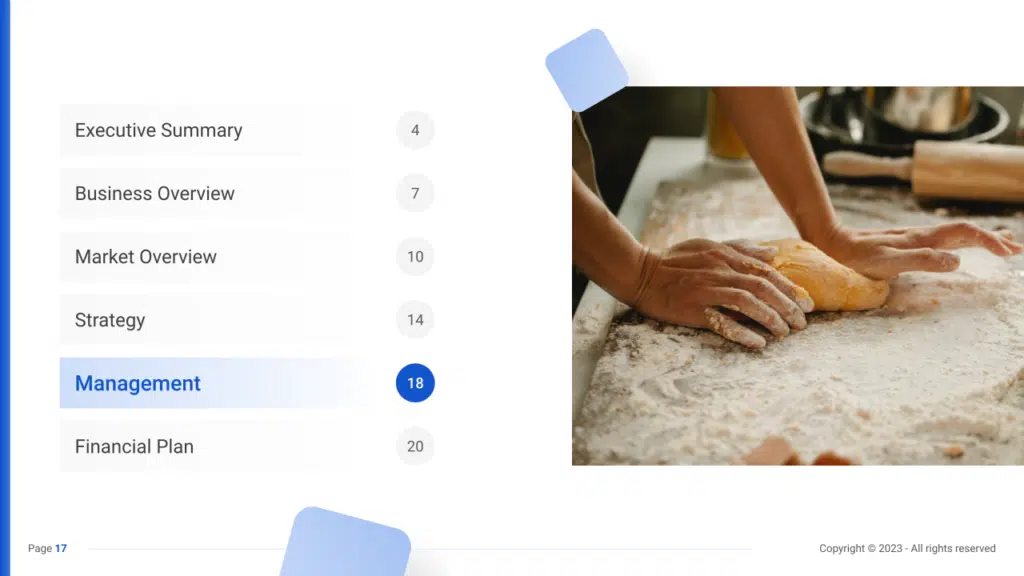
Financial Plan
The Financial Plan section is a comprehensive analysis of your financial projections for revenue, expenses, and profitability. It lays out your bakery’s approach to securing funding, managing cash flow, and achieving breakeven.
This section typically includes detailed forecasts for the first 5 years of operation, highlighting expected revenue, operating costs and capital expenditures.
For your bakery business plan, provide a snapshot of your financial statement (profit and loss, balance sheet, cash flow statement), as well as your key assumptions (e.g. number of customers and prices, expenses, etc.).
Make sure to cover here _ Profit and Loss _ Cash Flow Statement _ Balance Sheet _ Use of Funds
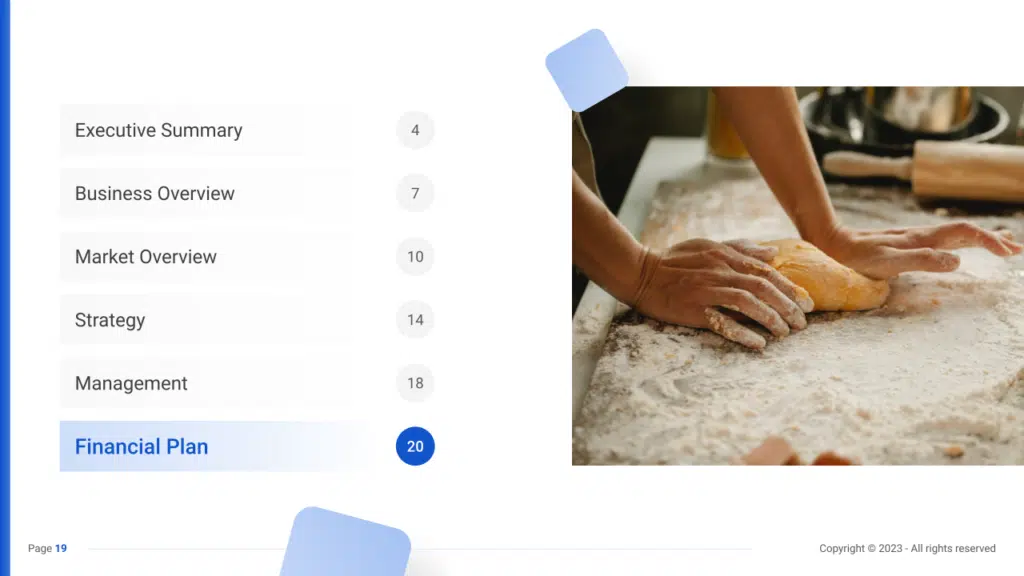
Related Posts

Steakhouse Business Plan PDF Example
- May 10, 2024

Executive Summary of a Steakhouse: Template & Example
- May 6, 2024
- Business Plan , Executive Summary

Bubble Tea Business Plan PDF Example
- March 19, 2024
Privacy Overview
| Cookie | Duration | Description |
|---|---|---|
| BIGipServerwww_ou_edu_cms_servers | session | This cookie is associated with a computer network load balancer by the website host to ensure requests are routed to the correct endpoint and required sessions are managed. |
| cookielawinfo-checkbox-advertisement | 1 year | Set by the GDPR Cookie Consent plugin, this cookie is used to record the user consent for the cookies in the "Advertisement" category . |
| cookielawinfo-checkbox-analytics | 11 months | This cookie is set by GDPR Cookie Consent plugin. The cookie is used to store the user consent for the cookies in the category "Analytics". |
| cookielawinfo-checkbox-functional | 11 months | The cookie is set by GDPR cookie consent to record the user consent for the cookies in the category "Functional". |
| cookielawinfo-checkbox-necessary | 11 months | This cookie is set by GDPR Cookie Consent plugin. The cookies is used to store the user consent for the cookies in the category "Necessary". |
| cookielawinfo-checkbox-others | 11 months | This cookie is set by GDPR Cookie Consent plugin. The cookie is used to store the user consent for the cookies in the category "Other. |
| cookielawinfo-checkbox-performance | 11 months | This cookie is set by GDPR Cookie Consent plugin. The cookie is used to store the user consent for the cookies in the category "Performance". |
| CookieLawInfoConsent | 1 year | Records the default button state of the corresponding category & the status of CCPA. It works only in coordination with the primary cookie. |
| elementor | never | This cookie is used by the website's WordPress theme. It allows the website owner to implement or change the website's content in real-time. |
| viewed_cookie_policy | 11 months | The cookie is set by the GDPR Cookie Consent plugin and is used to store whether or not user has consented to the use of cookies. It does not store any personal data. |
| Cookie | Duration | Description |
|---|---|---|
| __cf_bm | 30 minutes | This cookie, set by Cloudflare, is used to support Cloudflare Bot Management. |
| language | session | This cookie is used to store the language preference of the user. |
| Cookie | Duration | Description |
|---|---|---|
| _ga | 2 years | The _ga cookie, installed by Google Analytics, calculates visitor, session and campaign data and also keeps track of site usage for the site's analytics report. The cookie stores information anonymously and assigns a randomly generated number to recognize unique visitors. |
| _ga_QP2X5FY328 | 2 years | This cookie is installed by Google Analytics. |
| _gat_UA-189374473-1 | 1 minute | A variation of the _gat cookie set by Google Analytics and Google Tag Manager to allow website owners to track visitor behaviour and measure site performance. The pattern element in the name contains the unique identity number of the account or website it relates to. |
| _gid | 1 day | Installed by Google Analytics, _gid cookie stores information on how visitors use a website, while also creating an analytics report of the website's performance. Some of the data that are collected include the number of visitors, their source, and the pages they visit anonymously. |
| browser_id | 5 years | This cookie is used for identifying the visitor browser on re-visit to the website. |
| WMF-Last-Access | 1 month 18 hours 11 minutes | This cookie is used to calculate unique devices accessing the website. |

How to Start a Bread Business
Are you an experienced baker with a passion for bread making? Or maybe you’re looking for a new business venture and think starting a bread business could be the perfect opportunity.
Whatever your reasons, if you’re thinking about starting a bread business, then this article is for you. We will discuss starting a bread business, from creating a business plan to finding the perfect location for your bakery.
Ten Steps to Launching a New Bread Business
1. choose your type of bread business.
The first step in launching a bread business is to identify the type of business you want to launch. For example, you might choose from the following types, among others.
Home-based bread business
A home-based bread business is an ideal option if you have limited resources and are only looking to sell your products locally.
Brick-and-mortar bakery
A brick-and-mortar bakery will require more start-up costs than a home-based business, but it will also allow you to reach a broader customer base.
Mobile bakery
A mobile bakery is an excellent option if you want the flexibility to sell your products at different locations.
2. Name Your Bread Business
Give your bread business an identity so people will consider it a well-known and respected brand. You can take the name of your bread business from your industry, focus on a geographical location, or use your own name among other options.
The main goal for naming your bread business is to make it sound appealing and trustworthy so customers will be more likely to buy your bread.
3. Determine Your Bread Business Model
There are several possible types of business models for a bread business, including franchise, wholesale, and retailer.
- A franchise: A franchise is a type of business model where you buy into an already established brand. This option can be helpful if you don’t have the time or resources to start a bread business from scratch.
- A wholesaler: A wholesaler sells products in bulk to retailers who then sell the products to customers. This business model can be helpful if you want to sell your bread products to a wide range of businesses.
- A retailer: A retailer sells products directly to customers. This type of business model can be helpful if you have a brick-and-mortar location or are selling online.
No matter which model you choose, ensure that it aligns with your business goals and the products you offer.
4. Choose a Legal Form for Your Business
Incorporating your bread business will limit your liability. You can incorporate as a Limited Liability Company (LLC), a C Corporation (C-Corp), or an S Corporation (S-Corp). Or you can operate as a sole proprietorship.
The business structure you choose for your bread business will determine the taxes you pay and which state or federal tax forms you need to file.
Read our article comparing the most common bread business structures .
5. Write a Bread Business Plan
All bread business owners should develop a business plan.
A business plan is a document that outlines the goals, strategies, and operations of a business. It can be used to secure funding from investors or lenders, as well as to guide the day-to-day operations of the business. The business plan should include information on the company’s products or services, market analysis, financial projections, and management team.
Read our article about how to write a bread business plan .
6. Apply for the Necessary Permits and Licenses
There may be required licenses and permits you need to obtain before launching your bread business.
For example, you may need a food handler’s permit or license if you are handling and preparing food.
You will also need to register your business with the government and obtain a business license. The process for obtaining permits and licenses varies by state, so check with your local government for specific requirements in your area.
Read our article about obtaining the proper bread business licenses .
7. Determine Your Budget & Apply for Funding as Needed
In developing your bread business plan, you will figure out how much funding you need to start and grow your business.
If you have funds to invest in your bread business, consider taking advantage of that. In addition to your personal funds, other forms of potential funding for your bread business include traditional bank loans, SBA loans, credit cards, angel investors and family and friends.
Read our article about the costs associated with starting a bread business to help you determine if funding is needed.
8. Get the Technology & Software Needed to Run Your Business Efficiently
When you start your bread business, it’s essential to have the right technology in place to maximize efficiency. You definitely need a computer with Internet access, and accounting software for tracking expenses and revenues.
You may also want to invest in point-of-sale (POS) software to streamline transactions at your bread business. If you plan on selling online, you’ll need a shopping cart and payment gateway for your website.
9. Market Your Bread Business to Potential Customers
Before selling your products, you must let the world know you exist. The first step is to create a website so people can learn more about your products and how they benefit them.
After you launch your website, start promoting it through social media channels like Facebook, LinkedIn and Twitter. Also consider networking with other people in the bread industry through social media and blogs so they can help share your business.
You also need to start gathering the materials needed to execute on your promotions strategy, which is your strategy for attracting new customers. Bread businesses should consider the following promotional strategies for which you should start getting prepared:
- Print advertisements in local publications
- Radio or television commercials
- Online advertising, including Google AdWords and banner ads on websites
- Direct mail campaigns
- Coupons or discounts
- PR and publicity campaigns
Read our article about how to market your bread business for more tips.
10. Get New Customers & Grow Your Business
When you promote your products , you’ll start to get interest from potential customers .
Make sure you’re ready to serve these customers . Also, be sure to establish systems to ensure consistency and reduce costs. And be sure to find and train the right people to help you grow your bread business.
Read our article about how to grow your bread business effectively to learn more.
Starting a Bread Business FAQs
Why start a bread business.
Bread is a staple food in many cultures worldwide, making it a great business opportunity. Not only is there always demand for bread, but there are also many different types of breads that you can produce, giving you the potential to cater to a wide range of customers.
What is Needed to Start a Successful Bread Business?
You need to do several things to start a successful bread business. First, you need to develop a strong business plan. This will help you map out the steps you need to take to achieve your goals. Second, you need to secure the proper funding for your business. This may include personal funds, loans, or investments from family and friends. Third, you need to find the right location for your business. This should be a place that is easily accessible to potential customers.
How Can I Start a Bread Business From Home?
Starting a bread business from home is a great way to get started with limited resources. However, there are a few things you need to keep in mind. First, you need to make sure you have the proper permits and licenses for running a business from your home. Second, you need to create a dedicated space for your business so you can keep your work and home life separate. Finally, you need to invest in the proper equipment, such as a baking oven and mixer. With these things in mind, you can start your bread business from home with ease.
How Can I Start a Bread Business Online?
Starting a bread business online is a great way to reach a wider audience. To get started, you need to create a website for your business. This will allow potential customers to learn more about your products and how they can benefit from them. Once your website is up and running, you need to start promoting it through social media channels and online advertising. With a little effort, you can reach a large number of potential customers online and grow your bread business.
What are Some Tips for Starting a Bread Business?
There are a few tips you should keep in mind when starting a bread business. First, you need to make sure you have a strong business plan. This will help you map out the steps you need to achieve your goals. Second, you need to secure the proper funding for your business. This may include personal funds, loans, or investments from family and friends.
Where Can I Find a Simple Checklist for Starting a Bread Business?
A simple checklist to use when starting a bread business is as follows:
- Choose Your Type of Bread Business : This should be based on what you are best at and how much experience you have. Remember to keep your interests, skills, and experience in mind at all times.
- Name Your Bread Business: This should be done with care, as your brand is important for attracting the right customers. A simple, memorable name will go a long way.
- Choose a Legal Form for Your Business: Whether you choose to become a sole proprietorship, partnership, LLC, corporation or another option will depend on your business. Ensure that you are aware of all the implications of each type.
- Determine Your Bread Business Model: Determine how your business will make money. Will you sell products, services, or a combination of both?
- Write a Bread Business Plan: Your business plan will also help you determine what your start-up costs will be and will provide a roadmap with which you can launch and grow .
- Apply for the Necessary Permits and Licenses: In most locations you will be required to apply for a business license and/or permits before you can begin operations.
- Determine Your Budget & Apply for Funding as Needed: You will need to know how much money you have to spend on all of your business-related expenses before opening any doors. If needed, apply for a small business loan or other funding options.
- Get the Technology & Software Needed to Run Your Business Efficiently: You need the right tools to succeed. Implement software that will help you manage your time, contacts, and business operations in general.
- Market Your Bread Business to Potential Customers : A solid marketing plan will be crucial to your success. It should focus on attracting the right customers so that you can provide them with the products they truly need.
- Get Customers & Grow Your Business: Once you have a solid marketing plan, it's time to actively pursue and secure those who could benefit the most from your products .
Start a Successful Bread Business
Starting a bread business can be a rewarding and challenging endeavor. With the right planning, you can set your business up for success. Keep in mind that you will need to invest time and money into your business, but if you are passionate about baking bread, it can be a very rewarding experience. Use the tips outlined in this article to help you get started on the right foot.
BUSINESS STRATEGIES
How to create a bakery business plan
- Annabelle Amery
- Oct 29, 2023
- 12 min read

When launching your bakery business , the first step is to whip up a detailed and well-crafted business plan. Think of it as the secret recipe for your bakery's success. This document isn't just a list of ingredients; it's your roadmap to achieving your goals, whether you're baking artisanal bread, delightful pastries or delectable cakes. Your bakery business plan will help you navigate the sweet and savory challenges of the industry, ensuring your path to success is as delightful as your treats.
So if you're looking to start a business in the baking industry, keep reading for instructions on how build a strong business plan.
Ready to get baking? Use Wix to build a business website and learn how to make a bakery website .
Why create a bakery business plan? Key benefits to consider
Crafting a bakery business plan is important for several reasons. First, it forces you to conduct thorough market research and analysis, helping you gain insights into your target market's preferences, trends and competition. This information is vital for designing a product lineup that resonates with customers and stands out in the crowded baking market.
A well-structured business plan aids in clarifying your bakery's unique value proposition as well. By clearly defining what sets the bakery apart from its competitors, you can effectively communicate your brand's identity and build a strong customer base.
Beyond all this, your business plan lays out a detailed operational plan, outlining your bakery's workflow, supply chain management, staffing requirements and equipment needs. This level of detail is crucial to ensure smooth day-to-day operations and efficient resource allocation.
Finally, a bakery business plan is a vital tool for raising money for your business whether from investors, lenders or stakeholders. It demonstrates your commitment, understanding of the industry and your business's potential for profitability. It can help potential investors gauge your bakery's revenue-generating capacity and projected returns on investment.
How to create a bakery business plan in 6 steps
So how do you go about crafting your plan? In the upcoming sections, we'll guide you through six essential ingredients of a bakery business plan.
Executive summary
Business and domain names
Market analysis and research
Operations plan
Marketing and advertising plan
Financial plan
01. Executive summary
An executive summary is a concise and compelling overview of your bakery business plan, designed to capture the reader's attention and provide a snapshot of the entire plan. This section should be written last (after you've crafted the rest of the plan), to ensure that it accurately reflects the key points and highlights of your bakery business venture.
When writing an executive summary for a bakery business plan, aim to include the following elements:
Briefly describe the core concept of your bakery business. Highlight what sets it apart from competitors and emphasize your unique value proposition.
Summarize the market research you've conducted to identify your target audience, market trends and growth opportunities.
Provide a high-level overview of your financial projections, including revenue estimates, startup costs and potential profitability.
Outline the short-term and long-term goals you aim to achieve with your bakery business.
Introduce key members of your team and highlight their relevant expertise for this type of business .
Mention any funding requirements you have and how the funds will be utilized to support the bakery's growth.
Conclude with a compelling statement that encourages readers to explore the rest of the business plan.
Example of an executive summary for a bakery
"Sweet Delights Bakery is a specialty bakery poised to revolutionize the local dessert scene with its artisanal approach and innovative flavors. Our commitment to using organic and locally-sourced ingredients sets us apart in a market craving healthier alternatives. With a target demographic of health-conscious consumers and a focus on catering to dietary preferences, we anticipate tapping into an underserved niche.
Our projected revenue for the first year is $300,000, with startup costs totaling $100,000. By year three, we aim to achieve profitability and expand our reach to neighboring towns. With a team that brings together culinary expertise and marketing prowess, we are well-equipped to execute our vision.
We seek $75,000 in funding to secure a prime location, procure high-quality equipment and launch an impactful marketing campaign. Sweet Delights Bakery is poised to become a local favorite and a go-to destination for unique and guilt-free indulgences."
02. Business and domain names
Naming a business is critical for brand recognition and online presence. A business name generator can help spark ideas and ensure your restaurant business name aligns with your bakery's identity.
For instance, if your bakery focuses on gluten-free treats, a name like "PureBites Bakery" reflects your commitment to wholesome ingredients. Once you decide on a company name, ensure that a corresponding domain name is available. Your domain name should be memorable, easy to spell and closely related to your bakery's name. Avoid complex names that can confuse potential customers.
Once you’ve landed on a business name, you’ll want to learn how to register a business .
03. Market analysis and research
Including a comprehensive market analysis in your business plan is crucial for understanding the competitive landscape and shaping your business strategy. Conduct market research to identify your target audience's preferences, behaviors and spending habits. Analyze your competitors' strengths and weaknesses to find opportunities for differentiation.
By understanding market trends and consumer needs, you can tailor your bakery's offerings and marketing messages effectively. Use this analysis to develop a unique value proposition that resonates with your target customers, ultimately setting your bakery apart in a crowded market.
04. Operations plan
The operations plan is a pivotal section of your bakery business plan, outlining the practical aspects of running your business effectively. This includes selecting an appropriate location, detailing the layout and design of your premises, identifying the necessary equipment for baking (alongside packaging and display) and specifying your staffing needs.
For instance, in the operations plan, you would detail how your bakery's layout promotes efficient workflow and customer engagement. You'd also discuss equipment like ovens, mixers, refrigerators and display cases that are essential for your bakery's operations. Staffing needs would include roles like bakers, decorators, cashiers and customer service representatives.
05. Marketing and advertising plan
The marketing and advertising plan outlines how you'll promote your bakery business to your target audience. Consider a mix of strategies such as using social media platforms, such as Instagram or Facebook, to showcase your visually appealing baked goods and engage with customers.
Additionally, you can build local partnerships by collaborating with local cafes or businesses for cross-promotions. This can include hosting tastings or events to introduce your products to the local community.
Consider making a website where customers can browse your offerings and place orders. A website builder like Wix can help you get online fast. From there, you can market and sell your goods as well as build an email list for newsletters and promotions to keep customers informed about new products. Learn more: Bakery website examples
Need some help building up your brand? Check out these bakery logo ideas and Wix’s free logo maker , as well as our guide on how to make a bakery logo .
06. Financial plan
The financial plan is a crucial part of any bakery business plan as it outlines the financial aspects of your venture. It includes cost to start an LLC if relevant, other startup costs, projected revenue, expenses and profitability timelines. Clearly define your funding needs, whether through personal investment, loans or investors.
The financial plan should encompass a break-even analysis, highlighting the point at which your bakery covers its expenses and starts generating profits. It's essential to provide realistic financial projections based on market research and industry benchmarks.

Bakery business plan example: SweetBite Bakery
Part 1: executive summary.
SweetBite Bakery is a gourmet dessert destination set to captivate dessert enthusiasts with its delectable creations. Our commitment to crafting unique and artistic desserts using premium ingredients positions us as a standout in the bakery industry. With a focus on custom-designed cakes and intricate pastries, we aim to elevate the dessert experience for our customers.
We anticipate generating $500,000 in revenue in our first year, with a startup investment of $150,000. Our team of skilled pastry chefs and experienced business professionals are well-prepared to execute our vision. We're seeking $100,000 in funding to secure a prime downtown location, invest in state-of-the-art baking equipment and launch an immersive marketing campaign.
Part 2: company and domain names
Company name: SweetBite Bakery
Domain name: www.sweetbitebakery.com
Part 3: marketing analysis and research
Through comprehensive market research, we've identified a niche for exquisite custom desserts in our target area. The bakery landscape lacks specialized gourmet options, providing us a significant opportunity for differentiation. Consumer preferences for unique, visually appealing treats and the growing trend of personalized celebrations further support our concept.
Part 4: operations plan
Location: We'll secure a charming storefront in the heart of the city, attracting foot traffic and enhancing visibility.
Premises: The bakery's interior will exude a cozy yet sophisticated ambiance, reflecting our premium offerings.
Equipment: Our bakery will be equipped with top-tier ovens, mixers and presentation displays to ensure the highest quality.
Staffing: We'll hire skilled pastry chefs, decorators and front-of-house staff to provide exceptional customer service.
Part 5: marketing and advertising plan
Social media: Engage customers through Instagram by showcasing our artistic creations and behind-the-scenes processes.
Local partnerships: Collaborate with local event planners and venues for special occasions and catering opportunities.
Tastings and events: Host weekly dessert tastings to introduce our offerings and build a loyal customer base.
Online presence: Launch an interactive website where customers can explore our menu order customized treats and stay updated on our latest creations.
Email marketing: Build an email subscriber list to share exclusive promotions, seasonal specials and upcoming events.
Part 6: financial plan
Startup investment: $150,000 (from personal savings and a small business loan)
Projected first-year revenue: $500,000
Projected first-year expenses: $350,000
Profitability timeline: By the end of the second year
Bakery business plan example: Wholesome Harvest Bakery
Wholesome Harvest Bakery is a health-conscious bakery determined to revolutionize baked goods by focusing on natural, nutritious ingredients. Our dedication to producing wholesome treats and accommodating various dietary preferences positions us as a pioneer in the health-oriented bakery market.
In our first year, we anticipate generating $350,000 in revenue, with startup costs totaling $100,000. Our diverse team of nutritionists and bakers are poised to execute our mission. We're seeking $75,000 in funding to secure a local storefront and invest in equipment that aligns with our health-focused approach.
Company name: Wholesome Harvest Bakery
Domain name: www.wholesomeharvestbakery.com
Our market analysis reveals a growing demand for healthier bakery options due to increased health awareness. With a focus on gluten-free, vegan and sugar-free offerings, we aim to cater to health-conscious consumers seeking guilt-free indulgence.
Location: We'll secure a location near fitness centers and health food stores to target our niche market.
Premises: Our bakery interior will reflect a fresh and natural ambiance, showcasing our commitment to health.
Equipment: We'll invest in specialty ovens and equipment that align with our ingredient-focused approach.
Staffing: Our team will comprise of nutrition experts, experienced bakers and customer service professionals.
Social media: Utilize Instagram and Pinterest to share health tips, recipe insights and showcase our nutrient-rich treats.
Local partnerships: Collaborate with gyms, wellness centers and yoga studios to cross-promote healthy living.
Tastings and events: Host workshops on healthy baking and nutrition, attracting a community of health enthusiasts.
Online presence: Develop a user-friendly website with detailed nutritional information, allowing customers to order online.
Email marketing: Regularly send out newsletters with recipes, health tips and exclusive discounts to our subscribers.
Startup investment: $100,000 (personal savings and a small business loan)
Projected first-year revenue: $350,000
Projected first-year expenses: $250,000
Profitability timeline: By the end of the first year
How profitable is owning a bakery?
Yes, owning a bakery business can be profitable, but it is important to note that it is not a get-rich-quick scheme. Bakeries have thin profit margins, so it is important to carefully manage costs in order to be successful. However, there are a number of things that bakery owners can do to increase their profitability, such as:
Offering high-quality baked goods and coffee
Providing excellent customer service
Marketing their bakery effectively
Offering catering services
Selling merchandise, such as aprons, cookbooks, and gift baskets
Controlling costs by using fresh, seasonal ingredients and making products in-house
It is also important to choose a good location for your bakery. A high-traffic area with good visibility is ideal. Additionally, it is important to consider the competition in the area. If there are already a number of successful bakeries in your area, you may need to offer something unique to differentiate yourself from the competition. If you are willing to put in the hard work and dedication, owning a bakery business can be a rewarding and profitable experience. Here are some tips for increasing the profitability of your bakery business:
Focus on high-margin items. Some items, such as cakes and cupcakes, have higher profit margins than others, such as bread and pastries. Focus on offering a mix of high-margin and low-margin items to keep your customers happy and your profits up.
Reduce costs. There are a number of ways to reduce costs in your bakery business, such as using energy-efficient equipment, buying in bulk, and making products in-house.
Increase sales. There are a number of ways to increase sales in your bakery business, such as offering catering services, selling merchandise, and offering loyalty programs.
Market your business effectively. Make sure people know about your bakery by marketing your business online and offline.
By following these tips, you can increase the profitability of your bakery business and achieve your financial goals.
What are the disadvantages of owning a bakery?
Owning a bakery can be a rewarding experience, but it's important to be aware of the disadvantages before starting a bakery business. Some of the disadvantages of owning a bakery include:
Long hours and hard work. Bakers often work long hours, especially during busy times, such as holidays and weekends. Baking is also physically demanding work, and bakers often have to stand for long periods of time.
Thin profit margins. The profit margins for bakeries are thin, so it's important to carefully manage costs in order to be profitable.
Competitive landscape. The bakery industry is a competitive one, so it's important to differentiate your bakery from the competition.
Perishable products. Bakery products are perishable, so it's important to manage inventory carefully to avoid waste.
Food safety concerns. Bakeries must adhere to strict food safety regulations to protect customers from food poisoning.
Reliance on suppliers. Bakeries rely on suppliers for ingredients and supplies. If a supplier has a problem, it can disrupt your business operations.
Seasonality. Bakery sales can vary depending on the season. For example, sales may be higher during the holidays and lower during the summer months.
Customer expectations. Customers expect fresh, high-quality baked goods. It's important to meet these expectations in order to keep customers coming back.
Employee turnover. The bakery industry has a high employee turnover rate. This can make it difficult to find and retain qualified staff.
Despite the disadvantages, owning a bakery can be a rewarding experience. Bakeries play an important role in the community, and many bakers enjoy the satisfaction of creating delicious and beautiful baked goods that people love.
What mistakes do startup bakeries make?
Some of the most common mistakes that startup bakeries make include:
Underestimating the costs. Starting a bakery can be expensive. It's important to carefully estimate all of the costs involved before starting your business. This will help you to avoid financial problems down the road.
Overestimating demand. It's important to be realistic about the demand for your baked goods. Don't overproduce baked goods or you will end up wasting money.
Not marketing their business effectively. Make sure to market your bakery business effectively in order to attract customers. Don't be afraid to invest in marketing strategies and advertising.
Not offering a diverse product mix. Offer a diverse product mix to appeal to a wide range of customers. Don't just focus on one type of baked good.
Not having a good business plan. A business plan is essential for any business, but it's especially important for startups. A business plan will help you to define your business goals, strategies and financial projections.
Bakery business plan FAQ
What is the most profitable bakery item.
The most profitable bakery item varies depending on the region and the type of bakery. However, some of the most profitable bakery items include:
Coffee and tea
What is the failure rate of bakeries?
Can i start a bakery with no money, are bakeries hard to start, want to create another type of business plan.
How to create a coffee shop business plan
How to create a catering business plan
How to create a photographer business plan
How to create a bar business plan
How to create a virtual assistant business plan
How to create a consultant business plan
How to create a dog walking business plan
How to create a plumbing business plan
How to create a trucking business plan
How to create a daycare business plan
How to create a food truck business plan
How to create an eCommerce business plan
How to create a restaurant business plan
How to create a flower business plan
How to create a hair salon business plan
How to create a real estate business plan
How to write a nail salon business plan
How to create a vending machine business plan
How to create a party planning business plan
How to create a gym business plan
Other business ideas you might be interested in
How to start an online business
How to start a consulting business
How to start a fitness business
How to start a fitness clothing line
How to start a makeup line
How to start a candle business
How to start a clothing business
How to start an online boutique
How to start a T-shirt business
How to start a jewelry business
How to start a subscription box business
How to start a beauty business
How to start a flower business
How to start a car wash business
How to start a food prep business
How to start a DJ business
How to start a pool cleaning business
How to start a baking business
How to start a trucking business
How to start a construction business
How to start a landscaping business
How to start a food business
How to start a vending machine business
How to start a contractor business
How to start a coaching business
How to start an eCommerce business
How to start a dropshipping business
How to start a farming business
How to start a plumbing business
How to start a rental property business
Looking to start a business in a specific state?
How to start a business in Arizona
How to start a business in South Carolina
How to start a business in Virginia
How to start a business in Michigan
How to start a business in California
How to start a business in Florida
How to start a business in Texas
How to start a business in Wisconsin
Related Posts
How to create a website from scratch in 11 steps (for beginners)
How to start a business in 14 steps: a guide for 2024
How to start a baking business in 6 steps
Was this article helpful?
- Start free trial
Start selling with Shopify today
Start your free trial with Shopify today—then use these resources to guide you through every step of the process.

How To Write a Bakery Business Plan in 9 Steps
Learn how to write a bakery business plan, section by section. Get inspiration from examples of other bakeries.

If you consider yourself a talented baker with entrepreneurial dreams, starting a bakery is an excellent business idea you can do from home or from another brick-and-mortar space.
But before you launch into how to start a food business with your baking prowess, it’s important to write a bakery business plan.
Below, learn how to write your bakery business plan, section by section, using this business plan guide as a base. Follow along by downloading this business plan template and modifying it to fit your needs.
Why you need a bakery business plan
Not every business starts out with a formal plan, but those that do have an easier road to success. There are a few key benefits to writing a bakery business plan:
Objectively evaluates your business ideas
Writing a business plan helps you objectively evaluate your food business ideas —and researching and documenting your ideas allows you to take a step back and see if there’s really an opportunity there.
Builds a blueprint for moving forward
Your business plan serves as a roadmap for moving forward. Writing a business plan can identify the next steps you need to execute your idea. You can keep referring back to your business plan to make sure you’re on track for your original vision.
Helps figure out what you need
The process of writing a bakery business plan will also show you your gaps and needs. Listing exactly what you need to start your bakery business can show you what you’ll need to do to make it a reality.
Helps you get capital
A business plan helps you get capital, even if it’s a home bakery business plan. You won’t be able to secure funding for your business —whether from investors, lenders, banks, or even crowdfunding —without a business plan for your bakery.
Bakery business plan template
A bakery business plan sample template is immensely helpful, especially if you don’t consider yourself a writer. When you start with a template, you can see every section that you need to complete. Templates can also offer prompts to help you figure out what to say and how to say it.
This free business plan template , for example, offers a framework to simplify the job of writing out a business plan, so you can operate with confidence. It helps you analyze the market and understand how much time, money, and resources you’ll need to start and scale your bakery business.
How to write a bakery business plan
- Executive summary
- Company overview and description
- Market analysis
- Management and organization
- Products and services
- Customer analysis and segmentation
- Marketing plan
- Logistics and operations plan
- Financial plan and projections
1. Executive summary
The executive summary section of your bakery business plan summarizes the document and its contents. Remember, this is meant to highlight what’s to come in your business plan, not serve as a summary of your business idea.
Focus on your business’s core strength to draw in your reader. Keep it concise and to the point—you don’t want to lose your reader before they reach the meat of your baking business plan. Think about a hook to grab your audience’s attention.
Remember your target audience for the business plan and cater the executive summary to their needs. You might even have a few different versions of your executive summary to appeal to different readers, such as investors, lenders, or business partners.
The executive summary should be about a page in length and answer the following questions:
- What is your brand?
- What does your bakery do?
- What does your bakery want to do?
- What is the following text about?
- Why should your audience care?
- What highlights should readers be excited about?
- What do you sell and how is it different from your competitors?
- Who are your customers?
- What is your marketing strategy?
- What is your current and projected financial state?
- How much money do you need to get started?
- Who is involved in the bakery?
2. Company overview and description
This part of your bakery business plan should drill down further into your business idea. Here, you’ll want to identify your bakery’s business structure — sole proprietorship, li imited liability corporation (LLC) , general partnership, etc.—and business model .
You’ll also use this section to talk about the baked goods industry and about your specific niche within it—whether you’re offering keto-friendly, gluten-free, or otherwise lifestyle-specific items; cakes; catering; frozen desserts; savory pastries, etc. Cape Whoopies , for example, sells gourmet whoopie pies made in Maine. Its bakery business plan would make note of that in the company description section.
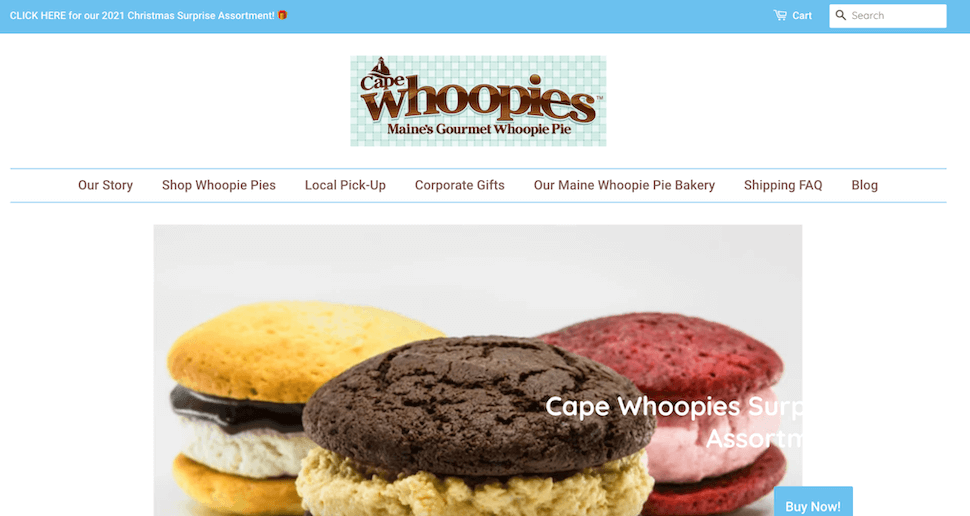
The company description should also outline your vision and mission statement and your value proposition . Your vision and mission statement encompass what you hope to do with your bakery, and your value proposition sums up why people would want to buy from you.
Use this section to talk about your team, including key personnel and their salaries. The bakery La Monarca , for example, would identify its two founders as well as any board members or employees.

Finally, list your short- and long-term business goals. Your business goals should be quantifiable and measurable, eliminating subjectivity. You’ll also want to put an estimated timeline for your business goals and when you hope to accomplish them.
3. Market analysis
The market analysis section of your bakery business plan quantifies how big your potential market is and validates that there’s enough demand for your business.
This section of the bakery business plan should explore the following:
- Industry trends
- Laws and regulations for the food industry
- The demographics of your target customer
- Where, why, and how they shop
- The size of your target market
- The price people are willing to pay for what you sell
You may also include a SWOT analysis , which identifies your strengths, weaknesses, opportunities, and threats, as well as a competitive analysis , outlining the competitive landscape and where your bakery fits in.
business structure of your bakery and whether you’ve elected to incorporate as a sole proprietorship, a limited liability corporation (LLC) , a corporation, or something else.
Don’t stress over the name of your bakery business too much yet—you don’t have to use your official incorporated name as your public-facing name forever. You can always file for a DBA (doing business as) or just publically drop the “Inc.” or “LLC” at the end of your name. Balkan Bites , for example, is technically an LLC called “Balkan Bites LLC.”

You’ll also want to include information about the makeup of your team, even if you plan to run the business yourself. Here are some other people and entities you might include:
- Owner . Who is the owner of the bakery?
- Business partner(s) . List and identify the role of any business partners you plan to work with. Make sure you note the ownership percentage breakdown.
- Management team . It helps to visualize the team with an organizational chart to show how roles and responsibilities are structured and contribute to your bakery’s bottom line.
- Financial advisers . Maybe they’re not in-house, but you might have contracted financial advisers or accountants helping you to manage finances.
- Employees . Even if you don’t plan to open your bakery business with employees, you might have plans to hire staff in the future. Make note of that in this section.
5. Products and services
In the products and services, you’ll list which products and services you’ll sell through your bakery. You’ll likely sell something like cakes, cookies, chocolates, pies, or even baking kits, and potentially branded merchandise products .
As far as baked goods go, consider more narrowly defined niches within the overarching bakery niche. For example, products that are tied to a specific culture, like a bakery that specializes in Italian cookies or French pastries, or event-related baked goods, like wedding or birthday cakes, all present excellent niches. You could also offer gluten-free, sugar-free, organic, or dairy-free goods.
The business plan should cover how many different types of products you’ll offer, and if you plan to release new recipes, or limited-edition or seasonal items.
You’ll also want to consider other non-bakery items. Dough Dealer , for example, doesn’t actually do any baking, so it doesn’t sell any baked goods. Instead, it sells kits with baking supplies online, as well as merchandise. You can do the same thing with a print-on-demand company .
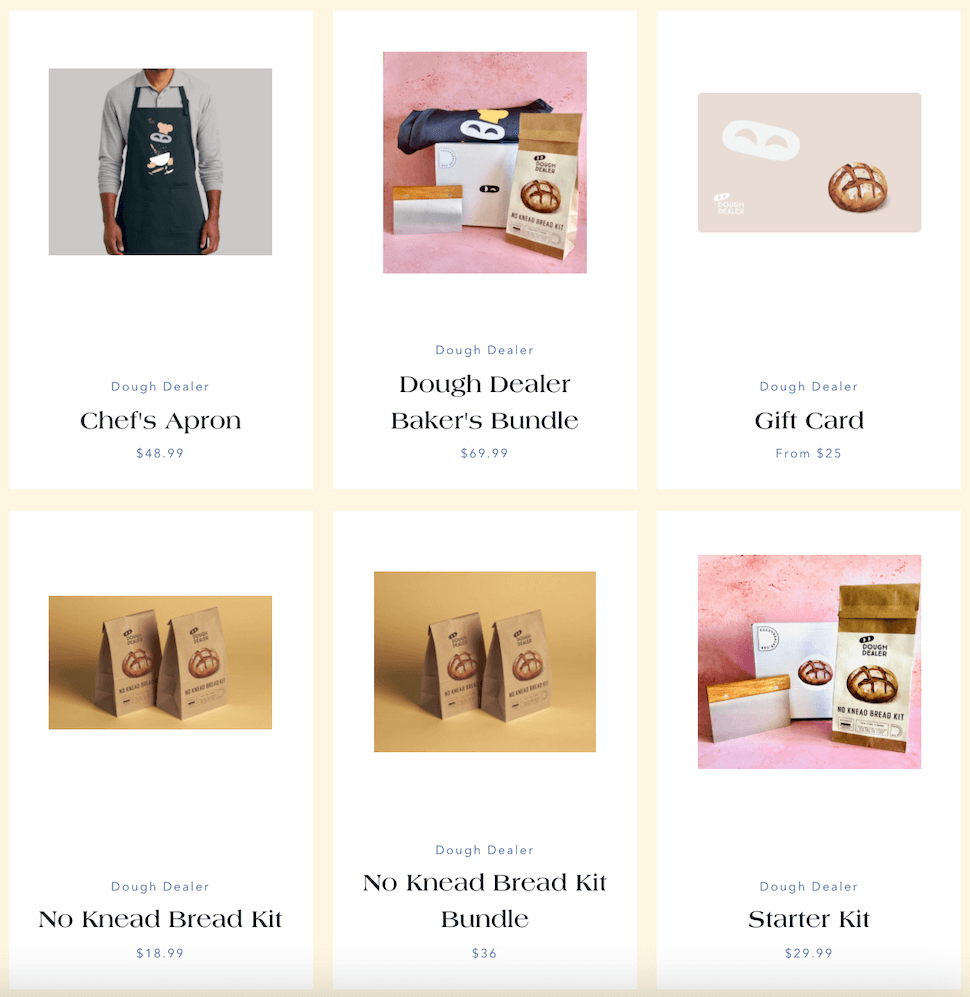
6. Customer analysis and segmentation
The customer segmentation section of your bakery business plan should discuss the different groups of shoppers you intend to target with your bakery. Include the following information about each of your segments:
- How old they are
- Where they live
- Where they work and what they do
- Education level
- What technology they use
- Their values, beliefs, and opinions
- Common behavior patterns
- How they shop
Here’s what a customer segmentation section might look like: Levain serves a few distinct geographic markets in Puerto Rico, including San Juan, Aguadilla, Mayagüez, and Rincón. Each of these regions represents a specific customer segment for the bakery, and they may have different shared characteristics. So Levain adjusts its promotional and marketing strategy according to its audience.
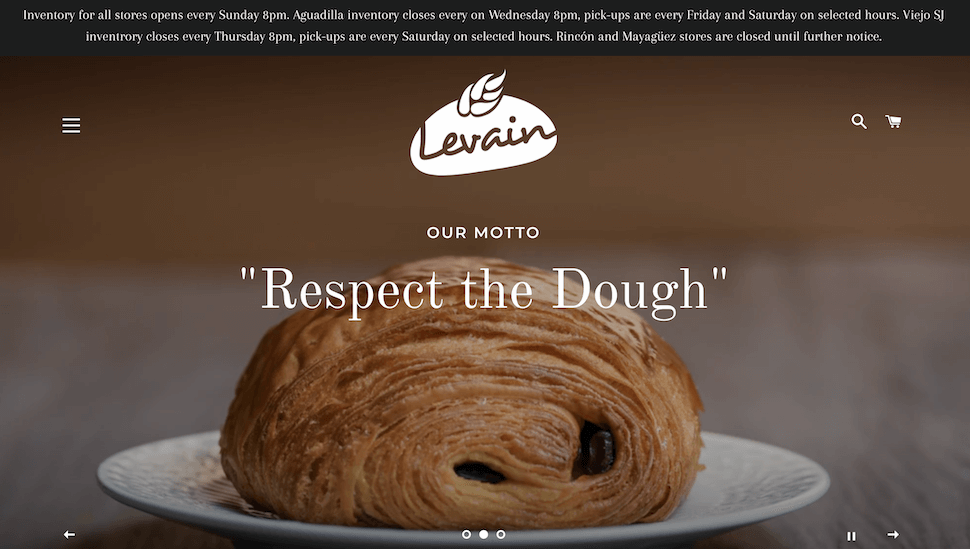
7. Marketing plan
Your marketing plan is a high-level overview of how you plan to promote your bakery. The marketing plan should outline which channels you plan to use for marketing and advertising, as well as any budgets you might have. At a minimum, this section of your bakery business plan should define the following:
- Price : How much your products cost and why.
- Product : What you’re selling and how you differentiate it from other goods in the market.
- Promotion : How you’ll get your products in front of your ideal customer.
- Place : Where you’ll sell your products, including online and in-person.
Zero-sugar cookie brand Sundays used email marketing to promote its bakery business and build buzz pre-launch. The brand allowed people to subscribe so they would be alerted when the online store launched. This approach is also an excellent tactic for email list-building .
Here are some more resources to help assemble the marketing section of your bakery business plan:
- How to Build a Marketing Plan That Actually Works
- 7 Inspiring Marketing Plan Examples (and How You Can Implement Them)
- Driving Growth: 12 Best Marketing Strategies Any Small Business Can Execute
8. Logistics and operations plan
Your logistics and operations plan outlines exactly how you’ll create and sell products and fulfill orders. Be sure to address each of the following:
Identify where you’ll purchase the raw ingredients you need to make your baked goods and where they’re produced. Will you purchase anything pre-made from suppliers or make everything from scratch?
Outline whether you’ll make, wholesale, or even dropship your products. Describe how long it takes to receive raw ingredients and how long it takes to produce your baked goods. You’ll also want to think about a contingency plan: How will you handle a busy season or an unexpected spike in demand?
Where will you and any team members work? Do you plan to have a physical retail space as well as the bakery? If yes, where? Will they coexist or exist in different locations?
List which tools and technology you require to get you up and running: think items like ovens, mixers, refrigerators, etc., as well as business tools like a POS system or card reader. You’ll even list items like lightbulbs, counters, and anything else you’ll need to purchase to open your bakery.
Shipping and fulfillment
Will you be handling all the fulfillment tasks in-house or will you use a third-party fulfillment partner? Will you have a space for in-person shopping or pickup?
How much raw ingredients will you keep on hand, and where will they be stored? How much finished product can you keep on hand, and where? How will you ship products to partners if required, and how will you approach inventory management ?
The bakery Wildgrain , for example, operates on a subscription-based business model. The brand outlines how it works on its website, information that would also be suitable for the logistics and operations section of its bakery business plan.

The sourdough bakery Florets offers a subscription plan as well as in-person pickup at its Auckland-based bakery location or at a weekly farmers market.
The Protein Bakery also has a few methods for fulfillment. Customers can visit its New York City–based retail shop or order online, and other businesses can also purchase its products wholesale.
9. Financial plan and projections
The financial plan shows possible funders that you’ve done your math homework and crunched the numbers to figure out how much money you need to launch, how much you need to operate, and whether you can turn a profit.
The financial plan typically includes the following financial statements :
- Income statement
- Balance sheet
- Cash flow statement
Here’s a spreadsheet template that includes everything you’ll need to create the above financial statements, including some sample numbers. Just edit it as needed.
When putting together your financial plan and statements, be realistic and specific. While you want to be optimistic about your projected success, it’s equally important to be pragmatic. Use the information you’ve learned developing other parts of your bakery business plan to calculate accurate, achievable numbers.
Launch your bakery business with Shopify
Starting your new venture with a successful bakery business plan is a surefire way to set yourself up for success from the get-go. Your bakery’s business plan will keep you and your team accountable and aligned with your vision and goals.
When you’re ready to launch, build your website on Shopify. With Shopify, you can seamlessly integrate your retail and ecommerce tech stack to maintain complete control of your growing business.
- How To Write the Perfect Business Plan in 9 Steps (2024)
- How to Find Out Who Owns a Domain Name
- Business Proposals- How to Write One and Where to Find Templates and Examples
- Domain Price - How Much Does a Domain Really Cost?
- 8 Woocommerce Alternatives to Manage Your Online Store
- Ecommerce Hosts- 7 Website Hosting Providers to Choose From
- The Foundation for Change- How to Write Your Nonprofit Business Plan
- How to Register a Business- What You Need to Do in 2024
- Domain History - How To Check the History of a Domain Name
Bakery business plan FAQ
How do i start my own bakery business plan, how much money can you make owning a bakery, what equipment is needed for a bakery.
- Food processor
- Dough proofer
- Dough sheeter
- Bread slicer
- Refrigerator and/or freezer
- Baker’s rack
- Baking pan and dishes
- Bowls, measuring cups, spoons, spatulas, etc.
- Pastry bags
- Work counters
- Dry storage
Is a bakery business profitable?
Keep up with the latest from Shopify
Get free ecommerce tips, inspiration, and resources delivered directly to your inbox.
By entering your email, you agree to receive marketing emails from Shopify.
popular posts
The most intuitive, powerful
Shopify yet
Shopify Editions Summer ’24

Subscribe to our blog and get free ecommerce tips, inspiration, and resources delivered directly to your inbox.
Unsubscribe anytime. By entering your email, you agree to receive marketing emails from Shopify.
Latest from Shopify
Jul 6, 2024
Jul 5, 2024
Jul 4, 2024
Learn on the go. Try Shopify for free, and explore all the tools you need to start, run, and grow your business.
Try Shopify for free, no credit card required.

Ultimate Guide

Unleash Your Flour Power: Designing a Winning Bread Bakery Business Plan
Introduction to your bread bakery business plan.
When embarking on the journey of starting a bread bakery, it is crucial to have a well-crafted business plan to guide your efforts and increase your chances of success. A bakery business plan serves as a roadmap for your venture, outlining your goals, strategies, and financial projections. In this section, we will discuss the importance of a business plan and the key components it should include.
The Importance of a Business Plan
A well-prepared business plan is essential for several reasons. Firstly, it acts as a blueprint for your bakery business, providing a clear direction and helping you make informed decisions along the way. It enables you to define your objectives, understand your market, and develop effective strategies to achieve your goals.
Secondly, a bakery business plan is often required when seeking funding or investment . Lenders and investors need to assess the viability and profitability of your bakery before committing their resources. A comprehensive business plan demonstrates your understanding of the industry, market demand, and your ability to generate revenue.
Additionally, a bakery business plan allows you to evaluate and monitor the progress of your bakery. By setting measurable goals and tracking your performance against them, you can identify areas that need improvement and make necessary adjustments to ensure your bakery’s success.
Key Components of a Bread Bakery Business Plan
To create an effective bakery business plan, there are several key components that you should include:
- Executive Summary : This section provides an overview of your bakery business, including your mission statement, vision, and a brief introduction to your products and services. It serves as a snapshot of your entire business plan and should capture the reader’s attention.
- Market Analysis : In this section, you will analyze the bakery industry, identify your target market, and assess the competition. Understanding the market trends, consumer preferences, and your competitors’ strengths and weaknesses will help you position your bakery strategically.
- Products and Services : Describe the bread varieties and specialties that your bakery will offer. Highlight any unique or signature items that set your bakery apart from the competition. Additionally, discuss any additional products or services that you plan to provide, such as pastries, cakes, or catering options.
- Marketing and Sales Strategy : Outline your branding and positioning strategy. Explain how you will promote your bakery and attract customers. Consider the use of online marketing, social media, and traditional advertising channels to reach your target audience effectively. For further guidance, you can refer to our article on how to write a bakery business plan .
- Operations and Management : Provide details about your bakery facilities, equipment, and layout. Discuss your staffing requirements, including the roles and responsibilities of each team member. Consider mentioning any specialized training or certifications that your staff will possess to ensure high-quality products and services.
- Financial Projections : This section includes your start-up costs, funding requirements, and a sales forecast. It is important to estimate your expenses accurately and project your revenue based on market research and industry trends. This information will help you determine the financial viability of your bakery and attract potential investors.
By including these key components in your bread bakery business plan, you will create a comprehensive document that outlines your bakery’s goals, strategies, and financial projections. Remember to review and update your business plan regularly to align with changing market conditions and business goals. With a well-prepared business plan in hand, you can confidently pursue your dream of owning and operating a successful bread bakery.
Executive Summary
In your bread bakery business plan , the executive summary is a concise overview of your bakery business and its goals. It provides readers with an understanding of your bakery’s mission, vision, and key highlights. This section sets the tone for the rest of your business plan, enticing readers to explore further.
Overview of Your Bakery Business
Your bakery business, name of your bakery , aims to bring the joy of freshly baked bread to your customers. Located in city or area , your bakery will serve as a welcoming space for bread enthusiasts seeking high-quality and artisanal bread varieties.
With a focus on using locally sourced ingredients and traditional baking techniques, your bakery aims to provide an exceptional bread experience. From classic loaves to specialty breads, your bakery will offer a wide range of delicious options to cater to diverse tastes and preferences.
Mission Statement and Vision
At name of your bakery , our mission is to create a bakery that becomes an integral part of our community, known for its commitment to quality, innovation, and customer satisfaction. We strive to bring people together through the shared love of bread, while supporting local farmers and suppliers.
Our vision is to be the go-to destination for bread enthusiasts seeking exceptional taste, texture, and variety. We aim to establish a loyal customer base by consistently delivering fresh, handcrafted bread that exceeds expectations. Through our commitment to sustainability and community engagement, we aspire to make a positive impact on the lives of our customers and the environment.
By crafting an enticing executive summary, you lay the foundation for your bread bakery business plan . The subsequent sections will delve into more detailed aspects, such as market analysis, product offerings, marketing strategies, operations, and financial projections. Remember to use this summary to capture the attention and interest of potential investors and stakeholders.
Market Analysis
In order to create a successful bread bakery business plan , you need to conduct a thorough market analysis. This involves analyzing the bakery industry as a whole and identifying your specific target market.
Analyzing the Bakery Industry
To begin, it is important to gain a comprehensive understanding of the bakery industry. Analyze the current market trends, including the demand for bread products and the overall growth of the industry. Consider factors such as consumer preferences, dietary trends, and the competitive landscape. Understanding the market dynamics will help you identify opportunities and potential challenges for your bakery business.
Additionally, research different types of bakeries, such as online bakeries, cupcake bakeries, and wholesale bakeries, to gain insights into their strategies and success factors. This will allow you to identify unique selling points and differentiate your bread bakery from the competition. For more information on how to conduct a comprehensive market analysis, check out our article on bakery business plan .
Identifying Your Target Market
Once you have analyzed the bakery industry, the next step is to identify your target market. Consider who your ideal customers are and what their preferences and needs are when it comes to bread products. Are you targeting health-conscious individuals seeking organic and gluten-free options? Or are you focusing on traditional bread enthusiasts who appreciate artisanal bread?
By identifying your target market, you can tailor your offerings and marketing strategies to meet their specific demands. This will help you position your bread bakery as the go-to destination for your target customers.
To further refine your target market analysis, consider factors such as demographics, psychographics, and geographic location. Conduct surveys or interviews with potential customers to gather insights into their bread preferences, buying habits, and price sensitivity. This valuable information will allow you to create a more effective marketing and sales strategy.
Understanding the bakery industry and identifying your target market are critical steps in creating a successful bread bakery business plan. By conducting a thorough market analysis, you will be equipped with the knowledge and insights needed to make informed decisions and position your bakery for success in a competitive market.
Products and Services
In your bread bakery business plan, it is crucial to outline the products and services you will offer. This section will focus on the different bread varieties and specialties you plan to provide, as well as any additional products and services that will complement your bakery offerings.
Bread Varieties and Specialties
When it comes to bread, the options are endless. It’s important to identify the bread varieties and specialties that will set your bakery apart and cater to your target market’s preferences. Here are some examples of bread varieties you may consider:
| Bread Varieties | Description |
|---|---|
| Sourdough | A tangy and chewy bread made with a fermented dough starter. |
| Whole Wheat | A hearty and nutty bread made from whole wheat flour, rich in fiber. |
| Baguette | A classic French bread with a crispy crust and soft interior, perfect for sandwiches. |
| Multigrain | A nutritious bread made with a combination of grains and seeds. |
| Ciabatta | An Italian bread known for its light and airy texture, great for paninis. |
| Brioche | A rich and buttery bread often used in pastries and gourmet sandwiches. |
In addition to traditional bread varieties, you may also want to consider offering specialty breads that cater to specific dietary needs or preferences. Some examples include gluten-free breads, vegan breads, or breads with unique flavor profiles like olive or rosemary-infused breads. By diversifying your bread offerings, you can attract a wider range of customers and meet their specific demands.
Additional Products and Services
While bread will likely be the cornerstone of your bakery business, considering additional products and services can further enhance your offerings and increase revenue streams. Here are some examples of additional products and services you may consider:
- Pastries and Desserts : Expand your bakery’s menu to include a variety of pastries such as croissants, muffins, cookies, and cakes. These sweet treats can complement your bread selection and attract customers with different preferences.
- Beverages : Consider offering a range of hot and cold beverages to accompany your bakery products. This can include coffee, tea, specialty drinks, or even fresh juices. Providing a selection of quality beverages can enhance the overall customer experience and encourage repeat visits.
- Custom Orders : Offer custom orders for special occasions such as birthdays, weddings, or corporate events. This could involve creating custom bread or pastry assortments, personalized cakes, or catering services. Providing tailored solutions to your customers can help build strong relationships and increase customer loyalty.
- Bakery Workshops : Consider hosting bakery workshops to share your expertise and engage with the community. These workshops could cover topics such as bread making, pastry techniques, or cake decorating. Not only can this generate additional revenue, but it also positions your bakery as a knowledgeable and trusted resource within the community.
By diversifying your product offerings and providing additional services, you can attract a broader customer base and create multiple revenue streams for your bread bakery. Remember to adapt your offerings based on market trends and customer preferences to ensure continued success.
Marketing and Sales Strategy
To ensure the success of your bread bakery business, a well-defined marketing and sales strategy is essential. This section of your bakery business plan will outline your approach to branding and positioning your bakery, as well as the promotional activities and channels you will utilize to attract customers.
Branding and Positioning
Creating a strong brand and establishing a unique position in the market is crucial for the success of your bakery business. Your brand should reflect the values and identity of your bakery, appealing to your target audience. Consider factors such as your bakery’s name, logo, colors, and overall aesthetic to create a cohesive and memorable brand.
When it comes to positioning, identify what sets your bakery apart from the competition. Highlight your unique selling points, such as the quality of your ingredients, the artisanal techniques you use, or any special bread varieties you offer. Emphasize these factors in your marketing materials and communication to differentiate yourself from other bakeries.
To learn more about creating an effective bakery brand and positioning it in the market, check out our bakery business plan article .
Promotional Activities and Channels
Promoting your bakery effectively is essential for attracting customers and generating sales. Consider a variety of promotional activities and channels to reach your target audience. Here are some strategies to consider:
- Online Presence: Establish a professional website that showcases your bakery’s offerings, provides information about your location and hours, and allows customers to place orders online. Utilize social media platforms such as Instagram and Facebook to engage with your audience, share visually appealing images of your bread, and announce special promotions or new products.
- Local Partnerships: Collaborate with local businesses, such as coffee shops, restaurants, or grocery stores, to create cross-promotional opportunities. Offer to supply them with your bread in exchange for displaying your bakery’s signage or business cards.
- Tastings and Sampling: Host tasting events or offer samples of your bread at local food festivals, farmers markets, or community events. This allows potential customers to experience the quality and taste of your bread firsthand, enticing them to visit your bakery.
- Customer Loyalty Programs: Implement a customer loyalty program to reward frequent visitors and encourage repeat business. Offer discounts, freebies, or exclusive promotions to customers who join your loyalty program.
- Local Advertising: Consider placing advertisements in local newspapers, magazines, or on community bulletin boards. Advertise on local radio stations or sponsor community events to increase your bakery’s visibility.
By implementing a well-rounded marketing and sales strategy, you can effectively promote your bakery, establish a strong brand presence, and attract a loyal customer base. Remember to regularly evaluate the success of your promotional activities and adjust your strategies as needed to maximize results.
Operations and Management
To ensure the smooth functioning of your bread bakery business, it is crucial to have a well-defined plan for operations and management. This section will cover two important aspects: bakery facilities and equipment and staffing and training .
Bakery Facilities and Equipment
The success of your bakery largely depends on having appropriate facilities and equipment. Your bakery should have a spacious and well-designed layout that allows for efficient workflow. Consider factors such as the size of the kitchen, storage areas, and customer seating if applicable.
Investing in quality bakery equipment is essential for producing high-quality bread. Some key equipment to consider include:
| Equipment | Purpose |
|---|---|
| Commercial oven | Baking bread at precise temperatures |
| Dough mixer | Mixing and kneading dough |
| Proofing cabinet | Allowing dough to rise |
| Bread slicer | Slicing bread with consistency |
| Cooling racks | Cooling baked bread |
Ensure that your bakery is equipped with the necessary tools and machinery to handle the production volume and variety of bread you plan to offer. Regular maintenance and cleaning of the equipment are crucial to keep them in optimal condition for longer periods.
Staffing and Training
Having a competent and well-trained staff is vital to the success of your bakery. Determine the number of employees required based on the size of your bakery and the volume of bread production. Roles may include bakers, pastry chefs, sales staff, and administrative personnel.
When hiring employees, look for individuals with experience and a passion for baking. Provide thorough training to ensure that all staff members are well-versed in baking techniques, food safety, customer service, and any specific procedures unique to your bakery. Regular training sessions and refresher courses can help maintain and enhance the skills of your staff.
Additionally, establish clear job descriptions, responsibilities, and expectations for each role. Proper communication and teamwork are essential for efficient bakery operations.
By focusing on bakery facilities and equipment, as well as staffing and training, you can create a solid foundation for the smooth operation of your bread bakery business. For more comprehensive guidance on creating a successful bakery business plan, check out our article on bakery business plan .
Financial Projections
To ensure the success of your bread bakery business, it is crucial to have a solid understanding of the financial aspects. This section of your bread bakery business plan will focus on the start-up costs and funding required to get your bakery up and running, as well as the sales forecast and financial analysis to project the future financial performance of your business.
Start-up Costs and Funding
Starting a bakery involves various expenses that need to be accounted for in your financial plan. These start-up costs can include:
- Equipment and Machinery : List the cost of purchasing or leasing bakery equipment like ovens, mixers, proofing cabinets, and refrigerators.
- Renovations and Leasehold Improvements : Include any costs associated with renovating your bakery space, such as plumbing and electrical work, flooring, and painting.
- Ingredients and Supplies : Estimate the initial costs of purchasing ingredients, packaging materials, baking supplies, and other essential items.
- Licenses and Permits : Research the costs associated with obtaining necessary licenses and permits required to operate your bakery legally.
- Marketing and Advertising : Consider the expenses for promoting your bakery through various channels, such as creating a website, social media advertising, and traditional marketing methods.
- Staffing and Training : Account for the costs of hiring and training your bakery staff, including salaries, benefits, and training materials.
- Utilities and Rent : Estimate the monthly costs of utilities (electricity, water, gas) and rent for your bakery space.
- Insurance : Include the costs of business insurance, such as liability insurance and property insurance.
For a more comprehensive breakdown of start-up costs specific to your bakery, refer to our article on bakery business plan .
To fund your bakery’s start-up costs, consider various sources of financing, including personal savings, loans from financial institutions, or investments from partners. Determine how much capital you need and create a detailed plan for securing the necessary funds.
Sales Forecast and Financial Analysis
Creating a sales forecast is essential for understanding the revenue potential of your bread bakery business. This projection estimates the sales you expect to generate over a specific period, typically the first three to five years of operation. Your sales forecast should consider factors such as your target market, pricing strategy, and the demand for your products.
To create a sales forecast, start by estimating the number of loaves or other bakery products you anticipate selling each day, week, or month. Multiply this figure by the average selling price per item to calculate your projected revenue. Consider seasonality, local market trends, and customer preferences when making these estimates.
In addition to the sales forecast, conduct a financial analysis to evaluate the profitability and sustainability of your bakery business. This analysis should include a calculation of key financial ratios, such as gross profit margin, net profit margin, return on investment, and break-even point. These ratios provide valuable insights into your bakery’s financial health and can help you make informed decisions to maximize profits.
For a comprehensive guide on how to write a bakery business plan, including financial projections, visit our article on how to write a bakery business plan .
By carefully considering the start-up costs, securing appropriate funding, and creating realistic sales forecasts and financial analysis, you can lay a strong foundation for your bread bakery business and increase its chances of long-term success.
Leave a Comment Cancel Reply
Your email address will not be published. Required fields are marked *
Save my name, email, and website in this browser for the next time I comment.

Workforce Management
Inventory Management
Order Managements
Production Sheet
Work Health Safety
Food Safety
© Copyright 2023, All Rights Reserved by Bakeroo
Phone number
Bakery Name
Sling is now Sling by Toast! Learn more
More Features

- Restaurants
- Get Started

How To Start a Bakery: Steps and a Sample Business Plan
- Templates & Guides
Want to take your culinary skills to the next level, move out of your home kitchen, and learn how to start a bakery? Good for you!
While the process is really just that simple, there are a number of practical steps you can take to get your new business heading in the right direction — including writing your very own bakery business plan.
In this article, we discuss some of the best things you can do before you even open your doors that can help make your new bakery a success.
Table of contents
How to start a bakery, sample bakery business plan.

1) Gain practical experience
Learning how to start a bakery and writing a bakery business plan are two very unique and specialized activities. Unlike, say, mowing lawns, owning and operating a successful bakery takes a lot of knowledge, experience, and skill.
Before you bake your first loaf for profit, get as much practical experience as possible. One of the best ways to do this is to work in a bakery or similar niche business.
As you do, pay attention to more than just the baking. Note how the business manages its employees , markets its products, provides customer service , and develops its business model.
Learning about these foundational business activities in addition to the bread-baking process can give your new endeavor the best chance for success.
2) Research laws that apply to the food service industry
Starting a food service business of any kind comes with a long list of laws, rules, and guidelines. Whether you want to open a bakery, a coffee shop , a cafe , or a restaurant , you’re going to have to operate under some very high standards.
Before you invest any money in the project, be sure to research the laws that apply to the food service industry in your area and get professional legal counsel.
For example, you may discover that your state requires you to use stainless steel appliances and cookware. Those items can be expensive to purchase and may affect how you spend the rest of your startup capital.
You may even discover that operating a bakery isn’t for you. And that’s OK. If that’s the case, at least you found out before you committed yourself to the project. View it as a learning experience, and use that information to find the business that’s right for you.
3) Consider a specialty
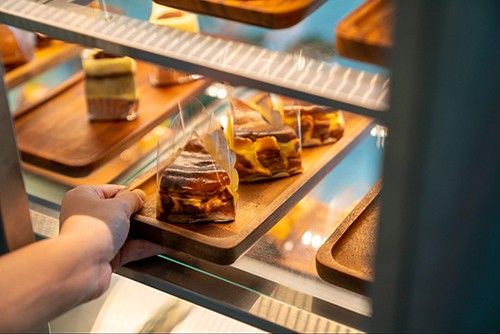
At first, you may be tempted to offer any and all baked goods under the sun — cakes, cookies, muffins, cupcakes, pies, breads, turnovers, and other sweet treats.
But jumping all in at first can make it more difficult to keep your bakery business in the black. Instead, consider a specialty for your business, and write it into your bakery business plan.
Narrowing down what you offer to one or two items — e.g., breads and croissants — can help in two distinct ways:
- It may allow you to focus on making your products the best they can be (rather than spreading your efforts too thin)
- It may help your customers recognize exactly what your business is and give you a boost in carving out market share among your competitors
As you’ll see in the sample bakery business plan later on in this article, All I Want Is Bread chose to focus on bread products so they can refine their recipes and make the best products possible.
4) Get to know your target market
Another important step in the process of starting a bakery is getting to know your customer base (i.e., your target market).
Doing so can provide valuable insight into key variables such as:
- Demand for your baked goods
- Customer demographics (i.e., statistical data relating to the population and particular groups within it)
- How your market will react to your baked goods
- Appropriate price points
Getting to know your target market can also help you identify factors that influence your potential customers’ buying decisions, allowing you to give them what they want and need.
5) Create a bakery business plan
Starting a small business of any kind depends, in large part, on the planning you do before the doors open. You can accomplish a large portion of that planning by creating a bakery business plan for your new endeavor.
Doing so will give you a roadmap or guidebook that can help you deal with the everyday activity of your business that, ultimately, makes it a success.
We’ve included a brief sample bakery business plan below, but you can learn more about everything that goes into this important document by reading these articles from the Sling blog:
- How To Start a Coffee Shop: Step-by-Step Coffee Shop Business Plan
Food Truck Business Plan: The Beginner’s Guide For Success

Here we provide a sample bakery business plan to get you started. We’ve included four of the most important sections in this sample, but there are many other sections you can include in your own document.
Consider this example a “jumping off” point. Use the information as you see fit, customize it to your business, and produce the best bakery business plan possible.
For more information on writing a business plan for a food service establishment, check out this article from the Sling blog: Restaurant Business Plan: What To Include, Plus 8 Examples.
Executive summary
All I Want Is Bread is a new bakery venture that aims to introduce the French boulangerie experience into the local market.
All I Want Is Bread will offer traditional baked goods, including baguettes, pain de campagne, sourdoughs, croissants, pain au chocolat, pain au lait, and turnovers.
All I Want Is Bread will make these baked goods from scratch with high-quality, fresh, locally sourced, sustainable ingredients. This commitment to quality ingredients and sustainable practices will set us apart from the competition
Company description
All I Want Is Bread will be run by Buffy Summers (owner) and Willow Rosenburg (general manager). Ms. Summers owns and operates several businesses in the area, and Ms. Rosenburg has 10 years’ experience managing a boulangerie in Paris, France.
All I Want Is Bread will be located in Sunnydale’s vibrant downtown district within walking distance to office buildings, restaurants, and residential neighborhoods.
All I Want Is Bread will be run as a Limited Liability Partnership (LLP) between Ms. Summers and Ms. Rosenburg.
It is our goal to provide quality bread to the workers, residents, and restaurants in our area. To help achieve that goal, we will also offer cafe-style seating, coffee and other beverages, and free WiFi to encourage customers to stay.
Market analysis
Bakery statistics according to [Source]:
- Industry net worth: $5 billion
- Growth rate: 3% per year over the next five years
As you can see, the bakery industry is a competitive niche, but there are also a number of excellent opportunities for new businesses within that niche.
We believe the key to success is to offer high-quality products, excellent customer service, and a competitive price .
Our target market includes bread lovers of all ages as well as restaurants that want to offer their customers and employees high-quality baked goods made from locally sourced, sustainable ingredients.
Financial Plan
We project that All I Want Is Bread will generate $1.5 million in its first year of operation with a 3% increase each year thereafter for the next three years.
We will achieve these numbers by targeting a 30% share of the Sunnydale bakery market and expect a gross profit margin of 4% in our first year of operation.
Workforce management and your bakery business plan

As you think about how your new company will run, be sure to include workforce management in your business plan.
More specifically, describe the technology you’ll use to help guide and direct your team — whether it’s one person, 10 people, or 100 people.

The Sling app , for example, includes a long list of tools to help make your workforce management as efficient and productive as possible, including:
- Advanced employee scheduling
- Integrated time clock
- Comprehensive communication
- Flexible task management
- And much more
Try Sling for free today to experience firsthand how the software can help you bring your bakery business plan to life.
Then, for more business management resources, help scheduling your employees, and tips for leading a successful team, visit GetSling.com today.
See Here For Last Updated Dates: Link
This content is for informational purposes and is not intended as legal, tax, HR, or any other professional advice. Please contact an attorney or other professional for specific advice.
Find the article useful? Share with others:

Related articles

Do you want to give your new mobile eatery the best chance for success? Write a ...

Restaurant Business Plan: What To Include, Plus 8 Examples
Do you want to ensure the success of your new foodservice endeavor? Write a rest...

How To Start A Catering Business in 20 Steps
So you want to start a catering business? That’s great! The catering industry ...
Get started today
Schedule faster, communicate better, get things done.
- Sample Business Plans
- Food, Beverage & Restaurant
Bakery Business Plan

Ready to turn your love for baking baked goods into a successful business?
To ensure that your business endeavor happens to be a flourishing one, write a business plan specifically crafted for your unique bakery business.
From helping you finalize the bakery location to evaluating the financial position of your business- a detailed plan uncovers every detail essential to kickstart a successful bakery business.
Writing a business plan can get complicated. With this step-by-step guide, you will have all the information essential to write a bakery business plan . Also, download our free bakery business plan template and modify it to fit your needs.
Ready to dive in? Let’s get started.
Key Takeaways
- Conduct a detailed industry analysis of the bakery market to understand market trends, target market, and the growth scope of your business.
- Outline the business goals and devise a business strategy that is in line with your bakery’s branding image.
- Analyze the competitive landscape of your business and identify local businesses that will offer direct and indirect competition to your business.
- Make calculations, assumptions, and projections to form key reports such as income statement, balance sheet, Cash Flow statement, and Break-even analysis.
- Determine the operations of your bakery business by outlining the procedures, processes, and equipment required to kickstart the business.
- Determine the baked goods and services you will sell through your bakery business.
Why is a bakery business plan important?
A business plan helps achieve your business objectives by creating a roadmap that will guide your bakery business in a strategic direction. An actionable well-drafted plan offers an in-depth view of your business idea and are a few benefits you must know:
- A business plan instills clarity in your business idea. All the ideas that were messed up in your mind start getting a clear point of view once you start writing a plan.
- A business plan is your checklist to understand what different aspects of the business need- the resources, equipment, manpower, licenses, etc.
- It helps crystallize your business vision and what it aims to achieve in the bakery market.
- A business plan optimizes the bakery operations and brings down the operating expenses by ensuring the resourceful allocation of bakery resources.
- A plan evaluates the financial aspects and viability of your bakery idea before you actually invest money in the business.
And, of course, a well-crafted plan will get you essential funds to get started in the bakery market. Moving forward, let’s craft a spectacular plan for your bakery business.
How to Write a Bakery Business Plan: A Complete Guide
From writing an executive summary to creating your financial plan- let’s decode the key elements of writing a business plan.
1. Get a business plan template
Before you start writing a business plan, consider getting a sample template to simplify the entire plan writing process.
A lot of information goes into writing a comprehensive business plan. Addressing all the key components in brief details is a challenging task.
However, by using a template, you can add structure to your plan. Not only that, it will help you organize the information clearly in a cohesive manner. With appropriate prompts, you will know exactly what to write in each section.
We know you would start searching for a template. Well, the Upmetrics business planning template is perfectly relevant and suited for your bakery business. It’s intuitive, modern, and available for free download.

Need Assistance Writing a Bakery Business Plan?
Get Upmetrics’ business plan template, import data directly into the editor, and start editing using Upmetrics AI Assistant.

Start Planning Now
2. Write an executive summary
The executive summary is a concise description of your entire bakery business plan. It highlights the key findings and entices the reader to delve further into your business plan. So make sure to keep it interesting.
A well-drafted executive summary includes an answer to every question, a potential investor might have.
For instance,
- What is the core objective of your bakery business?
- What are the pain points of your target customers and what solutions can you offer?
- What type of baked goods will you offer?
- What is your target market?
- What is your marketing strategy?
- What are the financial highlights of your bakery business?
As you start writing, remember that the executive summary should summarize the plan and not your business idea.
Lastly, fit your compelling summary description in 1-2 pages.
3. Conduct a competitive and market analysis
The market analysis section paints a clear picture of your ideal target market, bakery industry trends, and your competitors in the market. In a way, this section is your chance to validate the potential success of your bakery shop.
The market analysis section of your bakery plan must include:
Market share, growth potential, and industry trends
Identify your targeted available market (TAM) through thorough market research and determine your share in the bakery market. Analyze the emerging trends in the bakery market and assess your growth potential as a retail bakery.
Understanding of the target market
Who will be your potential customer at a bakery shop?
It gets much easier to succeed in the market when you have a clear understanding of who your target customers are.
In this section of customer analysis, you will create a buyer’s persona of your ideal customer by understanding their psychographic and demographic details.
Competitor analysis
This is an equally important part of the market study, where you evaluate the position and competitive landscape of your bakery shop.
Begin by identifying your top competitors and evaluate your strengths, weaknesses, opportunities, and threats against other bakeries. Establish your competitive edge and show the potential investors that your business stands a promising opportunity in the competitive market.

Want to Perform Competitive Analysis for your Business?
Discover your competition’s secrets effortlessly with our user-friendly and Free Competitor Analysis Generator!
4. Prepare a company overview
The company overview section of a bakery’s business plan is a brief description of your bakery business concept, its legal structure, location, and value proposition.
Be creative and write a compelling section that can propel the readers’ interest in your business idea.
Wondering what to include in your bakery’s company overview section? Let’s check:
- Type of bakery business: retail bakery, specialty bakery, cloud bakery, mobile bakery, etc.
- Business structure: Sole proprietorship, LLC, partnership LLC, corporation, etc.
- Mission statement
- Value proposition
- Quantifiable business goals and milestones
- History and background of the bakery, if applicable
- Partnership and ownership structure
- Name of owners/ partners
- Operating hours
- Service style
Drill down to details and make this section an engaging read.
5. Describe your products and services
After describing your bakery structure and mission statement in the previous section, you will now outline the product and service offerings of your bakery shop.
As a bakery business, you may sell a variety of delicious baked goods such as pastries, cakes, fresh bread, cookies, tarts, pies, donuts, sweet buns, etc. Add this to your product section and also non-baked goods such as savory snacks, coffee, etc, if it’s on your menu offering.
Specifically mention, if you will have products for special diets, i.e. gluten-free, keto-friendly, sugar-free, vegan baked goods, etc.
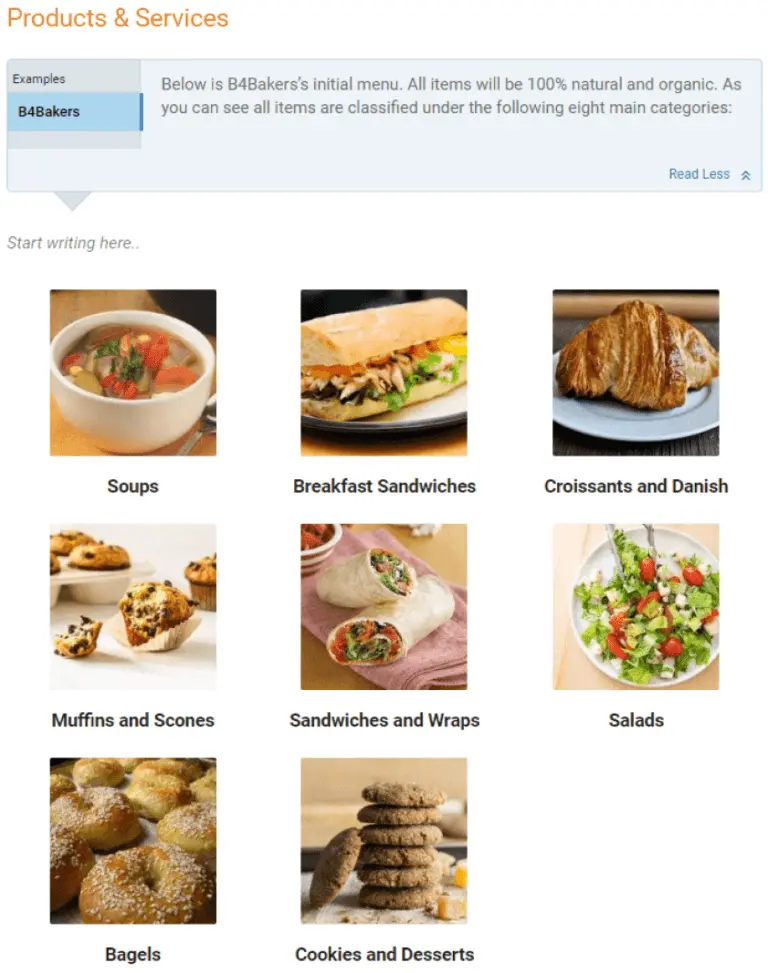
6. Bakery store design and layout
An effective bakery business plan must include a blueprint of your bakery shop’s layout and design to demonstrate the bakery’s concept practically to the readers.
Mention your bakery size and the space allocated for the back of the house and front of the house operations. Also, explain how the proposed layout will increase the efficiency of your business operations in great detail.
In this section, you will also talk about the decor and theme that will create a warm ambiance for your target audience. Keep in mind that the decor should reflect the branding image you want to create in your target market.
Offer an immersive experience to the readers while explaining this section.
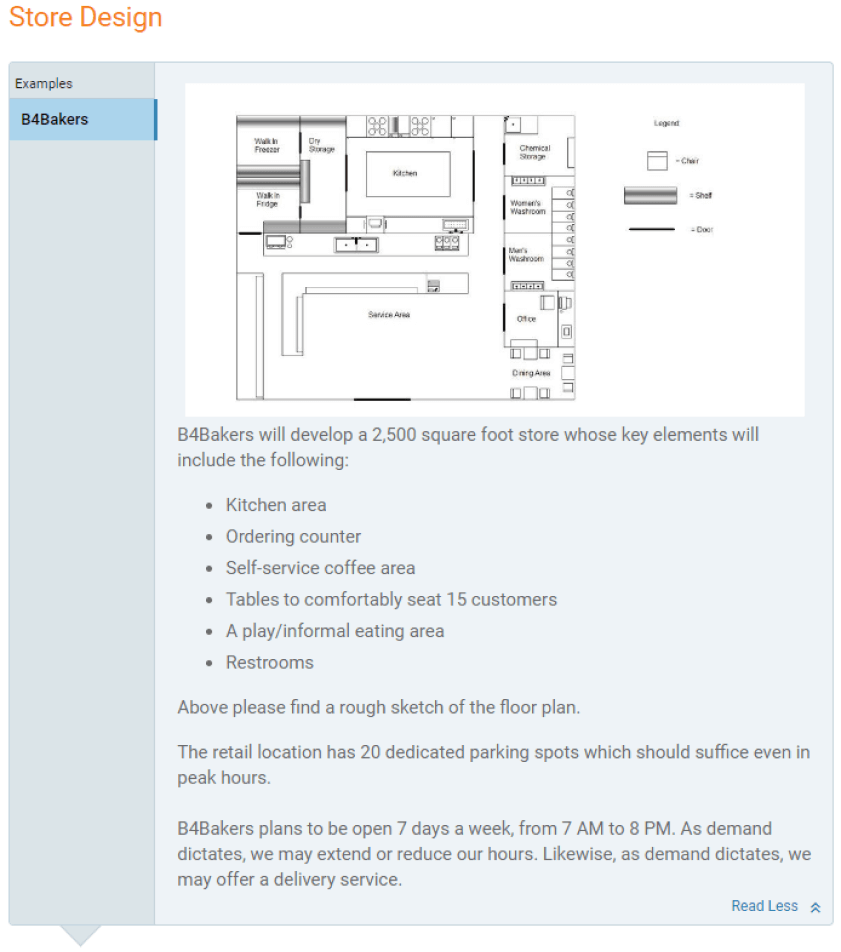
7. Prepare a bakery marketing plan
The marketing plan offers a detailed outlook of marketing strategies you will use to market and promote your bakery shop. Consider it as a roadmap that will guide you in building a brand of sustainable value in the market.
So how do you build a perfect marketing plan?
Begin by identifying the marketing channels and different types of digital marketing campaigns that will work best for your potential customers. Now, allocate the monthly budget to different marketing activities. Lastly, devise a marketing strategy for each channel with a clear plan of action.
Here are a few marketing strategies that are popularly used by successful bakery businesses:
- Social media platforms for brand development
- Email marketing for promotional offers
- Video content such as easy baking recipes, tips, tricks, etc
- Online workshops and live sessions
- Influencer marketing
- Tasting events and sampling
- Customer testimonials
Now detail all your plans in this section and show your investors that you have a solid way to establish your business’s popularity in its target market.
8. Outline your organizational structure
In this section of your bakery business plan, you introduce the management team and employees at your shop. Also, highlight the organizational structure and hierarchy of employees in the organization.
Begin by introducing the owners and their role in your organization. Highlight their experience in the bakery industry and the key skills that can benefit the business.
Introduce your talented baker and their role in recipe development and standardization. Show their experience in the baking field and prove their asset worthiness.
Draw a clear flowchart depicting the flow of authority and responsibility in your bakery business. It is your chance to show the investors that you have a team and knack to take this business on a successful path.
9. Create a logistics and operational plan
The operations plan of your bakery business plan is a strategic document highlighting the processes, procedures, and resources needed to efficiently run your bakery shop.
A well-planned operations plan is like a business manual that has answers to all the questions one might have while running a bakery shop.
Wondering what to add to your operations plan? Well try to include answers to the following questions to make it detailed and comprehensive:
- Physical facilities: What will be your bakery location to produce bakery goods? Will you serve customers from that location or a different shop? Are you planning to sell the bakery goods online?
- Suppliers: Where will you get the raw materials and supplies for producing bakery goods? Who will supply non-bakery items like scones, sandwiches, and savory snacks?
- Inventory: Where will you store the raw material and ingredients? What will be the shelf life of these ingredients? How will you manage the stock levels? What are the minimum thresholds for different items and how long it takes to stock them?
- Production: Who will bake the goods? How long is the process? Will everything be made fresh or in batches to be stored for a few days? Will there be recipe cost cards for each menu item? How will you meet an unexpected spike in demand?
- Bakery Equipment: What type of bakery equipment will you require? Will there be a POS system at your store? What other technologies will you use? How will you take online orders?
The amount of precision here will help you regulate your operating expenses once the bakery starts serving the customers. Proper planning is advisable at this stage.
10. Create a Financial Plan
And now comes the most exciting part for investors- a financial plan. The figures in financial statements are helpful in determining the viability of your business idea. So this section holds a considerable weightage in terms of whether you will get funding or not.
To ensure you create a comprehensive financial plan, including financial projections for these key components:
- Cost of starting a bakery shop
- Sales forecast
- Revenue projection
- Operating expenses
- Pricing strategy
- Income statement/ Profit & Loss statement
- Break-even analysis
- Cash flow statement
- Balance sheet
- Business ratios
In this section, you will also evaluate your funding requirements and identify the funding sources for your business. i.e. bank loans, SBA-guaranteed loans, angel investors, and personal savings.
Having realistic financial projections at hand will help you realize your financial goals while evaluating the sustainability of your bakery business.
However, creating the projections for all these elements from scratch can get overwhelming. Additionally, you also need to work on visuals and graphs to add impact and clarity to your plan.
Well, there is an easy way. Create your plan with the Upmetrics Financial forecasting tool . This tool will generate key reports and visuals that can be easily downloaded and added to your plan.
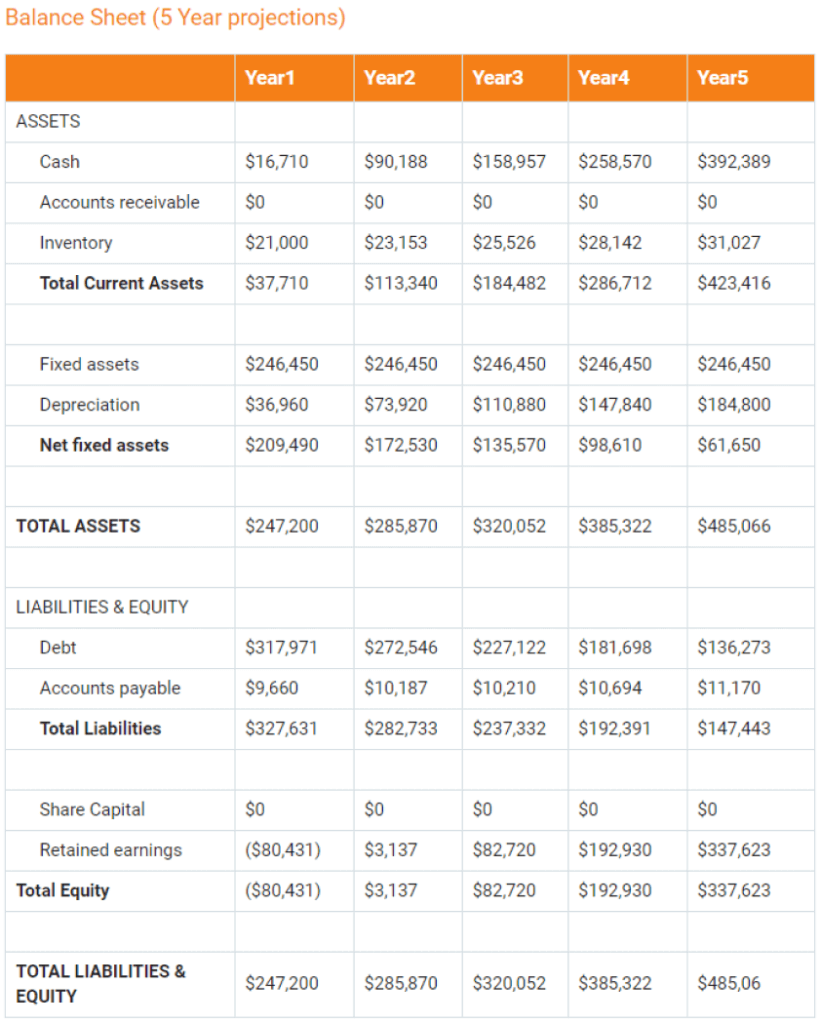
We hope this sample plan will guide you in writing a perfect business plan. Now, let’s move forward and check the industry trends ruling the bakery world.
Bakery Industry Highlights 2023
Before you open a bakery, here are some latest highlights from the bakery industry, you may find helpful:
- Bakery market size: The US bakery market size was valued at $99.47 billion dollars in 2023. It is projected to grow at a CAGR of 2.08% between 2023-2028.
- Retail Bakeries: According to IBIS World , there are 8,780 independent retail bakery shops in the US.
- Bakery consumption: In 2022, Americans consumed 8.6 billion kilograms of cake and pastry goods, a sizable amount compared to other countries.
- Bakery trends: There is a growing trend of providing healthier alternatives, i.e. gluten-free baked goods in the bakery market. The organic and gluten-free baked goods market grew by 2.45% in 2022.
- Market Saturation: 55% of commercial bakery revenue in the US is generated by 3 major players- Grupo Bimbo, Flower Foods, and Campbell Soup.
- Specialty bakery market: The US Specialty bakery market share is expected to grow by 10.54 billion US dollars by 2026.
Download a sample Bakery business plan
Need help writing your own bakery business plan? Well, download our bakery business plan pdf and write your plan section-by-section with utmost precision.
Upmetrics templates are perfectly suited for entrepreneurs who need a little help to kickstart their business planning. Import the data into the editor and start planning.
The Quickest Way to turn a Business Idea into a Business Plan
Fill-in-the-blanks and automatic financials make it easy.
Write your business plan with Upmetrics
Optimize your business planning with Upmetrics .
With more than 400+ business plan examples , we offer invaluable guidance to help you write a cohesive business plan.
Whether you are writing a business plan to strategically grow your business or attract investors, Upmetrics’ invaluable resources like AI assistance, forecasting tools, and step-by-step guides will serve you perfectly.
Let’s bake a recipe for success together.
Related Posts
Bakery Business Marketing Plan
Bakery Financial Plan
Best AI Business Plan Generator

Tips for a Business Plan Presentation
How Much Costs to Start a Bakery
How to Open Bakery Business
Frequently asked questions, what should be included in a bakery business plan.
An effective bakery business plan must include:
- Executive summary
- Business overview
- Industry and competitors analysis
- Bakery goods and services
- Bakery design and layout
- Operations plan
- Key management team
- Financial bakery plan
How long should my bakery business plan be?
A bakery business plan should be not more than 15-20 pages including graphs, visuals, and charts. You are likely to lose the interest of investors with a lengthy plan. However, keeping it extremely short is also not favorable, as it would not cover important details. So try using crisp content for your business plan.
Can a bakery business plan template help in setting clear business objectives and goals?
Absolutely yes. A template offers a variety of prompts that will help you to write each section clearly and cohesively. Moreover, you will get a variety of bakery-specific examples that shall help in clearly determining your goals and objectives.
Do I need to have financial projections in my bakery business plan?
Yes, financial projections are important to assess the viability and profitability of your business idea. If you are planning to seek investor funds, this section is of crucial importance. Investors will evaluate the financial section and determine whether to invest or not.
Can I use the same bakery business plan template for different locations?
Yes, you can. However, you need to alter the content of your business plan for different locations and target markets by making specific modifications.
About the Author

Vinay Kevadiya
Vinay Kevadiya is the founder and CEO of Upmetrics, the #1 business planning software. His ultimate goal with Upmetrics is to revolutionize how entrepreneurs create, manage, and execute their business plans. He enjoys sharing his insights on business planning and other relevant topics through his articles and blog posts. Read more
Plan your business in the shortest time possible
No Risk – Cancel at Any Time – 15 Day Money Back Guarantee

Create a great Business Plan with great price.
- 400+ Business plan templates & examples
- AI Assistance & step by step guidance
- 4.8 Star rating on Trustpilot
Streamline your business planning process with Upmetrics .


Bread Bakery Business Plan

Have you ever wondered how a lot of bread bakery businesses succeed in such a short period of time? Many may think this is impossible, but it is not, it is merely difficult but it is not as impossible as a lot of people would assume it to be. A lot of people would often ask what these business owners did in order to attain such success in just a few short years. Since handling a business like a bread bakery business is not an easy feat. In addition to that, there are a lot of things that business owners have to go through in order to achieve this type of business and of course the secret to a good bread bakery business is a good business plan to back it up. Do you want to start a business like a bread bakery business in your hometown? To get that dream to become a reality, you need a good bread bakery business plan to back that up, and here’s how you can do it.
3+ Bread Bakery Business Plan Examples
1. bread bakery business plan template.
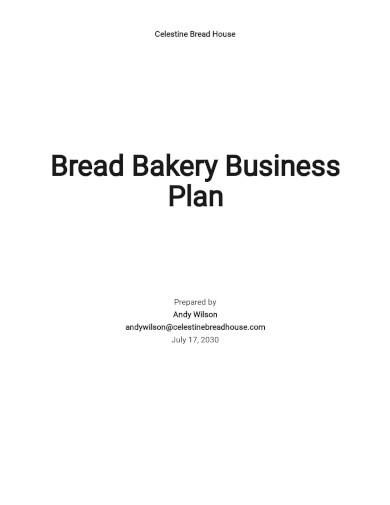
- Google Docs
2. Standard Bread Bakery Business Plan
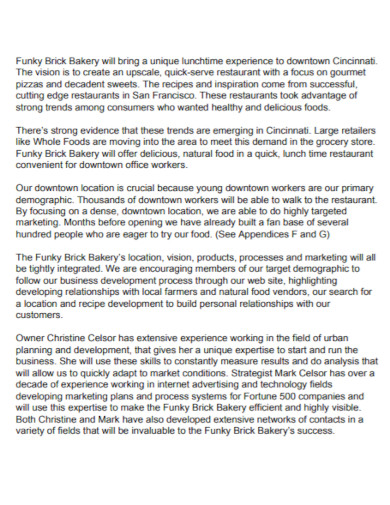
3. Bread Community Bakery Business Plan
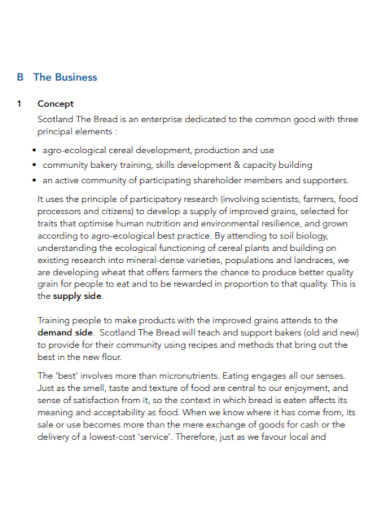
Size: 492 KB
4. Health Bread Bakery Business Plan
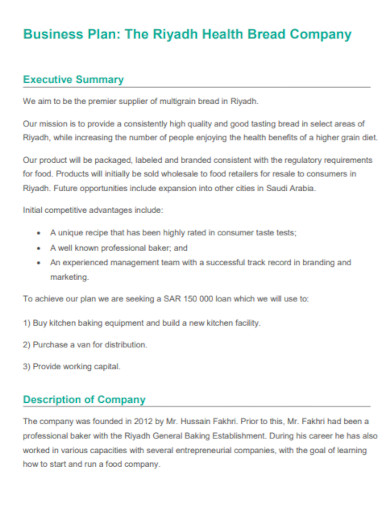
Size: 133 KB
What Is a Bread Bakery Business Plan?
A bread and bakery business plan is a well thought out document that gives out a general description of what the business would be about. A bread bakery business plan is a specific type of business plan that centers around the bread bakery business. The business plan consists of the executive summary, the description of the business, the goals and objectives and of course the strategy on how to achieve that goal. The importance of a bread bakery business plan is to ensure that the flow of your ideas are written on paper and you are able to see the positive and the negative aspects and to avoid any risks or issues that may destroy the process of your bread bakery business. The business plan in itself outlines what you should be doing and how you should do it.
How to Make a Bread Bakery Business Plan
Writing or composing your very own bread bakery business plan should not be another problem nor something difficult to do. By downloading the following template examples found in this article and following the ones listed below, it would surely be a simple and smooth process from here.
1. Make Your Executive Summary of Your Business
The executive summary would be more about your bread bakery business. Your mission statement . The summary should explain further the reason for the business, the nature of your business, the expected outcome of your business and of course the estimated years you plan to make it happen.
2. Set Out Examples of the Products
Another thing you can take notice of when writing your bread bakery business plan is the sample items or products you are going to be selling. The purpose for this is to make it understandable that this business plan you are writing about is for this kind of product . It also helps you understand what kinds of bread you are going to plan on adding to your business.
3. Write an Outline of Your Marketing Strategies
Outlining your marketing strategies is a sure way of making your business a success. It is also the best way to view how you want your business to go through. Marketing strategies like how you want your business to look like, will you add brochures , how to attract customers to buy are simply just one of the strategies you need to put. In addition to that, outlining your strategies will make it easier for you to go through your business plan without any problem.
4. Set up a Timeline for Your Milestones
Setting up timelines for every milestone that you have achieved based on your business plan. These milestones may vary depending on how you plan on achieving them and how you plan on making it. In addition to that, these milestones are going to act as your guide on how far you have achieved to reach your goal.
5. Repeat the Entire Steps until You Succeed
The last tip but definitely not the least one is to repeat everything. Repeat the steps you have seen above until you are sure enough that you are close to succeeding. Never forget to stick to your business plan, but also never be afraid to make mistakes. Your business plan can still be rewritten.
What is a bread bakery business plan?
A bread bakery business plan is a strategic document that a business person would write in order to construct their very own business. A bread bakery type of business. The business plan consists of the strategies, the milestones, the executive summary, and the description just to name a few.
What can a business plan do to help?
The purpose of writing out a business plan is to make sure that you don’t have to make a lot of mistakes. A business plan is a guide to make your business a reality. It serves as a road map to avoid any difficult roadblocks and risks.
Why are milestones so important?
The milestones are necessary to encourage you to do better and to encourage you not to give up. Milestones help in a way that makes you see. It helps by giving you an opportunity to learn from the experience.
Businesses have risks. Even small-time businesses. Whether it would be a small business like a bread bakery business or a larger scale business, having a business plan would always be the best option you can do.
Text prompt
- Instructive
- Professional
Create a study plan for final exams in high school
Develop a project timeline for a middle school science fair.
5+ SAMPLE Bread Bakery Business Plan in PDF
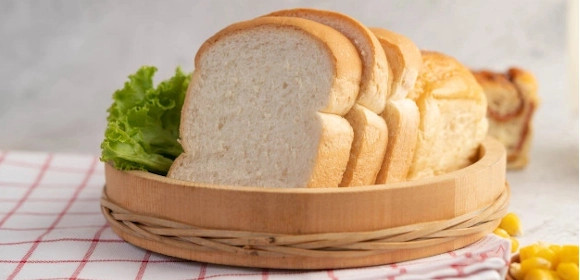
Bread Bakery Business Plan
5+ sample bread bakery business plan, what is a bread bakery business plan, elements of a bread bakery business plan, tips on bread bakery business plan, how to set up a bread bakery business, is a business proposal needed with the business plan, how much does it cost to start a bread bakery business.

Health Bread Bakery Business Plan
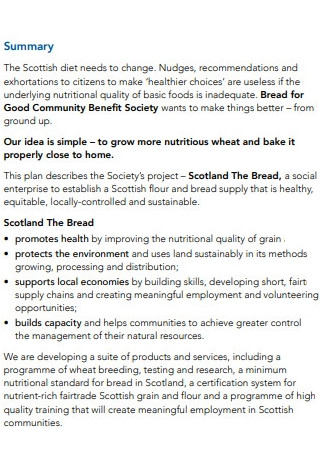
Sample Bread Bakery Business Plan
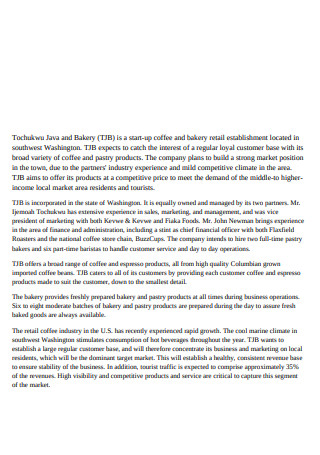
Simple Bread Bakery Business Plan
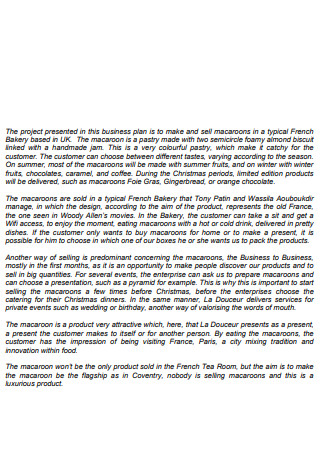
Bread Bakery Business Plan Example

Bread Bakery Business and Marketing Plan
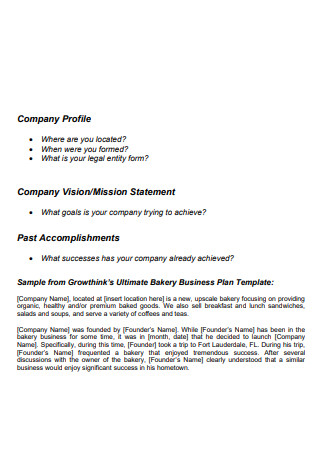
Basic Bread Bakery Business Plan
Executive summary, company description, key personnel, product offerings.
- What are your specialties in your bakery? Are they custom-made? How nutritious are they? Are they gluten-free?
- Do you have a new product? Does that product has a patent?
- How unique are the products that you are going to sell in a specific location?
- Are you planning to make new recipes always?
- What will you do if there will be a decline in sales for your one type of bread?
- Where are you going to buy the ingredients that you will use for the bread? What is the equipment that you have to buy?
Market Analysis
- What can be the approach to different demographics? What can be the best age group? How can you match the bread to the income level of people?
- What are the current trends in the bread bakery business? How much money do people usually spend on bread? What can make people not go into a bakery?
- What will I do with my competitors? How can you learn from their success? What are the steps that you need to be their contender in the business?
- What are the codes and regulations that I have to follow? Which of these things will apply to your bakery? How can you comply with these regulations?
- How can you deal with the financials? What will be your pricing structure?
Operational Plan
Financial projections, sales forecasts, step 1: create a plan, step 2: make it legal, step 3: define your brand, step 4: set up your system, share this post on your network, you may also like these articles.

In this comprehensive guide, we explore the essentials of creating an effective Floor Plan. Whether you are designing a new home, renovating an existing space, or planning an office…
Nursing Care Plan

In this comprehensive guide, we explore the essentials of creating an effective Nursing Care Plan. Whether you are a nursing student, a new graduate, or an experienced nurse, this…
browse by categories
- Questionnaire
- Description
- Reconciliation
- Certificate
- Spreadsheet
Information
- privacy policy
- Terms & Conditions
Don't bother with copy and paste.
Get this complete sample business plan as a free text document.
Bakery Business Plan
Start your own bakery business plan
Jolly's Java and Bakery
Executive summary executive summary is a brief introduction to your business plan. it describes your business, the problem that it solves, your target market, and financial highlights.">, opportunity.
There is a shortage of coffee spots where customers can get high quality coffee and freshly baked pastries in a higher income market in Washington state.
JJB offers a broad range of coffee and espresso products, all from high quality imported coffee beans. JJB caters to all of its customers by providing each customer coffee and espresso products made to suit the customer, down to the smallest detail.
Because Washington has a cool climate for eight months out of the year, hot coffee products are very much in demand. During the remaining warmer four months of the year, iced coffee products are in significantly high demand, along with a slower but consistent demand for hot coffee products. Much of the day’s activity occurs in the morning hours before ten a.m., with a relatively steady flow for the remainder of the day.
Competition
Competition in the local area is somewhat sparse and does not provide nearly the level of product quality and customer service as JJB. Local customers are looking for a high quality product in a relaxing atmosphere. They desire a unique, classy experience.
JJB is a bakery and coffee shop managed by two partners. These partners represent sales/management and finance/administration areas, respectively. The partners will provide funding from their own savings, which will cover start-up expenses and provide a financial cushion for the first months of operation.
Expectations
JJB anticipates sales as shown below during the three years of the plan. JJB should break even by the fourth month of its operation as it steadily increases its sales. Profits for this time period are expected to be relatively low in the first two years, increasing somewhat in the third. We are projecting investment of $140,000 from the two founders.
Financial Highlights by Year
Financing needed.
Startup requirements:
- Startup expenses of $64K including $3K legal, $20K location premises renovation, $40K expensed equipment, and $1K other. These show up as negative retained earnings in the initial balance because they are incurred before launch.
- Starting cash in the bank of $70K. (in initial balance)
- Other current assets of $12K (in initial balance)
- Long-term assets of $65 (in initial balance)
- $110K initial investment from founders (Shows up in initial balance as Paid-in Capital.)
- $100K 10-year loan from SBA (in initial balance)
- $1K in accounts payable at startup. (in initial balance)
Problem & Solution
Problem worth solving.
There is a shortage of coffee spots where customers can get high-quality coffee and freshly baked pastries in a higher income market in the southwest area of Washington state.
Our Solution
JJB offers a broad range of coffee and espresso products, all from high-quality Columbian grown imported coffee beans. JJB caters to all of its customers by providing each customer coffee and espresso products made to suit the customer, down to the smallest detail.
Target Market
Market size & segments.
JJB focuses on the middle- and upper-income markets. These market segments consume the majority of coffee and espresso products.
Local Residents
JJB wants to establish a large regular customer base. This will establish a healthy, consistent revenue base to ensure the stability of the business.
Tourist traffic comprises approximately 35% of the revenues. High visibility and competitive products and service are critical to capture this segment of the market.
Current Alternatives
Leading competitors purchase and roast high quality, whole-bean coffees and, along with Italian-style espresso beverages, cold-blended beverages, a variety of pastries and confections, coffee-related accessories and equipment, and a line of premium teas, sell these items primarily through company-operated retail stores. In addition to sales through company-operated retail stores, leading competitors sell coffee and tea products through other channels of distribution (specialty operations).
Larger chains vary their product mix depending upon the size of each store and its location. Larger stores carry a broad selection of whole bean coffees in various sizes and types of packaging, as well as an assortment of coffee- and espresso-making equipment and accessories such as coffee grinders, coffee makers, espresso machines, coffee filters, storage containers, travel tumblers and mugs. Smaller stores and kiosks typically sell a full line of coffee beverages, a more limited selection of whole-bean coffees, and a few accessories such as travel tumblers and logo mugs. According to the most recent data available, industry retail sales mix by product type was approximately 73% beverages, 14% food items, eight percent whole-bean coffees, and five percent coffee-making equipment and accessories.
Our Advantages
The retail coffee industry in the U.S. has recently experienced rapid growth. The cool marine climate in southwest Washington stimulates consumption of hot beverages throughout the year.
JJB wants to establish a large regular customer base, and will therefore concentrate its business and marketing on local residents, which will be the dominant target market. This will establish a healthy, consistent revenue base to ensure stability of the business. In addition, tourist traffic is expected to comprise approximately 35% of the revenues. High visibility and competitive products and service are critical to capture this segment of the market.
Keys to Success
Keys to success for JJB will include:
Providing the highest quality product with personal customer service.
- Competitive pricing.
Marketing & Sales
Marketing plan.
Our marketing is rooted in the quality of the experience, to generate good word of mouth and repeat visits. That should generate good reviews on Yelp and Google Maps and similar review platforms.
Of course we will pay attention to reviews and work with promotions to encourage reviews without being too blatant about it.
We will also keep an up-to-date Facebook page and Twitter persona with regularly updated content. We will be slow to do promotions over social media, emphasizing useful content instead. Some of that will include community content.
Locations & Facilities
JJB wants to establish a large regular customer base, and will therefore concentrate its business and marketing on local residents, which will be the dominant target market. This will establish a healthy, consistent revenue base to ensure the stability of the business. In addition, tourist traffic is expected to comprise approximately 35% of the revenues. High visibility and competitive products and service are critical to capture this segment of the market. JJB will have a storefront that is easily accessible from 2 different highways.
Milestones & Metrics
Milestones table.
| Milestone | Due Date | Who’s Responsible | |
|---|---|---|---|
| Sept 13, 2018 | Team | ||
| Sept 13, 2018 | Team | ||
| Sept 13, 2018 | Team | ||
| Oct 15, 2018 | Team |
Key Metrics
Of course, the main metrics are the obvious ones: sales, direct, costs, expenses, and cash flow. But we will also be watching for units, customers, and social media metrics including Facebook likes and Twitter follows.
Ownership & Structure
JJB is incorporated in the state of Washington. It is equally owned and managed by its two partners.
The company intends to hire two full-time managers, one pastry chef and 3 part-time baristas to handle customer service and day to day operations.
Management Team

Personnel Table
| FY2019 | FY2020 | FY2021 | |
|---|---|---|---|
| Managers (2) | $100,000 | $110,000 | $121,000 |
| Pastry chef | $45,000 | $49,500 | $54,450 |
| Baristas (3) | $120,000 | $132,000 | $145,200 |
| Totals | $265,000 | $291,500 | $320,650 |
Financial Plan investor-ready personnel plan .">
Revenue forecast.
| FY2019 | FY2020 | FY2021 | |
|---|---|---|---|
| Revenue | |||
| Coffee | $475,065 | $517,500 | $569,250 |
| Pastries | $223,750 | $250,000 | $275,000 |
| Other | $12,930 | $15,000 | $20,000 |
| Total Revenue | $711,745 | $782,500 | $864,250 |
| Direct Cost | |||
| Coffee | $190,026 | $207,000 | $227,700 |
| Pastries | $89,500 | $100,000 | $110,000 |
| Other | $5,172 | $6,000 | $8,000 |
| Direct Labor | |||
| Total direct costs | $284,698 | $313,000 | $345,700 |
| Gross margin | $427,047 | $469,500 | $518,550 |
| Gross margin % | 60% | 60% | 60% |
Revenue by Month
Expenses by month, net profit (or loss) by year, use of funds.
We will be financing initial assets of $65,000 long-term assets (equipment, etc.) and $12,000 current assets plus initial inventory and the early months before break-even occurs.
Sources of Funds
Two owners each investing $70,000. Total startup investment is $140,000
Projected Profit & Loss
| FY2019 | FY2020 | FY2021 | |
|---|---|---|---|
| Revenue | $711,745 | $782,500 | $864,250 |
| Direct Costs | $284,698 | $313,000 | $345,700 |
| Gross Margin | $427,047 | $469,500 | $518,550 |
| Gross Margin % | 60% | 60% | 60% |
| Operating Expenses | |||
| Salaries & Wages | $265,000 | $291,500 | $320,650 |
| Employee Related Expenses | $53,000 | $58,300 | $64,130 |
| Rent | $60,000 | $65,000 | $70,000 |
| Marketing and Promotion | $30,500 | $33,000 | $35,000 |
| Total Operating Expenses | $408,500 | $447,800 | $489,780 |
| Operating Income | $18,547 | $21,700 | $28,770 |
| Interest Incurred | $2,881 | $2,616 | $2,343 |
| Depreciation and Amortization | $13,000 | $13,000 | $13,000 |
| Gain or Loss from Sale of Assets | |||
| Income Taxes | $400 | $913 | $2,014 |
| Total Expenses | $709,479 | $777,329 | $852,837 |
| Net Profit | $2,266 | $5,171 | $11,413 |
| Net Profit/Sales | 0% | 1% | 1% |
Projected Balance Sheet
| Starting Balances | FY2019 | FY2020 | FY2021 | |
|---|---|---|---|---|
| Cash | $70,000 | $91,886 | $98,613 | $115,920 |
| Accounts Receivable | $0 | $0 | $0 | $0 |
| Inventory | $12,000 | $26,083 | $28,809 | $28,809 |
| Other Current Assets | ||||
| Total Current Assets | $82,000 | $117,969 | $127,421 | $144,729 |
| Long-Term Assets | $65,000 | $65,000 | $65,000 | $65,000 |
| Accumulated Depreciation | $0 | ($13,000) | ($26,000) | ($39,000) |
| Total Long-Term Assets | $65,000 | $52,000 | $39,000 | $26,000 |
| Total Assets | $147,000 | $169,969 | $166,421 | $170,729 |
| Accounts Payable | $1,000 | $13,233 | $14,790 | $15,024 |
| Income Taxes Payable | $400 | $231 | $506 | |
| Sales Taxes Payable | $16,781 | $15,650 | $17,285 | |
| Short-Term Debt | $8,711 | $8,976 | $9,249 | $9,530 |
| Prepaid Revenue | ||||
| Total Current Liabilities | $9,711 | $39,390 | $39,920 | $42,345 |
| Long-Term Debt | $91,289 | $82,313 | $73,064 | $63,533 |
| Long-Term Liabilities | $91,289 | $82,313 | $73,064 | $63,533 |
| Total Liabilities | $101,000 | $121,703 | $112,984 | $105,878 |
| Paid-In Capital | $110,000 | $110,000 | $110,000 | $110,000 |
| Retained Earnings | ($64,000) | ($64,000) | ($61,734) | ($56,563) |
| Earnings | $2,266 | $5,171 | $11,413 | |
| Total Owner’s Equity | $46,000 | $48,266 | $53,437 | $64,850 |
| Total Liabilities & Equity | $147,000 | $169,969 | $166,421 | $170,729 |
Projected Cash Flow Statement
| FY2019 | FY2020 | FY2021 | |
|---|---|---|---|
| Net Cash Flow from Operations | |||
| Net Profit | $2,266 | $5,171 | $11,413 |
| Depreciation & Amortization | $13,000 | $13,000 | $13,000 |
| Change in Accounts Receivable | $0 | $0 | $0 |
| Change in Inventory | ($14,083) | ($2,726) | $0 |
| Change in Accounts Payable | $12,233 | $1,557 | $233 |
| Change in Income Tax Payable | $400 | ($169) | $275 |
| Change in Sales Tax Payable | $16,781 | ($1,131) | $1,635 |
| Change in Prepaid Revenue | |||
| Net Cash Flow from Operations | $30,597 | $15,702 | $26,556 |
| Investing & Financing | |||
| Assets Purchased or Sold | |||
| Net Cash from Investing | |||
| Investments Received | |||
| Dividends & Distributions | |||
| Change in Short-Term Debt | $265 | $273 | $281 |
| Change in Long-Term Debt | ($8,976) | ($9,249) | ($9,530) |
| Net Cash from Financing | ($8,711) | ($8,976) | ($9,249) |
| Cash at Beginning of Period | $70,000 | $91,886 | $98,613 |
| Net Change in Cash | $21,886 | $6,726 | $17,307 |
| Cash at End of Period | $91,886 | $98,613 | $115,920 |

The quickest way to turn a business idea into a business plan
Fill-in-the-blanks and automatic financials make it easy.
No thanks, I prefer writing 40-page documents.

Discover the world’s #1 plan building software

Bakery Business Plan Template [Updated 2024]
Bakery Business Plan
If you want to start a bakery or expand your current bakery, you need a business plan.
The following sample bakery business plan gives you the key elements to include in a winning business plan. It can be used to create a business plan for a dessert bakery, bread bakery, cake bakery, and other businesses that sell baked goods.
You can download the bakery business plan template (including a full, customizable financial model) to your computer here.
Bakery Business Plan Sample
Below are links to each of the key sections of a business plan template for a bakery to help you write your bakery business plan:
- Executive Summary – In the Executive Summary, you will provide a high-level overview of your business plan including a brief description of your company, your products or services, your target market, and your business goals.
- Company Overview – The Company Overview section will include your bakery business concept, company history, bakery location, mission statement, and ownership structure.
- Industry Analysis – In the Industry Analysis, provide an in-depth look at the bakery industry including trends, competition, and growth potential.
- Customer Analysis – The Customer Analysis is where you will describe your ideal customers including their demographics and buying behaviors.
- Competitive Analysis – In the Competitive Analysis, you will compare your business to your closest competitors and provide an analysis of their strengths and weaknesses.
- Marketing Plan – In the Marketing Plan, you will flush out your marketing strategy for reaching your target market. This should include your marketing mix, your sales and distribution strategy, and your pricing strategy.
- Operations Plan – Your Operations Plan will include a description of your bakery, your bakery equipment, your production process, and your talented baker.
- Management Team – The Management Team section will include descriptions of your co-founders and key management members.
- Financial Plan – A comprehensive Financial Plan will include realistic financial projections and financial statements including an income statement, balance sheet, and cash flow statement.
Comments are closed.
Bakery Business Plan Outline
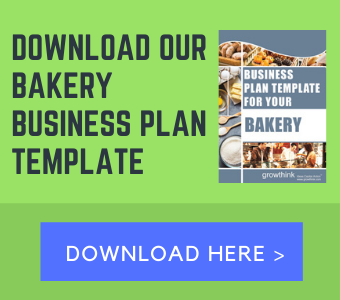
- Best Products
How to Start Bread Making Manufacturing Business
- January 6, 2023
- by Next What Business Research Team
Do you want to start a bread manufacturing business? Find here a detailed guide on starting a bread-making business with low capital investment.
Bread manufacturing project can be initiated on a small scale and does not require major licensing. Bread is a hygienically manufactured and packed snacks food product available at a comparatively cheap price. In modern days bread is now becoming one of the essential food items in the human diet due to its ready-made availability and high nutritive value. It is the most consumable wheat-based bakery product.
The bread is low margin high volume based on processed food and also bread manufacturing is labor-intensive.
The per capita consumption of bread in India is around 1.5 kg to 1.75 kg in various zones. The organized sector consists of around 1800 small-scale bread manufacturers around the country, besides 25 medium-scale manufacturers and 2 large-scale industries which were permitted to continue on the basis of their production capacity.
Wheat flour, yeast, sugar, salt, water, and shortening agent are required as raw materials to manufacture bread. The plant and machinery and the technology required to manufacture the bread, are completely available in India.
Related: Profitable Food Business Ideas to Start with Low Investment
Since the consumption of bread is increasing rapidly day by day, the demand also is increasing enormously. So, though there are a lot of organized as well as the private sector exists, the demand will not meet totally by them in near future.
The bread manufacturing industry is a 4.00 million tons industry growing at the rate of 6 percent and is expected to grow at the same rate in the medium term. So, for new startup entrepreneurs, it may become a very good sector for investment.
Types of Bread Manufacturing Formulations
Many different types of bread manufacturing formulations have been developed so far. These formulations are developed in different regions based on the 7 traditional food habits of the people. The main bread types can be classified as under.
1. Pan bread: This type of bread is popular in economically developed countries including the USA, Canada, United Kingdom, and European nations.
2. Hearth bread or sour bread: This category of bread is produced with or without lactic acid fermentation. Hearth bread is baked in an open-earth infrastructure. These bread are becoming popular in France.
3. Flatbread or roti/chappati: This category of bread is popular in Asian countries. The product is unfermented and flat. This baked on a flat hot pan.
4. Rolls and other small fermented bread: These products generally have higher levels of sugar and fat in the formulation and thus typically have a sweeter taste and softer bite characteristics.
Bread Making Manufacturing Process
The bread-making process is broadly divided into 6 different steps. The first step is to mix the various ingredients. Major ingredients include enzymes, starch, and yeast.
The second step is rising or fermenting. Once the mixture is fermented properly, you need to knead. This is done to correct if there are gas holes created while rising. After proper kneading, you need to once again for a rising again.
The next step is the critical baking process. The baking process will actually convert the unpalatable mass into digestible and eatable bread.
The final step is cooling the baked bread. The baked bread is normally allowed to cool to 35-degree centigrade temperature.
Bread Manufacturing Project Sample Cost Synopsis:
| 5000 packets per day | Rupees 12 Lakhs |
| Rupees 11 Lakhs | Rupees 36 Lakhs |
| 13.53% | 80.44% |
The actual cost of the bread manufacturing project may deviate from a change of any of the assumptions. You can modify the project capacity and project cost as per your requirement.

Daily bread – How to start a successful bread bakery business in Africa’s fast growing bread market

Ever considered one of the bread bakery business opportunities in Africa ? You’re about to learn several reasons why you should.
Everyone eats bread. Bread competes against rice and cassava (gari) as the most popular food and staple in Africa. It has remained a widely-accepted food item because of its convenient and ready-to-eat nature.
Bread is a common food item in many African households and up to 70 percent of breakfast diets on the continent contain bread.
The size of the African bread market is worth billions of dollars every year and nearly all the bread we eat is produced locally. A bread bakery business is easy to start up and can be run from a home kitchen or a bread factory.
Let’s take a dive into this interesting idea and explore the business opportunities for African entrepreneurs in the bread bakery business…
Why is the demand and market for bread growing very fast in Africa?
According to a recent study , the demand for bread is expected to explode in the coming years. South Africa, Nigeria, Ethiopia, Sudan and Kenya are currently the largest and leading bread markets in Africa.

Africa now has more than 50 cities inhabited by over one million people. By 2020, more than 500 million Africans are projected to live in urban areas and cities.
Statistics reveal that urban dwellers and city people eat more bread than people in the rural areas. Given the rapid growth of African city populations, bread is sure to remain a highly sought-after food item by African households.
More than 80 percent of all imported and locally produced wheat flour in Africa is used by bakeries to produce bread. The rest is used by food processors to make biscuits, cakes, pasta and pasta.
Over the last decade, more bread has been consumed in Africa than maize and rice. Why? It’s simply because bread is more affordable (costs much less than rice, yam and maize).
Bread also appeals to the convenience and lifestyle of most people – it’s an instant meal that requires no further preparation, and makes a great fast snack (besides its popularity as a breakfast item).
Many of us may not know this: bread provides more nutrients than any other single food source and is particularly important as a rich source of carbohydrates, proteins and vitamins B and E!
Market opportunities for entrepreneurs who want to start a bread bakery business in Africa…
There are different categories of bread that attract different kinds of consumers in Africa. It’s very important that entrepreneurs understand these categories to help them decide on the type of bread they will produce, the likely competition and the needs of the market.
Plain White Bread

This type of bread usually comes without any labeling, branding or packaging and very little attention is paid to product taste, quality or hygiene. It’s best described as ‘bread for bread’s sake.’
Popularly known as ‘Agege bread’ in many parts of Lagos (Nigeria), this basic white bread is usually less than the size of a standard loaf and can be consumed in one serving by one person.
Agege bread is normally unsliced and its nutritional content is the poorest in the market.
Some bakers have been found to include unhealthy additives and dough enhancers (like Potassium Bromate ) to artificially increase the size of this bread in order to fetch higher profits. Most of these substances are banned in several African countries but their use remains widespread due to poor regulation and low consumer awareness. (photo credit: theparadigmshiftng.com)
More than 50 percent of bread sold on the African market are of this type and most consumers are drawn to it because of its very low price. As a result, most independent and small-scale bakeries producing this bread make money by selling cheap at high volumes.
There are usually no leading producers in this segment of the bread market and it’s commonly dominated by many small-scale and family-run bakeries.
Nourished White Bread

This type of bread usually contains ingredients like eggs, milk, fruits, etc. and generally do not contain unhealthy supplements or additives.
A lot of attention is usually paid to the product’s taste, branding, packaging and overall quality.
This bread appeals to, and is targeted at, African middle-class households and customers who are conscious about high food standards, nutritional content, quality and taste. These customers are also willing and very happy to pay extra for this higher quality.
Most families also prefer nourished bread for their growing children. As a result, nourished white bread costs much higher than the plain version on the market. (photo credit: manufacturingtoday.com.ng)
This segment of the market is dominated by franchise bakeries, industrial bakeries and small independent bakers.

This category of bread refers to wheat (brown) bread, whole meal bread and other forms of uncommon bread in the market.
Consumers who prefer these kinds of bread do so for lifestyle, health, taste or cultural reasons.
Special bread is usually sold in specialty stores and supermarkets. They cost much more than the plain white and nourished versions and require specialized skills and experience to produce.
Bakeries that produce this bread target niche markets like upper class residential areas and parts of town with a large population of foreigners.
How to start a bread bakery business – An important checklist
1. Prepare a business plan

A business plan doesn’t have to be complex or too elaborate, just something to keep your eyes on the big picture. The business plan will allow you to easily identify the obstacles and anything you may not have considered.
Your business plan should consider the prevailing market price for the type of bread you want to produce and how much competition there is. You also need to estimate the profit you’re likely to make in the first, second and third years.
Is it sustainable? Is it worth the time, effort and capital?
It’s usually wise to keep 8-12 months working capital to adequately support a bread bakery business.
If you’re looking for a sample bakery business plan template , I have found a good one you can adapt and use for your own bread bakery idea.
You can view it here .
2. You should know enough about bread
Nobody says you must be a master baker to succeed in this business; you really don’t need to. However, you need to know the basics and tricks of the trade if you want to survive in this business.
Sign up for a bread baking course and learn the basics about measurements, recipes, flavours, packaging, branding and marketing. You should not give in to the temptation of thinking it’s enough to just hire a manager and have the bakery make you money.
Ignorance in the bread bakery business is likely to open you up to financial losses and eventual failure.
3. Choose a location that’s close to your target market

What kind of people live around you?
Are they high, middle or low-income earners?
Are they students, single people or households with families?
Are they predominantly young or old people?
If you live in a closely knit community like a residential estate or a university campus, it may be a great opportunity to run this business from your home kitchen. (photo credit: miraimages.photoshelter.com)
Look for newly established or developing suburbs and high traffic locations that have little competition. It’s also important to focus on areas that may not be well serviced, like industrial estates or high density office blocks where you can draw eager customers.
4. Would you need a permit or license to operate?
Depending on your country and location, you may require a permit or license from a government establishment or Consumer Health office to operate a bakery.
What are the requirements and standards for approval?
Would you need to have specific equipment like fire safety tools?
Is there a standard qualification you must obtain to be eligible for a permit?
You must know these requirements in advance and take the necessary steps to ensure you get the approval you need to open your doors to the public.

The size and quality of your equipment will depend on how much bread you intend to produce for the market and the amount of startup capital you have.
It’s very important that you don’t spend too much on equipment at the beginning of this business. Look out for any good quality, pre-owned (second hand) bakery equipment you can find at a bargain price.
The basic equipment you need to start a bakery business include: an oven, mixer, dough moulds, dough divider, fermentation chamber (proofer) and maybe a bread slicer.
The bread bakery business is an interesting opportunity in Africa…
Because most people WILL eat bread most of the time, the bread business can be a very rewarding venture if entrepreneurs can find a large market with few competitors.
With some creativity and higher quality, a new bakery can easily win consumers over from an established bakery. When properly planned and operated, bakeries can become a rich source of lasting income.
If you believe this type of business will work for you, start working on a business plan and take action as soon as possible.
You could also choose from many more amazing business ideas in the Business ideas section of this website.
We would love to hear from you about your successes, challenges, advice and questions. Do not forget to leave a comment in the section below and share this opportunity with your friends.
To your success!
And by the way, if you enjoyed reading this article and you’re thinking of raising capital to start or grow your business, you’ll love my amazing and life-changing FREE course.
Click the course banner below or click here to get started with the course.

Share This Story, Choose Your Platform!
About the author: john-paul iwuoha.
Related Posts

11 Big Business Opportunities in Africa to Watch in 2021 (and beyond)

Why the USA and Africa are losing out on mutual trade and investment opportunities, and how to fix it

Want to export African products to the USA? Here are some important tips you need to know

11 Business Opportunities in Africa That Made More Millionaires in 2019

101 Interesting Ways To Make Money in Africa – The Top Business Opportunities and Success Stories

The Business of Silkworm farming: A Fibre-to-Fabric Success Story from Kenya

11 Business Opportunities in Africa That Made More Millionaires in 2018

How Africa can emerge stronger and better from its water crises

Africa’s rural areas could be the game changer for the continent’s economy

5 Innovative Ideas That Are Transforming Education in Africa

Meet the entrepreneur behind West Africa’s first indigenous air ambulance service

Meet the inspiring Kenyan entrepreneur building an empire in the healthcare market

The Top Business and Investment Opportunities In Nigeria

How cassava beer in Mozambique has transformed a poor man’s crop into a cash crop

Amazing! Here’s How Africa’s Solar Revolution is Transforming the Continent (Infographic)

Meet Maria, the amazing entrepreneur who is empowering a generation and baking her way to the top

How A Frustrating Experience Inspired This Entrepreneur To Start A Solar Company in Tanzania

11 Business Opportunities in Africa That Made More Millionaires in 2017

This Interesting Technology Could Replace All The Bad Roads in Africa

This Kenyan Entrepreneur Makes Natural Blended Spices for the Local Market

Meet the Multi-Billion Dollar Opportunity To Fight Diseases In Africa

Meet Green Buds, the South African Startup that Connects Farmers and Consumers

White on Black – How The Business of Skin Bleaching is Evolving in Africa

Making Charcoal from Human Waste — An Interesting African Solution to an African Problem
28 comments.
Dear Sir/Madam, On behalf of Ekol Firin Makina Ltd. which is in Turkey (Konya) we would like to offer you cooperation in terms of supply of bakery equipment. We have low prices and good quality. There are a lot of kind of machines that produce a variety of Eastern bakery products. Maybe it will interest you.
We wish to hold a long lasting business relationship with your company.
Best regards, Kadir İNCELİ Sales manager Contact: +90 332 342 51 84 +90 332 342 53 58 FAX: +90 332 342 74 73 Skype : Maschine Markt e mail : [email protected] Web : http://ekolfirinmakina.com.tr/index-eng.htm
This information is very helpfull thank you. What i would like to find out is where can we get help to start this kind of business in south africa eastern cape
Hello Sabata,
Thanks for leaving a comment. What kind of help would you like exactly? Equipment, training??? Just let us know and we’ll be glad to find you some help.
Looking forward to your response.
John-Paul 8)
Do you know any person who has expert knowledge in bread bakery. I need help to set up a bakery in Lagos.
Hello Freddy, I am Akeni, working with Still and Joe (Chartered Accountants) in Lagos. I linked up with this website from google, as I am in the concluding phase of an Audit and Financial advisory service with a client who is into baking of Bread and Pasteries in Lagos. It was quite an experience because they started with just one bakery location and within 15 months are working the forth one. Success is sure when your information is accurate.
Akeni 08183840432 BBM pin: 29F14FE2
Hi how can I get help and information to start my baking business in Ghana, Accra to be specific. Thanks for your kind Co operation. Best of Regards Tina O
Hi Freddy and Tina,
Because the types, tastes and market for bread are different across Africa, our best advice to you will be to hire somebody who already owns or runs a bakery business to help you set up your own. If you’re lucky, you may get free help but many of the people you meet will be more motivated to help if you negotiate and pay them a consultancy fee.
If you do it well, the little money you invest to get experienced help will save you a lot of trouble and losses in the long run. In choosing someone to help you with this, we suggest the following tips:
1. Make sure the person’s bakery is not located within your area. If he/she feels you will one day become a serious competition to their business, they may be unwilling to help you or may even sabotage your efforts. You need someone with a successful bakery located away from your target market.
2. When you find this person, make sure the fee you pay is based on an agreed contract. The contract must clearly state the things the consultant must do. Recommend bakery equipment and places to get the best deals, best and cost-effective brands of baking ingredients like flour, baking powder, butter and sugar. You could also get recommendations about experienced and skilled workers to hire for your bakery.
3. On top of all this, every business has its secrets. A bread bakery strategy that works in Accra, Ghana may lead to failure in Lagos, Nigeria. If you get a great person to help you, the secrets they reveal will surely be invaluable. There may be some factors you didn’t consider that will be pointed out.
4. Again, we insist that you work with a person who [b]owns[/b] or [b]runs[/b] a real-life successful bakery. Experience of actual work is VERY IMPORTANT.
It’s easy to recommend some book or training that will teach you these things but it won’t be the same as getting a real person to do it for you.
I hope this helps. If you need any more information in this regard, just let us know. And make sure you don’t allow this challenge to ‘postpone’ your dream of starting a bakery.
Looking forward to more comments and questions.
[b]John-Paul[/b] 8)
I really like the five steps you offer…I’ve seen more than my fair share of people who have tried to start a business, but failed because they didn’t do one or more of the steps you prescribed. They’re simple, but applicable.
Thank you for this insight. Please I would like to know more about starting this business and the to know the right people involved. I am looking at locating it along lekki – epe axis in Lagos. Also where can one get the basic trainings required as well.
Hello Ifeoma,
I am very glad that you found this article useful. I am happier that you’re inspired enough to take action by starting your own bread bakery business. In fact, the Lekki-Epe axis (in Lagos, Nigeria) is an interesting location given the population and economic boom in that area.
About getting the required training and knowing the right people to talk to, I suggest that you read (again) the advice contained in the response we gave to a previous question. You can read it by following this link: https://www.smallstarter.com/browse-ideas/agribusiness-and-food/bread-bakery-business#comment-191
If you have any other questions you would like to ask, we are here for you. Just make sure you keep your dream of starting a bakery alive.
We wish you the best of luck!
[b]John-Paul[/b] 🙂
We are interested to start small bakery in south sudan, juba
Ur info is very helpful
I’m very glad you found this article helpful. I wish you all the best with your plans and we hope you share your experience with us.
please i need information on the cost of gettin d equipment required for statin up a bakery.am so much interested,plz i need an affordable one,to stat up a medium-scale bakery.u can reach me tru,[email protected]
Thanks Okoye for leaving a comment.
It seems all the suppliers of bakery equipment who have left a comment here are foreign-based.
I’m hoping that someone will soon show up with useful information that will help you to source these machines locally at affordable prices.
Hang on there.
Verily, your website is like the African Entrepreneurship WIKIPAEDIA which I call The AFRIDEVELOPAEDIA… Just like a venture capitalist University. Good Luck…
Thank you Sheriff! Very kind and encouraging words. We promise to keep writing only the best stuff.
Hi all, after such information I could not resist myself to make advertisement of my company. Sorry for bothering you. If interested in investing such bakery project, I would gladly help in all steps and advice best equipment with all experience that I got for Africa. Regards
My contact info; [email protected] http://www.enkomak.com.tr
Hello, Am happy for this site. Thanks for the information provided. However. Am at the point of starting a small scale bakery business. I would want to start small.I need where I can get fairly used bakery equipment in nigeria. Thx Sunday
Can you advice on where to get the right equipment – oven and others
Hello Sunday and Oputeo,
There are a couple of places I would recommend to help your search for suitable bakery equipment. You could start by visiting the websites of these companies (located in Nigeria) that specialize in bakery equipment.
1) Macadams Baking Systems – http://www.macadamsnigeria.com/products/products.php?id_cat=1 2) Despoas Engineering – http://www.desopas.com/ 3) IEC Nigeria Limited – http://www.iec.com.ng/bakeries.asp
I suspect that these companies sell brand new and (maybe) used equipment. If you don’t have enough capital to purchase new equipment, it’s likely that these companies could have clients who want to sell their equipment or they could point you in the right direction. The good thing about buying from bakery equipment specialists is that they can provide you with the critical experience, installation and support services that you will most definitely need.
Whatever the case, you should contact these companies using the contact (email, telephone) details on their website.
I look forward to sharing any information you gather from these sources so more readers can learn from your experience.
[b]John-Paul[/b]
I have huge about my bakery business with a little or more knowledge in the field.I will always keep you posted on how far have gone.
That would be great Chinedu! We wish you success and look forward to hearing from you about your progress.
Thanks for taking the time to leave a comment! [b] John-Paul[/b]
thankyou for is advice,i will need your traning
What a great site with hot ideas. Well, i wish to request for anyone who runs a real-life successful bakery, and who can help me with necessary information and training to enable me set up my bakery business to please share information as to how i can reach them via this site. I want to start immediately, so kindly respond asap. Thanks and God bless.
Hello, how may I help you?
Thanks smallstarter for all the info you put out here. I was able to meet someone credible via this site who has really helped me in my quest to establish a profitable bakery. I am impressed by the knowledge of the industry displayed. Emma Akeni you rock! God willing I will be back on smallstarter to tell you my experiences as we roll out.cheers!
Good to know you found some help through smallstarter.com. I hope you come back to share your real-life experience so other people can benefit from you too.
Thanks for the update and good luck with building your bakery business.
John-Paul 🙂
Leave A Comment Cancel reply
You must be logged in to post a comment.
- Get Started
Home >> #realtalk Blog >> Manage a business >> Restaurant Business …
Restaurant Business Plan Template: Grow Your Business the Right Way
By Homebase Team
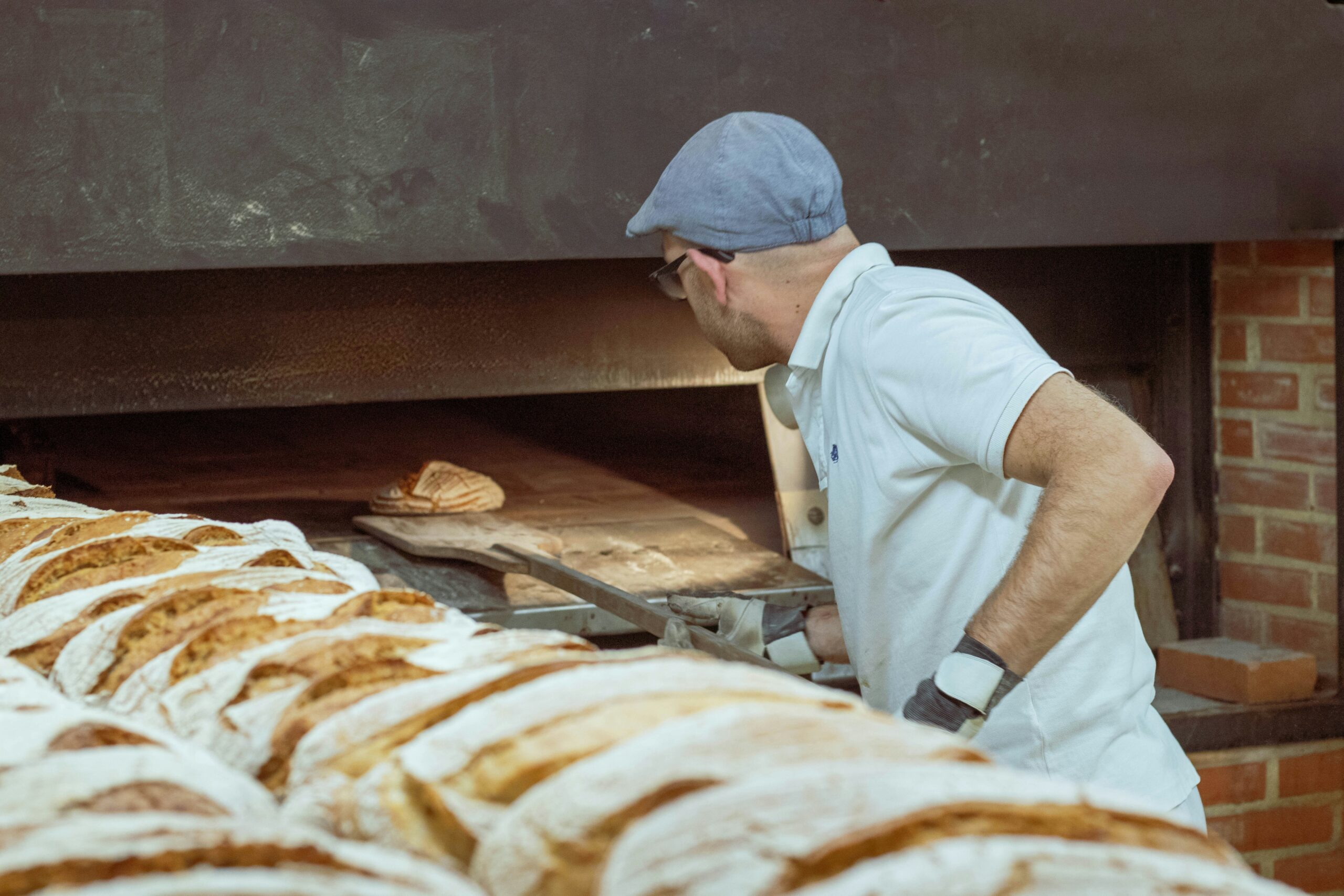
Planning the best way forward for your new restaurant can be a daunting task. Whether you’re living the dream of opening your own restaurant or reworking your existing concept, a restaurant business plan template takes a ton of stress out of writing a business plan.
In this article, we walk you through how to create a restaurant business plan so you’re not stranded in a quagmire of confusing priorities and too many ideas. Even better, we’ve created a free restaurant business plan template to form the operational foundation as you put one together! As you follow through our guide, feel free to download, customize, and reference our template to help you put your restaurant on the path to success.
To start, let’s go through all the ways a written business plan helps shape your restaurant, and why it boosts your business’s chance of success.
What is a restaurant business plan?
A restaurant business plan is a written document that lays out an overview of a restaurant, its objectives, and its plans for achieving its goals.
A business plan is a necessary tool for restaurants of all kinds and sizes. It can be a handful of pages long or much more detailed. A well-written restaurant business plan not only helps you organize your ideas, it’s also a key part of getting investor funding .
Why you need a business plan.
Creatively, opening a new restaurant can be incredibly exciting. But it’s also super complicated. From licenses to equipment to building a team, each phase needs a lot of attention to detail.
Before you jump in, it’s important to shape your plan of attack, organizing your business ideas into a clear, concise narrative that an outsider could easily understand. A business plan is an essential part of this, as it helps you:
Set short- and long-term goals.
A restaurant business plan not only shows how your business will operate in its early stages—it also shows what steps it’ll need to follow as time goes by. Setting both your short and long-term goals at the outset makes you more likely to achieve them. Short-term goals may include meeting current staffing needs, while long-term goals may include five-year growth forecasts and the steps involved to get there.
Understand your resource needs.
Going through the exercise of writing a restaurant business plan is as important as having the finished document in front of you. As you organize your thoughts, your resource needs—from the amount of capital you need to raise all the way down to the equipment you need to find—will take shape.
Reduce potential risks.
Sadly, some 60% of restaurants fail within the first year of opening. One of the main reasons? A failure to plan. Your business plan will help you plan for most challenges at your restaurant before they come up, keeping you on the right side of that number.
Some of the risks your restaurant faces might include:
- Crowded market. One key component of your business plan is conducting market research. How will you ensure your restaurant stands out?
- Supply chain issues. Especially if your eye is toward growth, you need to know how to affordably, reliably, and sustainably keep your restaurant stocked—long-term. Why not track supply strategies as part of your business plan?
- Health and safety. Are you compliant with health regulations? How will you know? Your business plan is one great place to outline compliance protocols, keeping you and your team informed.
Develop a marketing strategy.
As you do your market analysis and figure out your ideal customer, the ways you’ll promote your business will get clearer. The more specific you are with your market research, the easier and more effective your marketing efforts will be.
Build your team.
Your business plan helps you see who you’ll need on your team and which roles you’ll need to fill first . For investors, your business plan is a document showcasing everyone’s collective experience, personalizing your restaurant in their eyes and packing a professional punch. This can include everyone from your head chef to your star hostess. Make it clear how you’re filling your hospitality niche!
Share your vision.
Whether you’re using your business plan to secure startup funding or need additional capital after you’ve already opened, your restaurant business plan shows an investor or lender exactly why they should get behind you. Your business plan should detail where you began (or hope to begin), where you are now, and where you intend to go—as well as how.
The 9 elements of a strong restaurant business plan.
Your restaurant business plan will be unique to your restaurant’s vision. But all good business plans hit standard points, and whoever reads yours will expect to see certain elements. As you develop and finalize your ideas, here are nine key elements your business plan should include.
1. Executive summary
A strong restaurant business plan begins with a strong executive summary. This is a sharp, concise overview of your restaurant—and your best opportunity to grab people’s attention.
Here’s where you communicate, in a nutshell, what kind of restaurant you want to run. Which demographic will you be targeting? Why is your business something the community wants or needs? Especially if you’re asking for financing, include a snapshot of your financial information and growth plan as well.
Your executive summary should briefly lay out:
- Your mission statement. Why are you starting this restaurant now, in this location?
- Your idea. What’s the concept of this restaurant?
- Your plan of execution. What are your key steps to making this concept work?
- Your potential costs. What are your expected expenses?
- Your anticipated ROI. How much do you expect your restaurant to make?
Many investors will make a split-second decision off of the executive summary alone. It might be all they’re going to read, so make every word count.
2. Company description
Now it’s time to let your creativity out and give your restaurant concept life. Give a more detailed description of your concept that lets your passion for what you’re creating come through.
Flesh out all the other details of your proposed restaurant, including your restaurant’s:
- Style of cuisine
- Any unique selling points or differentiators that will make customers choose you—for instance, aesthetic or celebrity chef
- Service style
- Restaurant name (or at least ideas)
- Size, seating style, and capacity
- Location ideas— or the location you’ve scouted or secured
- Ambiance ideas, including décor, lighting, and music
- Operating hours
- Other service offerings, like whether you’ll offer delivery or takeout, delivery guarantees, catering, and any retail products you plan to sell
- Legal structure (e.g., sole proprietorship, LLC)
- Existing management and their roles, including yours
- Experts or advisors you’ve brought on board
3. Market analysis
Present the research you’ve done on your target market. Make a couple of buyer personas to represent your future customers, explaining:
- Where your target customers live
- Their income levels
- Their dining-out and/or ordering-in pain points (e.g., lack of late opening hours, lack of family friendliness)
- How often they dine out or order in
Go through which other restaurants already have a customer base in your area, then explain why people will choose your restaurant over others.
4. Sample menu
Even at the business plan stage, menu engineering is crucial. The specific menu items you’re likely to serve—the biggest thing that will set you apart—should shine through with descriptions that are short, clear, and evocative. If you have an executive chef already, this is a great area for them to add input.
Use language that will get people excited about trying your offerings. Hire a designer or use an online program to create your own mockup using the same colors, fonts, and design elements as the rest of your branding.
5. Business structure
Dive deeper into your business structure (sole proprietorship, partnership, LLC, etc.) and organizational management. Show what your different employee positions will be (co-founders, managers, servers) to give a sense of your team’s makeup. An organizational chart can be helpful here.
Investors won’t expect you to have your entire team on board at this stage, but you should have at least a couple of people firmed up. For the roles that are already filled, including your own, summarize your collective experience and achievements. Bullet points work well, or some people choose to go into more detail with full resumes for the executive team or critical team members.
6. Restaurant design and location
Long before you sign a lease, make sure that your new offering will outshine existing ones nearby. In this section of your business plan, explain why your chosen location, or the ones you’re narrowing down, are going to be an effective space for your target market.
Consider things like:
- Neighborhood demographics
- Foot traffic
- Labor costs
- Accessibility
Hand in hand with location, your restaurant’s interior design—both in its floor plan and its ambiance—is also crucial to your business’s viability. Come up with a captivating restaurant design that communicates your theme and matches your cuisine, creating a memorable customer experience. Decide how many tables you’ll be serving, and plan out any outdoor seating.
Touch on things like:
- Team uniforms
- Flatware and glassware
7. Marketing strategy
How do you plan to market your restaurant? Your plan for grabbing customers’ attention is vital to getting diners through the door, especially at the beginning before word-of-mouth advertising has taken off.
What kind of offers will you provide? Will you have promotional events, direct mail, or a social media strategy ? Go through your planned marketing campaigns and explain how each of them will help secure your target market.
| Overwhelmed by the thought of marketing your restaurant? Check out our top 9 . |
8. Takeout and delivery options
If you’ve decided to have takeout and delivery at your restaurant—pretty important for most target markets—decide whether you’ll use your own drivers or a professional fleet like Uber Eats or DoorDash.
Show how you’ll provide the smooth digital experience your customers will expect. Decide if and how your website will come into play, bearing in mind that in 2023, 40% of consumers preferred to order directly from the restaurant website .
9. Financial projections
Your restaurant’s projected budget need to be solid, especially if you’re using your business plan to get startup funds. Without a budget, investors have no way of knowing if your business is a good investment or when it will become profitable.
One way to make sure your projections are rock solid is to hire an experienced accountant with expertise in running restaurants. Make sure you’re keeping track of market research, planned costs , and projected income. Show how investor funds will be used and whether you’ll be putting up collateral to get a loan. You’ll also score bonus points with a sales forecast for the next five years. Make sure to include a break-even analysis!
One free restaurant business plan template, coming up.
As the team behind Homebase , we know how much there is to consider when you’re starting a new restaurant. We’re proud to be an all-in-one partner for thousands of restaurants large and small—helping make everything from staffing, to scheduling, to team communication easier for business owners.
And we know that your restaurant business plan is a high-stakes document. That’s why we created our free restaurant business plan template to make sure nothing gets overlooked.
Check out our free, downloadable template to get your ideas into shape, get started on your restaurant journey—and get investors excited to jump on board with you.
Download your restaurant business plan template for free: Restaurant business plan + free template PDF
Stop chasing down phone numbers with our built-in team communication tool. Message teammates, share updates, and swap shifts — all from the Homebase app.
Restaurant business plan template FAQs
What is the basic planning document for a successful restaurant.
The basic planning document for successful restaurants is a restaurant business plan. A restaurant business plan lays out a restaurant’s long and short-term goals and its plans for achieving those goals. Restaurant planners use it both to finetune their ideas and to secure investor funding.
How to write a restaurant business plan.
When writing a restaurant business plan, include an executive summary, a detailed restaurant description, market analysis research, a sample menu, a breakdown of your business structure, the design and location of your restaurant, your planned takeout and delivery options, your marketing strategy, and your financial projections.
What makes a business plan template for restaurants different from a standard business plan?
A restaurant business plan template differs from a standard business plan by including things like menu engineering, interior design, kitchen operations, front-of-house management, takeout and delivery offerings, and location analysis, which are unique to the food service industry.
Remember: This is not legal advice. If you have questions about your particular situation, please consult a lawyer, CPA, or other appropriate professional advisor or agency.
Related posts
July 3, 2024
Your go-to checklist for starting a small business (+ free download!)
Maybe it all started with your EZ bake oven marketing plan, and it’s been your long-time dream to start a…
June 29, 2024
Writing an Effective One-Page Business Plan: What You Need to Know (+ Free Template)
If you’ve started—or are starting—a small business, you’ve probably heard the words ‘business plan’ thrown around. That’s because a business…
June 26, 2024
How to Start a Construction Business in 8 Easy Steps
Being able to build something from the ground up is an incredible skill: a skill you can monetize into your…
Top 4 Strategies to Grow Your Construction Business
For those in the construction business, laying the foundation for a house can be a piece of cake. But what…
How to Start a Retail Business: A Beginner’s Guide
So, you want to start a retail business. What now? There’s the idea, the products, the space, taxes, the employees,…
How to Start a Cleaning Business in 6 Steps
So you want to start a cleaning business. You want to work for yourself, you love a good Mr. Clean…
Subscribe to our newsletter
Looking for ways to stay up to date on employment laws and small business news?
Homebase makes managing hourly work easier for over 100,000 local businesses. With free employee scheduling , time tracking , and team communication , managers and employees can spend less time on paperwork and more time on growing their business.
- Hiring & onboarding
- Team communication
- Employee happiness
- HR & compliance
- Integrations
- Food & beverage
- Beauty & wellness
- Medical & veterinary
- Home & repair
- Hospitality & leisure
- Education & caregiving
- Contact sales
- Become a Partner
- Careers – We’re hiring!
- #realtalk Blog
How to Write a Business Plan: Your Step-by-Step Guide

So, you’ve got an idea and you want to start a business —great! Before you do anything else, like seek funding or build out a team, you'll need to know how to write a business plan. This plan will serve as the foundation of your company while also giving investors and future employees a clear idea of your purpose.
Below, Lauren Cobello, Founder and CEO of Leverage with Media PR , gives her best advice on how to make a business plan for your company.
Build your dream business with the help of a high-paying job—browse open jobs on The Muse »
What is a business plan, and when do you need one?
According to Cobello, a business plan is a document that contains the mission of the business and a brief overview of it, as well as the objectives, strategies, and financial plans of the founder. A business plan comes into play very early on in the process of starting a company—more or less before you do anything else.
“You should start a company with a business plan in mind—especially if you plan to get funding for the company,” Cobello says. “You’re going to need it.”
Whether that funding comes from a loan, an investor, or crowdsourcing, a business plan is imperative to secure the capital, says the U.S. Small Business Administration . Anyone who’s considering giving you money is going to want to review your business plan before doing so. That means before you head into any meeting, make sure you have physical copies of your business plan to share.
Different types of business plans
The four main types of business plans are:
Startup Business Plans
Internal business plans, strategic business plans, one-page business plans.
Let's break down each one:
If you're wondering how to write a business plan for a startup, Cobello has advice for you. Startup business plans are the most common type, she says, and they are a critical tool for new business ventures that want funding. A startup is defined as a company that’s in its first stages of operations, founded by an entrepreneur who has a product or service idea.
Most startups begin with very little money, so they need a strong business plan to convince family, friends, banks, and/or venture capitalists to invest in the new company.
Internal business plans “are for internal use only,” says Cobello. This kind of document is not public-facing, only company-facing, and it contains an outline of the company’s business strategy, financial goals and budgets, and performance data.
Internal business plans aren’t used to secure funding, but rather to set goals and get everyone working there tracking towards them.
As the name implies, strategic business plans are geared more towards strategy and they include an assessment of the current business landscape, notes Jérôme Côté, a Business Advisor at BDC Advisory Services .
Unlike a traditional business plan, Cobello adds, strategic plans include a SWOT analysis (which stands for strengths, weaknesses, opportunities, and threats) and an in-depth action plan for the next six to 12 months. Strategic plans are action-based and take into account the state of the company and the industry in which it exists.
Although a typical business plan falls between 15 to 30 pages, some companies opt for the much shorter One-Page Business Plan. A one-page business plan is a simplified version of the larger business plan, and it focuses on the problem your product or service is solving, the solution (your product), and your business model (how you’ll make money).
A one-page plan is hyper-direct and easy to read, making it an effective tool for businesses of all sizes, at any stage.
How to create a business plan in 7 steps
Every business plan is different, and the steps you take to complete yours will depend on what type and format you choose. That said, if you need a place to start and appreciate a roadmap, here’s what Cobello recommends:
1. Conduct your research
Before writing your business plan, you’ll want to do a thorough investigation of what’s out there. Who will be the competitors for your product or service? Who is included in the target market? What industry trends are you capitalizing on, or rebuking? You want to figure out where you sit in the market and what your company’s value propositions are. What makes you different—and better?
2. Define your purpose for the business plan
The purpose of your business plan will determine which kind of plan you choose to create. Are you trying to drum up funding, or get the company employees focused on specific goals? (For the former, you’d want a startup business plan, while an internal plan would satisfy the latter.) Also, consider your audience. An investment firm that sees hundreds of potential business plans a day may prefer to see a one-pager upfront and, if they’re interested, a longer plan later.
3. Write your company description
Every business plan needs a company description—aka a summary of the company’s purpose, what they do/offer, and what makes it unique. Company descriptions should be clear and concise, avoiding the use of jargon, Cobello says. Ideally, descriptions should be a few paragraphs at most.
4. Explain and show how the company will make money
A business plan should be centered around the company’s goals, and it should clearly explain how the company will generate revenue. To do this, Cobello recommends using actual numbers and details, as opposed to just projections.
For instance, if the company is already making money, show how much and at what cost (e.g. what was the net profit). If it hasn’t generated revenue yet, outline the plan for how it will—including what the product/service will cost to produce and how much it will cost the consumer.
5. Outline your marketing strategy
How will you promote the business? Through what channels will you be promoting it? How are you going to reach and appeal to your target market? The more specific and thorough you can be with your plans here, the better, Cobello says.
6. Explain how you’ll spend your funding
What will you do with the money you raise? What are the first steps you plan to take? As a founder, you want to instill confidence in your investors and show them that the instant you receive their money, you’ll be taking smart actions that grow the company.
7. Include supporting documents
Creating a business plan is in some ways akin to building a legal case, but for your business. “You want to tell a story, and to be as thorough as possible, while keeping your plan succinct, clear, interesting, and visually appealing,” Cobello says. “Supporting documents could include financial projects, a competitive analysis of the market you’re entering into, and even any licenses, patents, or permits you’ve secured.”
A business plan is an individualized document—it’s ultimately up to you what information to include and what story you tell. But above all, Cobello says, your business plan should have a clear focus and goal in mind, because everything else will build off this cornerstone.
“Many people don’t realize how important business plans are for the health of their company,” she says. “Set aside time to make this a priority for your business, and make sure to keep it updated as you grow.”
More From Forbes
How hero bread raises $21 million in less than 90 days to accelerate its low-carb artisanal bakery business.
- Share to Facebook
- Share to Twitter
- Share to Linkedin
Hero Bread raises $21 million in fresh funding to expand its low-carb bakery business.
Hero Bread, a Californian startup dedicated to producing an artisanal line of low-carb and high nutrition baked goods, has amassed $21 million in latest financing to fuel their product innovation and retail expansion.
This funding round, co-led by Cleveland Avenue, DNS Capital, and Composite Ventures with additional participation from existing investor Greatpoint Ventures, is set to accelerate the company’s mission of delivering nutrient-rich bread to a wider audience. PitchBook showed Hero Bread previously raised a $15 million series B back in 2023, putting its post-money valuation at $155 million.
Bringing Low-Carb Foods To Mass Audience
Founded in 2021 by Cole Glass, who was born with severe food allergies related to pollen and had a strict diet without vegetables, fruits, or nuts, Hero Bread first entered the market at select Subway restaurants. It quickly went viral with early backing from athletes Tom Brady and Kevin Durant, as well as recording artists, including The Weekend.
Hero Bread’s current offerings, including French Croissants, Buttery Cheese Biscuits, Hawaiian Rolls White & Seeded Bread, Burger & Hot Dog Buns and Tortillas, are sold direct-to-consumer via the company's website, as well as across over 4,000 retailers, including Publix, Sprouts Farmers Market, Albertsons, Safeway, QFC, Market District, Giant Eagle, Heinen’s, Central Market, Woodman’s and Fresh Thyme.
According to Hero Bread’s CEO YuChiang Cheng, the company was able to close the round in less than 90 days thanks to its proven consumer demand, increasing distribution that resulted in an uptick in investor interest.
Best High-Yield Savings Accounts Of 2024
Best 5% interest savings accounts of 2024.
“The fundraise was a focused effort where we reached out to over 20 qualified leading CPG investors who have a proven desire to invest in impact CPG companies. We got a lot of interest… but Composite Ventures who has been following us closely moved very quickly and rallied Cleveland Avenue, DNS, and GreatPoint Ventures,” Cheng wrote me via email.
“This new funding empowers Hero Bread to fulfill its mission to bring high nutritional baked goods to all consumers by building out more national distribution, support growing its current retail partners with creative promotions and sampling, while continuing to invest in new product innovation.”
Leveraging Resistant Wheat Starch
Bread, alongside many major carbohydrate-rich foods, has been at the center of reinvention among low-carb and keto-focused brands, notably BetterBrand and Sola. Heavyweights in the category, such as Flowers Foods and Bimbo Bakeries, have also forayed into the keto-friendly space recently.
The secret for Hero Bread to achieving minimal to zero net carb is using resistant wheat starch, a dietary fiber that cannot be fully broken down and digested, compared to regular wheat starch containing high net carbs that turn into sugars absorbed by the body during digestion, according to information provided through the company’s website.
Cheng stressed how it took three years for Hero Bread to prefect its formulation, and the company will continue iterating its products. “Our test kitchen is a former restaurant, and we really bake all of the products you buy,” he said. “We are on a continuous improvement journey to deliver the best product we can. This means improving what we bake with: for example, removing seed oils and now using heart-healthy olive oil, how we bake and with which partners. Over the last few years our team has worked extremely hard to build a strong manufacturing system which will support our rapid growth, in terms of capacity, quality and sustainable unit economics.”
Hero Bread’s sales have more than doubled every year since its launch, and plans to explore all categories that are rich in carbohydrates moving forward, according to Cheng.
“We are very committed to our omni-channel approach. We will continue to show strong unit sales velocity growth at our current retail partners and also open a lot more retail doors in 2024 to make sure we can bring our bread to consumers where they like to shop,” said Cheng. “We will easily double sales year over year. Our strategy is simple, we are very focused on making the best product we can, help people be healthy by getting our bread in their hands and continue to build a healthy valuable business.”

- Editorial Standards
- Reprints & Permissions
Join The Conversation
One Community. Many Voices. Create a free account to share your thoughts.
Forbes Community Guidelines
Our community is about connecting people through open and thoughtful conversations. We want our readers to share their views and exchange ideas and facts in a safe space.
In order to do so, please follow the posting rules in our site's Terms of Service. We've summarized some of those key rules below. Simply put, keep it civil.
Your post will be rejected if we notice that it seems to contain:
- False or intentionally out-of-context or misleading information
- Insults, profanity, incoherent, obscene or inflammatory language or threats of any kind
- Attacks on the identity of other commenters or the article's author
- Content that otherwise violates our site's terms.
User accounts will be blocked if we notice or believe that users are engaged in:
- Continuous attempts to re-post comments that have been previously moderated/rejected
- Racist, sexist, homophobic or other discriminatory comments
- Attempts or tactics that put the site security at risk
- Actions that otherwise violate our site's terms.
So, how can you be a power user?
- Stay on topic and share your insights
- Feel free to be clear and thoughtful to get your point across
- ‘Like’ or ‘Dislike’ to show your point of view.
- Protect your community.
- Use the report tool to alert us when someone breaks the rules.
Thanks for reading our community guidelines. Please read the full list of posting rules found in our site's Terms of Service.
Select Region or Brand
- New Orleans, LA
- Long Island, NY
- Oklahoma City, OK
- Rochester, NY
- Lehigh Valley, PA
- Mecklenburg, NC
- South Carolina
- Columbia, SC
- Charleston, SC
- Greenville, SC
- Color Magazine
- Massachusetts
- North Carolina
- Rhode Island
- Milwaukee, WI
- Designers Today
- Furniture Today
- Gifts & Decorative Accessories
- Home Accents Today
- Home Furnishings News
- Home Textiles Today
- Manage Print or Online Subscription
- Manage Email Subscription
Upcoming Event
Women’s Leadership Summit
- Leads & Data Center
- About Leads & Data Center
- Add My Business
- Contact Leads & Data Center
- Classifieds
- Free eGuide
- Advertising & Marketing Tips
- Editorial and Special Products Calendar
- Advertising in Economic Uncertainty – A Marketing Guide
- BTM Business Connect
- Movers & Shakers
- Food Business
- Law & Government
Real Estate
- Priciest Home Sales
- Small Business
- Reader Rankings
- Editors Picks
- Influencer Lists
- Influencer Recommendation Form
- Special Publications
- Digital Edition
- 30 Under Thirty
- 40 Under Forty
- Best Places to Work
- Leaders in Business & Finance Awards
- Corporate Citizenship & State of the Not-For-Profit
- Diversity in Business Awards
- Empowering Women
- Executive Circle Awards
- Hall of Fame
- Healthcare Forum
- Leaders in Law
- Real Estate, Architecture & Engineering
- Top 50 Women in Business
- Women’s Leadership Summit
- Advertise With LIBN
- Print Advertising
- Event Advertising
- Classified Advertising
- Plaques & Permissions
- Event Calendar
- Networking Events
- Editorial Calendar
- Digital Edition Archives
- Special Pub Archives
- Leads & Data
- Back Issues
Developer unveils new plan for shuttered Sayville golf course
David Winzelberg // July 5, 2024 //

A rendering of South Bay Village. / Courtesy of Rechler Equity Partners
Share this!
Related Content

Gains continue for Long Island construction employment
Nassau and Suffolk counties gained 2,500 construction jobs from May 2023 to May 2024, a 3 percent year-over-y[...]
July 5, 2024

Change of plans: converting Long Island’s office buildings into other uses
Long Island’s healthy supply of office buildings was once an attractive feature of its commercial real estat[...]

Feil completes reboot of its Garden City office property
Improvements at the 200,000-square-foot office complex included a full redevelopment of the common areas and e[...]
July 3, 2024

Brookhaven IDA closes on incentives for East Patchogue apartments
The $46.7 million project called Greybarn Patchogue will bring 91 apartments to a 3.4-acre site.

Chipotle and Panera Bread coming to new Islandia development
Both of the new Chipotle and Panera Bread restaurants will feature drive-thru windows.
July 2, 2024

Grand opening for first phase of new Farmingville rental community
The first phase of The Arboretum at Farmingville brings 292 residences to a 62-acre site.
Sponsored Content
Uncategorized.

Food & Beverage Manufacturers and Distributors Dri...
In this economic environment, with rising costs and risks, effective profitabili[...]

Why mid-sized regional banks are winning in today’s fast-paced economy
Personalized attention or advanced financial solutions? When it comes to picking[...]

Why Improving Energy Efficiency Should Be One of Your First Steps to Building Decarbonization
New buildings are required to be all-electric – starting in 2026 for structure[...]
LIBN Daily Newsletter
Sign up for your daily digest of Long Island Business News.
- By signing up you agree to our
- Privacy Policy
Editor’s Picks

Long Island Business News announces Emerging Leaders Under 30
Listen to this article Long Island Business News has announced this year’s winners of the *Emergin[...]

Introducing Long Island Business Influencers: Dynamic Women Leaders List 2024
In this special section, “Long Island Business Influencers: Most Dynamic Women 2024,” you’ll n[...]

Introducing BTM Business Connect: a new format for press releases
Listen to this article We are pleased to introduce our new BTM Business Connect program that will al[...]

Long Island Business News announces 2024 Empowering Women Awards
Listen to this article Long Island Business News has announced the recipients of the 2024 Empowering[...]

Mergers and Acquisitions 2024
In 2024, Merger & Acquisition activity has surged and is projected to maintain a robust pace, with a[...]

Nassau and Suffolk counties gained 2,500 construction jobs from May 2023 to May 2024, a 3 percent y[...]

The revised plan for the community to be called South Bay Village would have 890 residences.

Long Island’s healthy supply of office buildings was once an attractive feature of its commercial [...]

Improvements at the 200,000-square-foot office complex included a full redevelopment of the common a[...]

Weekly Edition
Burke-Gonzalez: The first in New York to harness the power of offshore wind
Baca: Proposed rules would increase HVAC costs in New York
On Our Island 7/5/2024
Liebman: Realpolitik and the rails: A realistic appraisal of what killed congest[...]
Privacy Overview

IMAGES
VIDEO
COMMENTS
Bread Bakery BUSINESS PLAN Photo by: Alaettin YILDIRIM. BREADCRAFTER 8900 Green Lake Road Port Hanover, Michigan, 49333 This business plan is a tightly constructed, succinct consideration of all factors relevant to launching this bakery. From rent charges to competition and seasonal changes to costs per loaf, this plan hasn't left anything out ...
Bakery Business Plan. You've come to the right place to create a successful bakery business plan. We have helped over 100,000 entrepreneurs and business owners create business plans and many have used them to start or grow their bakeries. A bakery business plan is a plan to start and/or grow your bakery.
Our bakery business plan is designed to encompass all crucial elements required for a thorough strategic approach. It details the bakery's operations, marketing strategy, market environment, competitors, management team, and financial projections, ensuring a holistic view of the business's path to success. Executive Summary: Offers an ...
5. Write a Bread Business Plan. All bread business owners should develop a business plan. A business plan is a document that outlines the goals, strategies, and operations of a business. It can be used to secure funding from investors or lenders, as well as to guide the day-to-day operations of the business.
Bakery Plan Executive Summary. As the first section of your business plan, the executive summary is your prime opportunity to make a great impression with a concise summary of your bakery's concept. An executive summary introduces key elements of your business plan like an overview of the budget, the business's mission, market, and core values.
01. Executive summary. An executive summary is a concise and compelling overview of your bakery business plan, designed to capture the reader's attention and provide a snapshot of the entire plan. This section should be written last (after you've crafted the rest of the plan), to ensure that it accurately reflects the key points and highlights ...
1. Executive summary. The executive summary section of your bakery business plan summarizes the document and its contents. Remember, this is meant to highlight what's to come in your business plan, not serve as a summary of your business idea. Focus on your business's core strength to draw in your reader.
What You'll Get with This Free Bakery Business Plan Template: A business plan template for a bakery that can be edited in Word or Pages. Tips, tricks, and instructions to help you create a winning business plan for your bakery. 8 customizable sections, including an executive summary, market analysis, and operations plan.
2. Company Overview and Description. The first step in writing a bakery business plan is to compose a company overview of your business. The overview should explain why you want to open a bakery, so you can show your financial source that you're passionate about the business you want to start. While a bakery may sound self-explanatory, use ...
With a well-prepared business plan in hand, you can confidently pursue your dream of owning and operating a successful bread bakery. Executive Summary. In your bread bakery business plan, the executive summary is a concise overview of your bakery business and its goals. It provides readers with an understanding of your bakery's mission ...
Check out these sample bakery business plans and get inspired to start building your own bakery today. You can also read our comprehensive guide on how to write a bakery business plan. Explore our library of Bakery Business Plan Templates and find inspiration for your own business.
7. Financial Analysis and Projections. For the last section of your bakery business plan, you will focus on the financial projections for your business. You'll outline the potential costs for ingredients, equipment, technology, bills, and salaries that will keep your bakery running.
Industry Analysis. The Bend, Oregon home-based bakery industry is a booming sector that has seen significant growth in the last three years. According to figures released by the Oregon Department of Agriculture, retail bakeries generated over $200 million in sales in 2019 alone, up 8.3% from 2018.
1) Gain practical experience. Learning how to start a bakery and writing a bakery business plan are two very unique and specialized activities. Unlike, say, mowing lawns, owning and operating a successful bakery takes a lot of knowledge, experience, and skill. Before you bake your first loaf for profit, get as much practical experience as possible.
6. Bakery store design and layout. An effective bakery business plan must include a blueprint of your bakery shop's layout and design to demonstrate the bakery's concept practically to the readers. Mention your bakery size and the space allocated for the back of the house and front of the house operations.
Sample from Growthink's Ultimate Bakery Business Plan Template: The following industry statistics bode well for [Company Name]. According to the recent report entitled, "Retail Bakeries Industry in the U.S." by Supplier Relations US, LLC, the retail bakery industry's annual revenue is approximately $3.6 billion, with an estimated gross ...
Step 4: Regularly Review and Update Your Plan. A bakery business plan is a dynamic document that should be regularly reviewed and updated. In the initial months of operating your bakery, review and update your plan frequently to reflect any changes, refine calculations, and adjust assumptions.
What is a bread bakery business plan? A bread bakery business plan is a strategic document that a business person would write in order to construct their very own business. A bread bakery type of business. The business plan consists of the strategies, the milestones, the executive summary, and the description just to name a few.
To start a bread bakery business, you may need $10000 - $50000. It depends on the size of the bakery and the bread that you want to offer. Before you rush to start a bread bakery business, you must know that you have to create a business plan first. It will guide you so that you will commit no mistake in your business.
Startup expenses of $64K including $3K legal, $20K location premises renovation, $40K expensed equipment, and $1K other. These show up as negative retained earnings in the initial balance because they are incurred before launch. Starting cash in the bank of $70K. (in initial balance) Other current assets of $12K (in initial balance)
Bakery Business Plan. If you want to start a bakery or expand your current bakery, you need a business plan. The following sample bakery business plan gives you the key elements to include in a winning business plan. It can be used to create a business plan for a dessert bakery, bread bakery, cake bakery, and other businesses that sell baked goods.
Bread Making Manufacturing Process. The bread-making process is broadly divided into 6 different steps. The first step is to mix the various ingredients. Major ingredients include enzymes, starch, and yeast. The second step is rising or fermenting. Once the mixture is fermented properly, you need to knead.
A business plan doesn't have to be complex or too elaborate, just something to keep your eyes on the big picture. The business plan will allow you to easily identify the obstacles and anything you may not have considered. ... Ignorance in the bread bakery business is likely to open you up to financial losses and eventual failure. 3. Choose a ...
A business plan is an essential part of this, as it helps you: Set short- and long-term goals. A restaurant business plan not only shows how your business will operate in its early stages—it also shows what steps it'll need to follow as time goes by. Setting both your short and long-term goals at the outset makes you more likely to achieve ...
A one-page business plan is a simplified version of the larger business plan, and it focuses on the problem your product or service is solving, the solution (your product), and your business model (how you'll make money). A one-page plan is hyper-direct and easy to read, making it an effective tool for businesses of all sizes, at any stage ...
Hero Bread raises $21 million in fresh funding to expand its low-carb bakery business. Hero Bread. Hero Bread, a Californian startup dedicated to producing an artisanal line of low-carb and high ...
The new plan from the Plainview-based developer is a scaled-back version with 35 percent less density than its original 2017 proposal for 1,365 apartments in 27 buildings that was to be dubbed ...